You are using an outdated browser. Please upgrade your browser or activate Google Chrome Frame to improve your experience.

- Trip Styles
- Destinations
- Visiting Grand Canyon in January

- Grand Canyon Visitor Guide

January in the Grand Canyon
Learn all about what it means to visit Grand Canyon National Park in January
Updated: 09/09/22
Winter in Grand Canyon National Park is a magical time to be there. There are some wonderful benefits to visiting this time of year and some drawbacks as well. If January is the month you can make it happen, then our recommendation is to go for it! You’ll have an amazing time, and will almost assuredly leave with an appreciation of not just the Canyon, but also visiting the Canyon this time of year.
Top Rated Grand Canyon Hiking Tours
Benefits of visiting in January
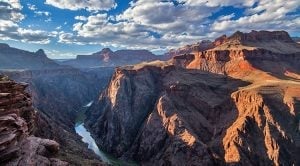
Another big benefit is the cool temperatures in the Canyon. While the South Rim may be quite chilly (but not always), once you’re down into the Canyon the temperatures will level out and much of the time be perfect for hiking. This is a blessed relief from the 110° or more heat in the canyon in the summer that makes hiking dangerous and less enjoyable. Make sure you’re still prepared for winter weather though, as you won’t be able to reach the milder desert temperatures on the floor of the canyon until you journey through the mountainous, forested terrain of the South Rim. Permits for back-country hiking and camping are much easier to obtain in the winter, and even last-minute reservations at Phantom Ranch are commonly available. Wildlife viewing and photography opportunities abound in winter. While many of the animals slow down because of the cold, you might still see mule deer and elk, as well as condors, big-horn sheep, foxes, and bobcats. The canyon itself is majestic and worthy of pictures any time of the year, but if there has been recent snow, the crimson and blood orange rocks just edged with white take on an entirely unique look.
Drawbacks of Visiting in January
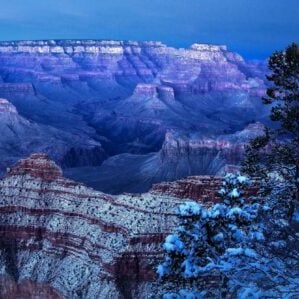
Winters in Grand Canyon are not to be laughed at, despite the park’s reputation for heat instead of cold. Hypothermia is a real danger and slipping on ice and snow can cause serious injury. When a snowstorm does hit, it can close roads, make hiking very difficult, and generally bring activities in the canyon to a screeching halt. In addition to the possibility of adverse weather, many of the trails of the South Rim become treacherously icy in winter regardless of whether or not there’s snow, and it’s strongly recommended to use hiking crampons and trekking poles if you hike in January. This makes the trails less accessible as this equipment can be expensive and those who are not steady on their feet may not want to attempt hiking even with the increased traction this gear will give them.
The North Rim is also closed from early November through mid-May, so the South Rim is your only option. This leaves much of the park mostly inaccessible and limits what you can see. While the South Rim is gorgeous and by far worth visiting, many people feel as though they have missed out if they don’t get to see the North Rim. While wildlife is still around in January, many of the species have slowed down because of the cold. You won’t get a chance to see any reptiles or amphibians and some of the larger animals will be less active and thus less visible. An additional drawback is that not only will the days be colder, but they will also be shorter than in the summer. The temperature drops sharply after the sun goes down and you do not want to be caught out after dark, so you will have less time when there is sunlight and the air is warm enough to enjoy hikes and sightseeing.
Things to Do in January
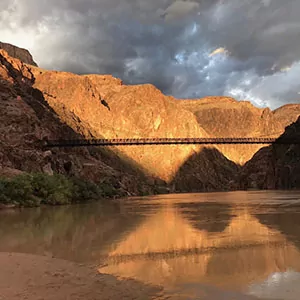
Sightseeing in the park is endless. If the roads are clear, you can drive along the rim of the canyon and stop at various overlooks. The most spectacular is in the west between the visitor center and Hermit’s Rest, but the east and south provide some amazing views as well. Helicopter or airplane tours, van tours, and – if roads are clear – bicycle tours are great activities (read about Grand Canyon’s best tours for links to recommended companies.)
Checking out things like the Yavapai Geology Museum and the Kolb Studio is worth doing if the weather prevents you from being outside. The 22 visitor center film is a great way to learn more about the park from the warmth of a heated building. A trip on the Grand Canyon Railway that runs from Williams to the canyon is also a great way to wait out some of the weather and may include a visit from old western outlaws. On the West Rim, the Grand Canyon skywalk (a bridge made entirely of glass suspended nearly 4000 feet above the canyon floor) or a visit to Eagle Point Native American village are both great options. Guests can also enjoy an all-American dinner at famous and historic El Tovar, which is a must-do activity in Grand Canyon, and reservations will be much easier to get in January than many months.
Wildlife and winter photography are great options for Grand Canyon in January. Although the wildlife will be less active than they are in the summer, patient visitors may still catch glimpses of the park’s iconic animals. The California condor, one of the rarest birds in the world and possessing the largest wingspan of any North American bird, can still be seen flying above the Grand Canyon. With a quality lens for zooming in, the condor makes an excellent photography subject. Night sky photography is also popular, especially if you can get some of the canyon walls in the foreground of your picture of the Milky Way. Make sure to break out your layers and maybe a blanket for being out in the evening though, as the winter nights can get very cold.
Things to see in january
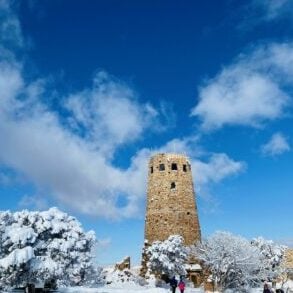
Hermit’s Rest/Scenic Drive: This scenic drive is one of the most popular in the park, but it is popular for a reason. Heading west along the south rim, the drive has many overlooks that give you excellent views of the canyon beneath. Winter is arguably the best time to drive this route as it is the only time that you can. Shuttle buses run in the summer and the only other options are walking or riding your bike as the road is closed to private vehicles with the exception of backpackers with permits. Being able to drive this route gives you the ability to explore at your own pace and to take your time at the overlooks. At the end of the road is Hermit’s Rest, built in the early 1900s but designed to look like an old miner’s cabin.
Plateau Point: This overlook, along the very famous and very popular Bright Angel Trail, is one of the best views of the Colorado River in the park. While during the summer, this trail is packed with visitors, in the winter you will find fewer people but unfortunately more ice and snow. Kaibab Trail has more sun and is less icy, but the Plateau Point is so spectacular that for experienced hikers with crampons and trekking poles, it might be worth it to take the longer trek.
Hopi Point: Along the Hermit’s Rest Scenic Drive, Hopi Point is one of the best places for sunrise or sunset. With sweeping panoramic views of the entire canyon as well as little glimpses of the Colorado River, this spectacular viewpoint is great any time of the year, but with the ability to drive to this point instead of taking the shuttle, January is a perfect time to catch golden hour as the rocks are bathed in the deep orange light of the sun.
Desert View Watchtower: The first thing you see when you enter the park from the east is this watchtower, but few people stop to–and perhaps don’t you can– climb it. Built in 1932 by architect Mary Colter, the tower’s design is made to look as though it is rising out of the canyon itself and is based on the architectural designs of the Ancestral Puebloan people that inhabited the Colorado plateau. Inside, you’ll find a recreation of a Native American Kiva which hosts cultural demonstrations in the summer and outside you’ll find your first spectacular views of the canyon.
EXPLORE GRAND CANYON WITH AWARD WINNING GUIDES

Explore Grand Canyon Trips
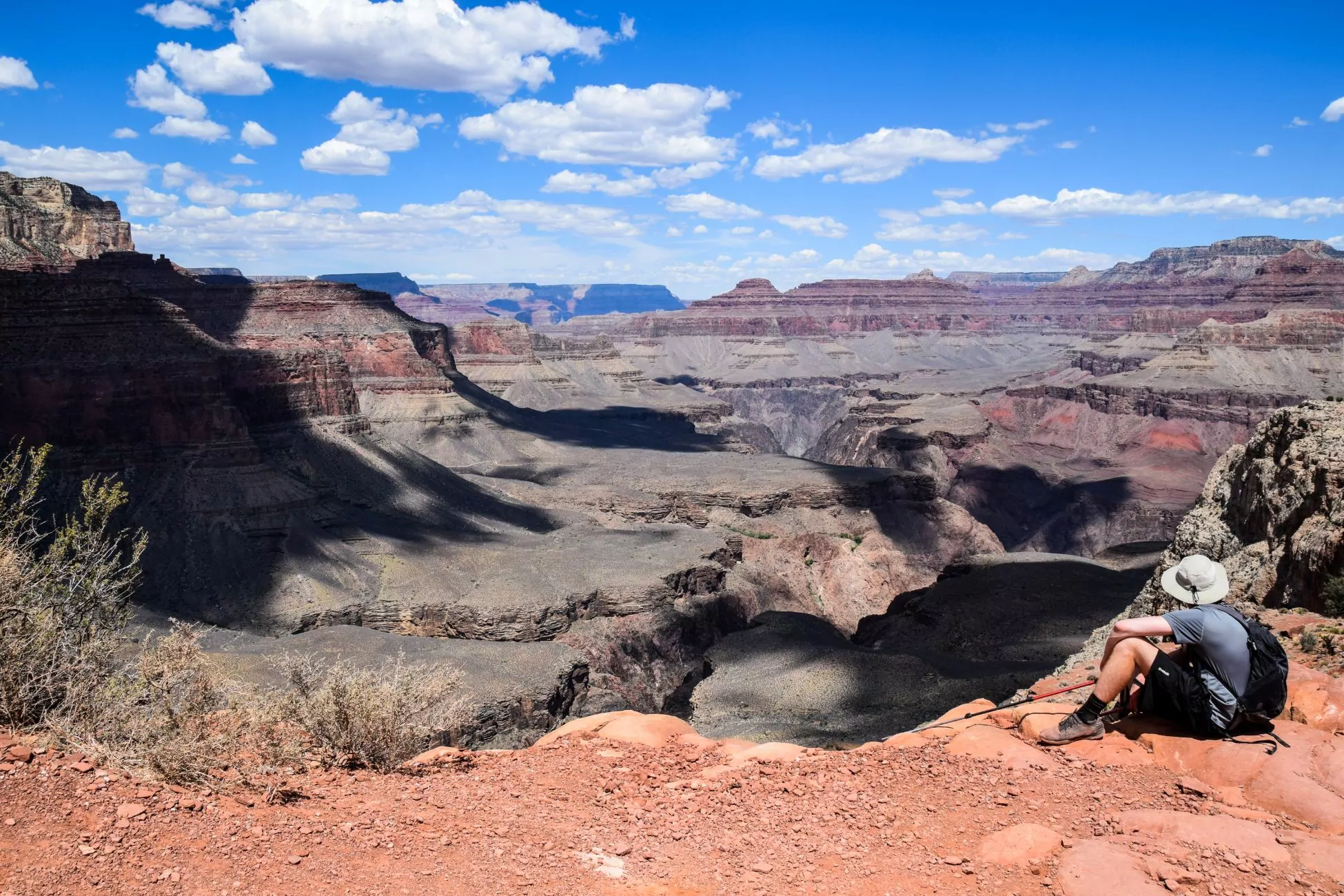
Hiking in January
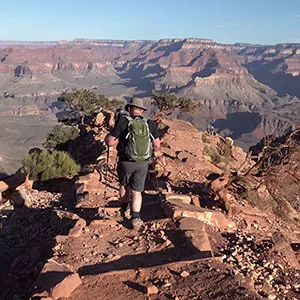
Whatever trail you decide to hike, you will need to bring crampons or Microspikes to give you extra traction on the trail. Much like chains that you put over car tires, microspikes are for your boots and are made up of chains, rubber, and small spikes that dig into ice and compacted snow, giving you increased traction. It only takes a small section of ice to make you thankful that you had these devices. As most of the trails in Grand Canyon are steep, sliding down or slipping while trying to climb up the trails without additional traction on your feet is very likely. While this equipment may seem expensive, especially for a short trip to Grand Canyon, it is critical to have. Tour companies include this in gear if you book a tour with them, which can help reduce your cost.
Early mornings can be very chilly at the South Rim, where the trails begin, so be prepared with warm layers– especially insulating layers– wind-proof outer shells, gloves, and a warm hat. It’s best to start hiking around 8 or 9 am and keep your hike to 6-8 hours due to the shorter days of winter. The temperature drops sharply after dark, and you will not want to be out once the sun has gone down and any ice that has melted during the day begins to refreeze.
Hypothermia is a real danger in the Grand Canyon in the winter and it is important to recognize the signs of this condition and to know what to do if you or one of your group experience this condition. It does not have to be below freezing for you to experience hypothermia; instead, it is when your body is not able to regulate its temperature after being exposed to cold and/or wet conditions. Because hypothermia causes confusion and carelessness, it is difficult to know if you have it yourself, so make sure you’re hiking with a group and that you all know how to prevent this condition. The most important thing is to put on your warm layers before you start shivering and to break out your rain jacket before you get wet. This will prevent you from getting chilled, which can lead to hypothermia. Look for the symptoms of the “umbles”– grumbling, stumbling, mumbling, and fumbling.
Make sure to also be drinking plenty of water on your hike, even though it is cold. It might be best to carry it in an insulated container to keep it from freezing. With a recent increase of deaths in the Canyon due to “water poisoning” — a life-threatening condition caused by an imbalance of sodium in the body which causes cells to swell with water– it is important to also snack frequently while you hike, especially with salty foods to maintain the sodium balance in your bloodstream.
backpacking in january
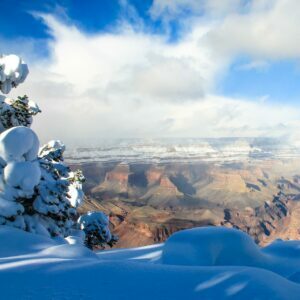
Depending on which trail you take, you’ll either be able to hike in only your hiking boots or have to bring cross-country skis or snowshoes to traverse deep snow. If you want to hike down into the canyon to escape the colder weather and the snow, consider a short trip down the South Kaibab Trail to Bright Angel Campground, one of the most picturesque campgrounds in the park situated near Bright Angel Creek. Explore the canyon around Garden Creek or Havasupai Garden before hiking back up to the South Rim via the Bright Angel Trail or South Kaibab Trail. There are many other options within the canyon, like a trail that goes further west called Hermit Loop , which has stunning sites, great history, and spectacular fossils.
On many backpackers’ bucket lists is a Rim-to-Rim-to-Rim backpacking trip in the Grand Canyon. This means hiking from the South Rim to the North Rim, and back to the South Rim over the span of a few days. This feat can be accomplished in winter, but only with significantly more gear and expertise than in the shoulder seasons. Winter does, however, afford hikers journeying to the North Rim remarkable solitude as the roads to this section of the park are closed and few hikers make this trek in winter. This trail, however, is very strenuous with dramatic elevation loss and gain and serious height exposure.
Besides the dangers of the trail as it is, winter brings additional risk with the rims having all the hazards of winter in the mountains besides crevasses and avalanches: whipping winds, freezing temperatures, and wild snow storms that may drop many feet of snow. Backpackers will need to be aware of these dangers and understand what to do in a survival situation. Test out your winter gear before you rely on it in the backcountry, especially on the North Rim which is one of the most remote places in the lower 48 states. In addition, all the dangers of day hiking are only amplified in the backcountry, so make sure to read the section above if you’re interested in this activity. Backpacking in Grand Canyon in January can be a very rewarding experience with solitude like few other places in the country, so assemble your winter gear and get ready to head out on an adventure.
Wildlife in January
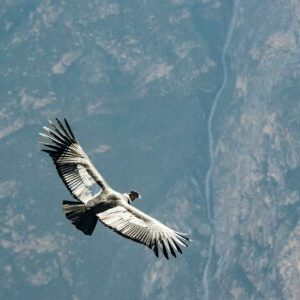
Perhaps the most famous of Grand Canyon’s wildlife is the California condor, recently re-introduced after being on the brink of extinction. The largest bird native to the Americas, the California condor has a wingspan of up to 9.5 ft and can weigh up to 23 pounds. These birds are scavengers and are often confused with turkey vultures while flying. You can tell the difference between these birds by the way they fly: turkey vultures appear to be wobbly when they fly while condors have a much smoother wing pattern. Seemingly a land equivalent of the ocean-going albatross, condors can travel many miles in one day and very seldom roost in the same place for two nights in a row unless they have a nest. A breeding pair of condors may only produce one egg every two years, so their recovery story from the brink of extinction through captive breeding programs and their subsequent release into the wild is a great conservation success story.
Another of Arizona’s distinct wildlife residents is the javelina, also known as the collared peccary. While they go by many common names and look like pigs, javelinas are in a different family than pigs and are known for their tough eating habits which sometimes even include cactus. Grand Canyon National Park is home to hundreds of species, many of which are not often seen by visitors. Bighorn sheep inhabit the park but blend in so well with the rocks they inhabit that they are often not seen. Mountain lions, coyotes, bobcats, and gray foxes also live in this habitat but all of these with the exception of coyotes are generally shy and avoid people. The snow can be an advantage to those looking for wildlife as it maintains tracks better than dirt. While many of these species are less active because of the cold, patient visitors can still catch a glimpse of them and it will be well worth the wait.
Weather in January
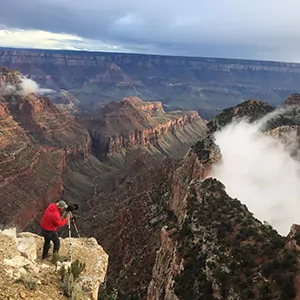
Mornings are typically on the chillier side and the temperature drops sharply after sundown, so you’ll want to make sure your hike or activity doesn’t leave you out in the elements after dark. Plan on starting your activities in the morning if they are going to be longer than a few hours, but make sure to watch out for icy spots with a layer of water on the surface that have been melted in the morning light. This will make the ice more slippery and treacherous. Crampons or Microspikes are a must for this time of year as a slip on ice while hiking along a cliff can quickly turn into a disaster. Cross-country skis or snowshoes will be required for some trails in the area.
Hypothermia is a very real threat in Grand Canyon, so make sure you break out your warm layers before you start shivering, put on your rain/snow gear before you get wet, and turn around or take shelter if the weather turns bad. It is best to be prepared for the worst weather you might encounter, so make sure to dress in layers that you can take off/put on to regulate your temperature as the temperature around you changes. If you only bring your ski jacket, you are going to be too warm most of the time, but too cold if you take it off. Always check the forecast and current conditions before setting out on a hike and check with a ranger at the visitor center for specific information about different trails and roads.
Recommended Wildland trips
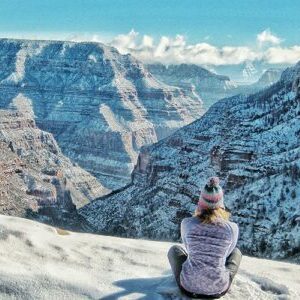
Best of Grand Canyon: Designed for those looking to explore the wonders of the Grand Canyon with the luxuries of hotels in the evening, this trip is the perfect blend of rustic and comfortable. With day hikes each day into the canyon, visits to the notable museums and visitor centers, and a memorable dinner at El Tovar Hotel, this trip will not disappoint. An all-inclusive 3-day tour with local transportation, meals, lodging, and much of your gear included, you won’t want to miss this adventurous yet relaxing trip to Grand Canyon.
Phantom Ranch Tour: While this is also an inn-based tour, it is much nearer to a backpacking trip as you will trek down into the canyon to the famous Phantom Ranch for primitive (although heated and with running water) accommodations within the canyon itself. With 2 or 3-day options, this trip will allow visitors to experience hiking to the floor of the canyon and back without having to backpack and with the company of an expert guide. With all your meals, local transportation, and gear included, get ready for this very rustic inn-based tour.
Hermit Loop: One of your best backpacking options in the park, this 4 to 5-day, all-inclusive trip will take you through some of the most spectacular scenery in the park. Hiking along the Bright Angel Trail, you will get much of the solitude of a strenuous trip without so much work. Visit multiple rapids of the Colorado River, see prehistoric fossils of sea shells and animal tracks, learn about the pre-conservation history of the park, and hike along panoramic vistas.
Winter Rim to Rim to Rim: If you want to hike rim to rim to rim, but aren’t sure if you have the equipment or expertise to do so on your own, this is the trip for you. Journey to the North Rim of the Grand Canyon when it’s closed to car traffic and understand what true solitude is in one of the most remote places in the lower 48 states. With Native American ruins, waterfalls, box canyons, and the potential for wildlife, you are sure to enjoy this all-inclusive backpacking trip.
Join a Guided Hiking Adventure
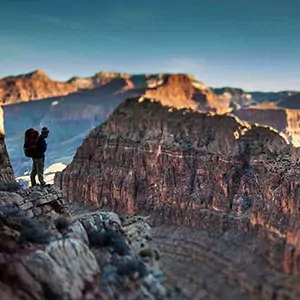
Guided Grand Canyon treks include permits, local transportation (excluded on certain tours), meals, gear, risk management systems, and professional guides, allowing guests to make the most of their visit to the Canyon, focus 100% on enjoying their experience, and do it all with an increased level of safety and comfort.
GRAND CANYON ADVENTURE TOURS
- GUIDED BACKPACKING ADVENTURES : these are for people interested in an authentic adventure deep in the Canyon’s wilderness.
- HORSE-ASSISTED TRIP : on this trip to the bottom of the Canyon, guests hike with light day packs and camp near the Colorado River.
- PHANTOM RANCH TOURS : this tour (limited dates) goes to the bottom of the Canyon where we sleep 1 or 2 nights in the Phantom Ranch Lodge 5 minutes from the Colorado River. Showers, A/C, heat…etc.
- ALL-INCLUSIVE HIKING PACKAGES : inn-based and camping-based hiking packages provide all-around hiking experiences of the Grand Canyon.
- DAY HIKE TOURS : maximize your day at Grand Canyon on a fully guided, award-winning hiking tour on one of the Park’s best trails.
Related Pages
- Visiting Grand Canyon in February
- Visiting Grand Canyon in March
- Visiting Grand Canyon in April
- Visiting Grand Canyon in May
- Visiting Grand Canyon in June
- Visiting Grand Canyon in July
- Visiting Grand Canyon in August
- Visiting Grand Canyon in September
- Visiting Grand Canyon in October
- Visiting Grand Canyon in November
- Visiting Grand Canyon in December

wildland Wires
Sign up to receive our exclusive Wildland Wire emails and stay up to date with Wildland Trekking's promotions, discounts, contests, outdoor tips and tricks, trip reports and more!

15 Tips for Visiting the Grand Canyon in January – 2024 Ultimate Guide
Visiting the Grand Canyon in January is a magical time. January is a peaceful time to visit with not too many crowds.
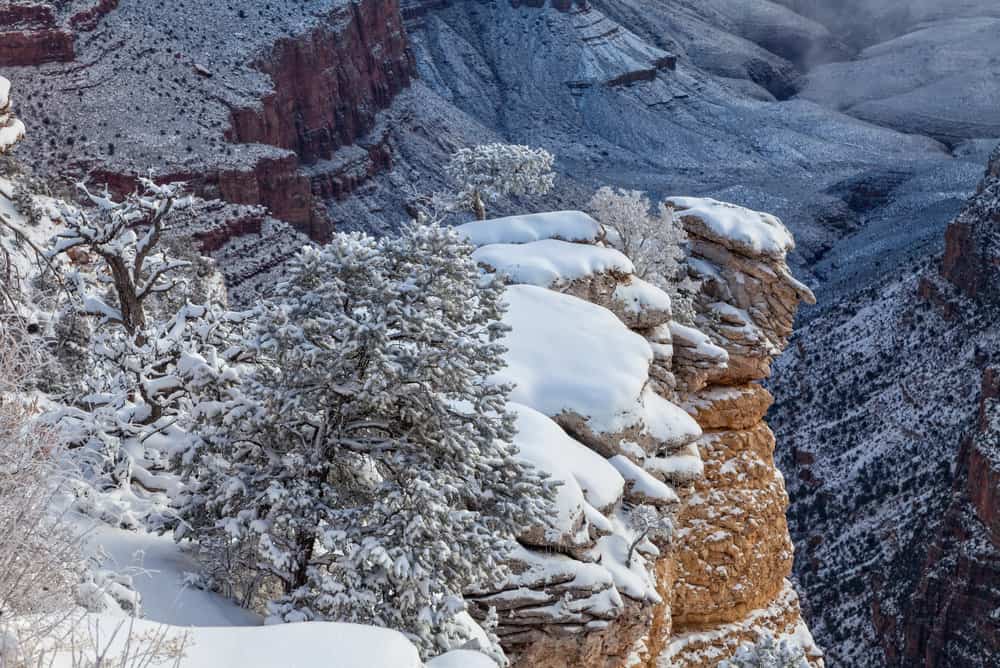
I’ve included all of the things to do in the Grand Canyon in November and tips and tricks for visiting. You can also use the Grand Canyon self guided tour to learn more about the Grand Canyon when you visit.
Weather in the Grand Canyon in January
In January, the daytime maximum temperature is 58 degrees Fahrenheit (14 degrees Celsius), while the overnight minimum is 34 degrees Fahrenheit (1 degree Celsius). The Grand Canyon covers a huge area and each section has a varied temperature.
Dress in layers and you will be fine!
Thank you for supporting this website written by an American. This post may contain affiliate links. This means I earn a small commission on these links at no extra cost to you.
National Park Entrance Fees
To enter the National Parks, you’ll need to pay an entrance fee or have a National Parks Pass also known as American the Beautiful Pass.
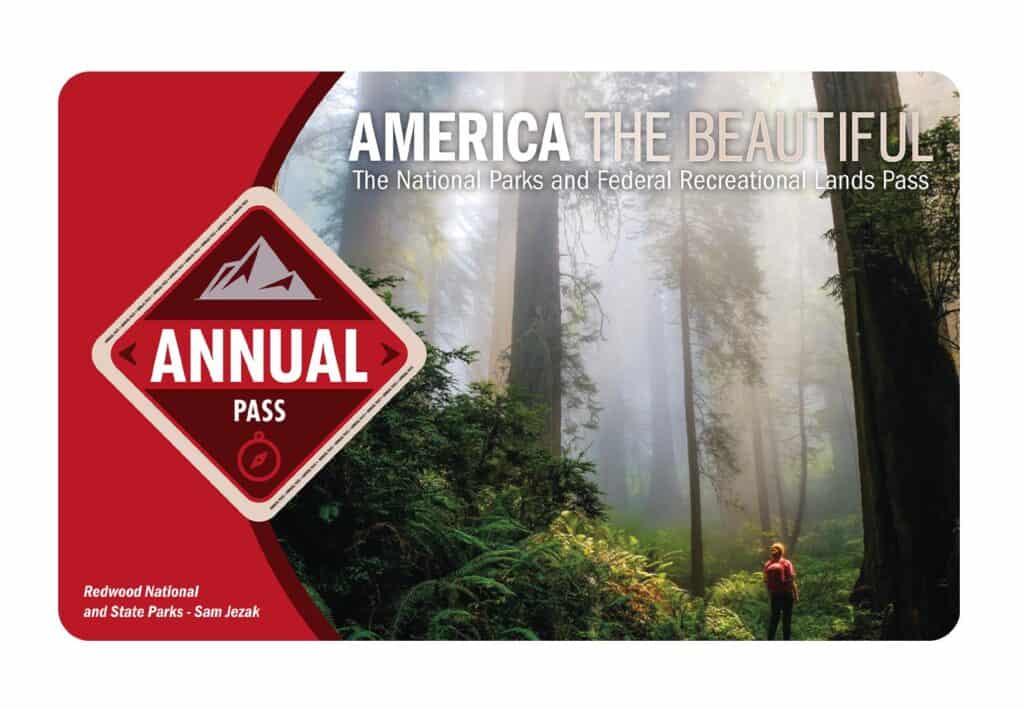
It costs $80 for a yearly America the Beautiful Pass . This gives you access to all national parks and federal areas that charge fees. The America the Beautiful Pass is well worth it!
I purchased my first one in 2016 and it’s such a money-saver! Plus 10% of sale proceeds go to the National Park Foundation.
Tips for Visiting Grand Teton National Park
Grand Canyon National Park is perfect for outdoor enthusiasts. There is something for everyone on this list and for different fitness levels. Also, note that it is dry and hot (in the summer), and make sure you know what you are getting into before you start. Here are a few tips for visiting the Grand Canyon:
- Bring a reusable water bottle and lots of water! Remember you are in the sun and you will need to drink lots of water. I love my LifeStraw Filtered Water Bottle . I can refill this bottle anywhere and it comes with a carabiner to connect it to my daypack.
- Check the Weather – days over 100 degrees are very common. Make sure to check.
- Hiking boots or sandals that will protect your feet! I love good shoes. I need all the support and help I can get. I actually love these sandals for hiking and also love these hiking boots .
- Bring hiking poles for balance and to protect your knees . I know many experienced hikers (and even amateur ones) think that hiking poles are for old people who lose their balance. Actually, hiking poles can help when going down steep inclines or when scrambling over rocks. They are great to hike with even for the most experienced hiker.
- Wear a sunhat . I feel like this whole post is about how high you are in the mountains and how much closer you are to the sun but it is so true. At elevation, you are closer to the sun and more likely to burn. Wear sun protection such as a sun hat and sunscreen .
- Be aware of the wildlife. This is the Southwest and you will need to watch out for snakes and other wildlife such as moose or a bear. Please stay away from wildlife and do not feed them. I recommend carrying bear spray as well.
- Start Early – If you want to avoid the traffic and the heat you will need to start your hike early. That way it will be nice and cool and the smog will not affect you either.
- Leave no trace . If you are new to the concept of Leave No Trace it is all about preserving the environment to ensure it is in the same or better condition when you leave it. This means that you should stick to the trails and carry out everything that you carried in. This is a great explanation of the Leave No Trace principles!
- Water shoes are great for water hikes – If you don’t have a pair, I highly suggest it as they are affordable. I have an article on the pros and cons of several pairs of water shoes .
- Bring Bug Spray and a snack : Be sure to bring everything you need including a snack like a protein bar plus BUG SPRAY .
Where to stay near Grand Canyon National Park
The Grand Canyon makes for a great weekend escape. Fresh air, beautiful scenery and being in nature does a world of good for the soul. I recommend staying as close to the park as possible and even treating yourself with a cabin with a spa pool to relax at night.
- There are lots of fantastic Airbnbs near the Grand Canyon . I have made a list of the best airbnbs around the park wherever you decide to stay. You can also check out my post on Where to Stay near the Grand Canyon to find the perfect hotel for any budget.
If you are taking a road trip remember to reserve a car in advance using Discover Cars .
15 Things to do in the Grand Canyon in January
Grand canyon south rim: self-guided tour.
See a natural wonder of the world in person on this self-guided driving tour of the Grand Canyon’s South Rim.

This self-guided driving tour takes you to all the best vistas, hikes, and attractions along Grand Canyon’s South Rim and tells you the secret history behind this famous landscape. Walk the scenic South Rim Trail, catch a sunset at Mather Point, and much more.
Visitor Center
As it is closest to all of the parking lots and Mather Point, begin at the main visitor center. Maps, park ranger interactions, canyon-related displays, and a 20-minute video titled “Grand Canyon: A Journey of Wonder” are all available here.

The visitor center, which is next to the south entry station at the south rim, is open Monday through Friday from 9 a.m. to 4 p.m. throughout the winter. You can learn about the current weather conditions, whether it’s safe to hike certain trails, whether some trails are closed, and which vistas are the safest to visit at the visitor center.
The main park store is also located across the plaza from the visitor center and is always worth a visit. In this main square, you can also find Bright Angel Bike Rentals. If it’s cold or snowing outside, you might not want to rent a bike or go on a bike tour, but you can stop by the shop’s café for a coffee or hot chocolate instead because they have the best coffee in the Grand Canyon!
Helicopter Ride down into the Grand Canyon
At the Grand Canyon, helicopter tours are accessible all year long. You should experience the vistas of the canyon covered with snow in December.
Even though there are many excursions available, the Grand Canyon Helicopter Tour is among the best. During the 45-minute flight, you will fly over the South Rim and the Kaibab National Forest.
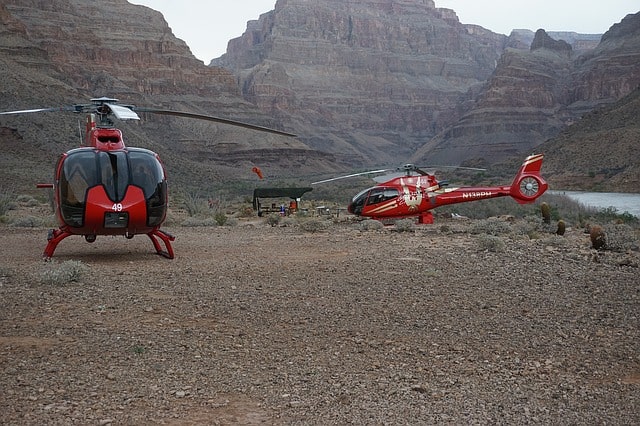
Experience the canyons by looking down into them on a helicopter tour or simply viewing them from a vantage point.
These helicopter ride s, though perhaps a bit pricy, are well worth it and will provide you with priceless memories.
Experience the Spirit Helicopter Tour if you want to make this a trip you’ll never forget. The most popular and affordable helicopter tour leaving from the South Rim is this one.
The Spirit Tour, which flies over the Painted Desert, Kaibab National Forest, and—best of all—the Dragon Corridor, the widest and deepest section of the Grand Canyon, gives you some of the be
Mather Point
In addition to being close to the visitor center and parking lots, Mather Point is the most popular location to watch the sunset. This is a must-see in this wintertime sunset. At this time of year, you can easily catch the sunset before going out to dinner because the days are shorter.
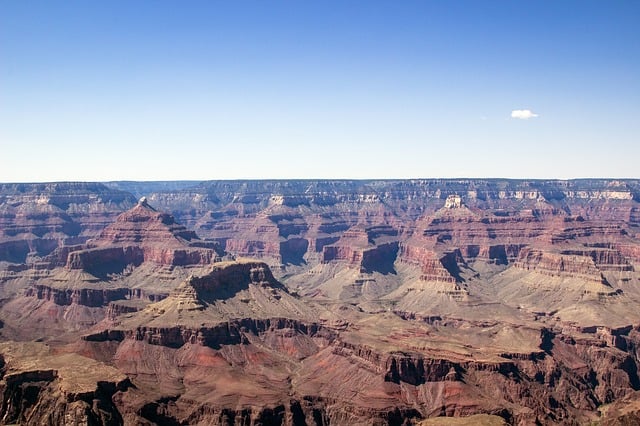
No matter what you do, stay for a few minutes after the sun has officially dipped beyond the horizon. At this time of year, the winter sky frequently takes on beautiful pink and purple tones.
Although the East Rim Drive of the Grand Canyon isn’t the most well-traveled part of the canyon, Yaki Point has one of the most impressive views of the canyon, which encourages many people to visit it.
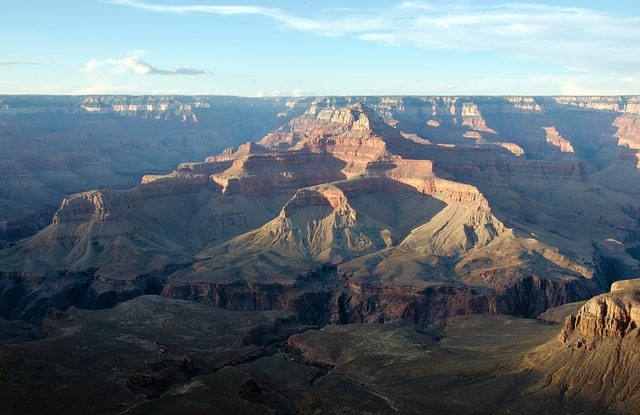
Yaki Point is located at the easternmost point of the Kaibab Trail Route and is a no-vehicle zone, so visitors must hike there from the neighboring parking lot or shuttle bus.
You can see a large portion of the South Kaibab Trail as it begins to extend towards O’Neill Butte and Cedar Ridge, as well as the end of the Bright Angel Trail. To the east are Cremation Creek and many magnificent buttes and mesas. Yaki Point undoubtedly has something special to offer to those who are intrigued.
Grandview Point
Grandview Point, located halfway between Desert View and Grand Canyon Village and accessible by a one-mile side road, is the southernmost point on the south rim of the Grand Canyon.

Because the official viewpoint is partially obscured by trees, the best views of the point can be found a short distance down the Grandview Trail. Due to Grandview’s high elevation (7,400 feet), which receives more rainfall, the woodland there is taller and thicker, with a mixture of oak, ponderosa pine, and pinyon pine trees.
Grandview was the first area along the rim to be developed for tourists before El Tovar Lodge was constructed next to Garden Canyon. This area had services, including a hotel built in 1895, but it was abandoned after only a few years of operation, leaving little evidence today.
Moran Point
One of the most popular stops along the east rim drive is Moran, which provides expansive views of a sizable portion of the Grand Canyon roughly between river miles 87 and 72.
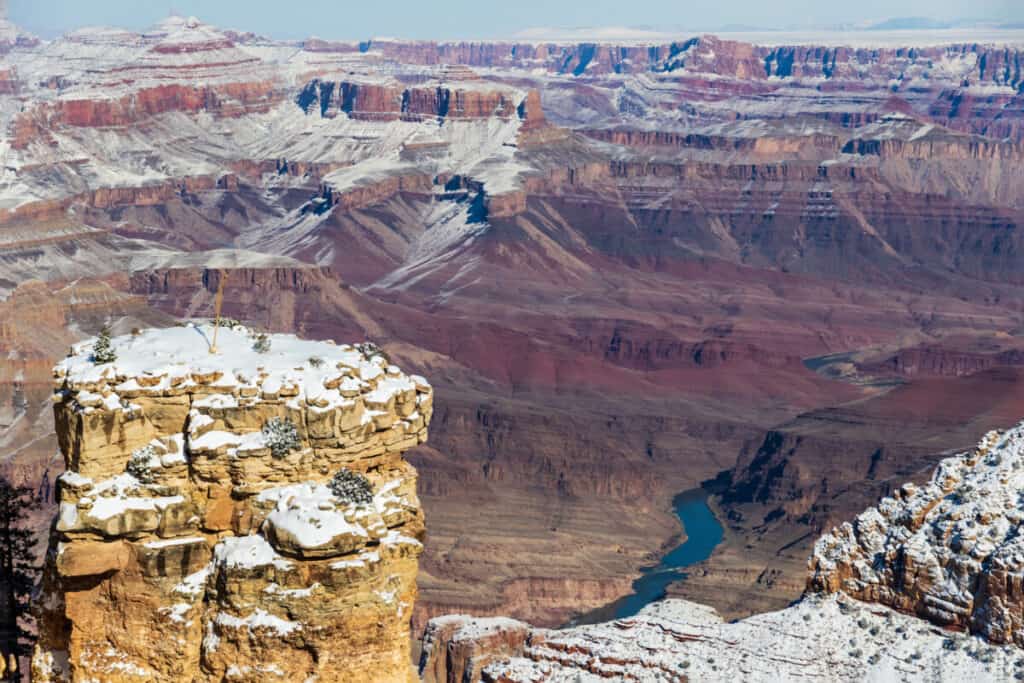
The point is just 8 miles away in a straight line, but 215 miles away by car, due south of Cape Royal on the North Rim. The canyon’s popularity increased after landscape painter Thomas Moran visited for the first time and helped popularize the promontory, which can be reached via a brief offshoot road. As a result, the canyon was later designated as a national monument.
Directly below Moran Point is Red Canyon, particularly where deep red/orange layered rocks made of Hakatai shale are displayed.
The flat, light-colored plateau between Red Canyon and the drainage to the north is made of Bright Angel shale from the Cambrian era, which is over 600 million years younger than the pre-Cambrian Hakatai.
This location is one of many unconformities in the strata of the canyon, where adjacent rocks are separated by long periods of geological time. The New Hance Trail travels along Red Canyon before coming to an intersection with the Escalante Route directly across from the narrowly discernible Hance Rapids.
Maricopa Point
The Grand Canyon’s edge is relatively narrow at Maricopa Point, reaching to the northeast for 100 feet before abruptly disappearing, while it continues much further below as a thin ridge between Horn Creek and the bigger Garden Creek. The first stop on the west rim shuttle bus tour is Trailview Overlook, although this is the second one.
There are no significant barriers between Maricopa and the river, and views of the Grand Canyon extend over 180 degrees from here. While most of the Bright Angel Trail is obscured by the Battleship formation, several miles of the Tonto Trail is visible as they wind past Horn Creek and Dana Butte and down Garden Creek.
Hopi Point, which lies on Hermits Road, is one of the must-see locations along the canyon’s western rim. One of the best canyon views is arguably found around halfway down the 7-mile route.
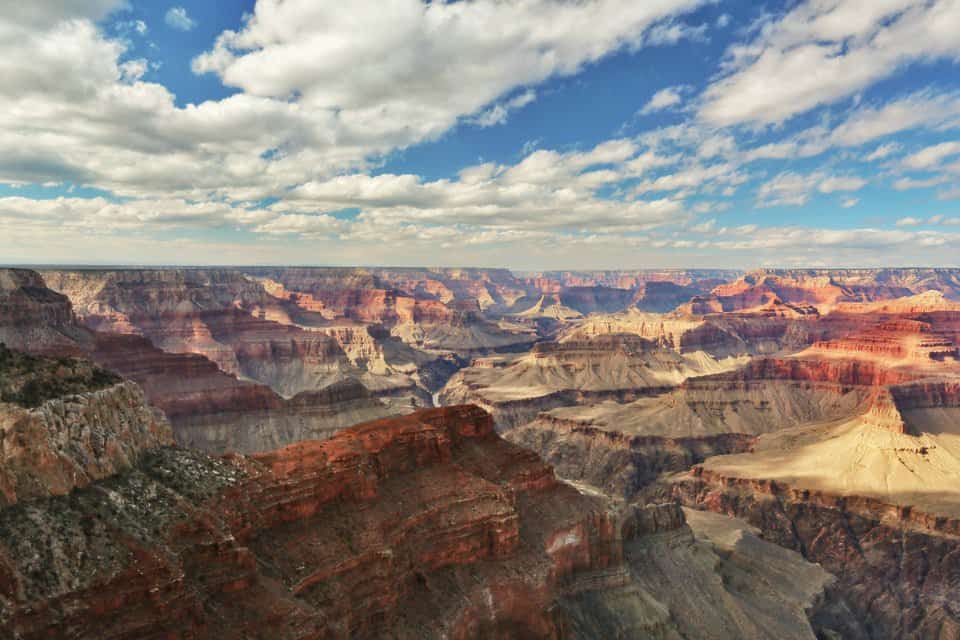
Due to the breathtaking panoramic views of the Colorado River, Dana Butte, and sweeping canyons, Hopi Point is one of the most well-known viewpoints along the west rim. Due to the expansive views, Hopi Point is regarded as one of the best locations to view the dawn and sunset.
To get to Hopi Point, the park does provide shuttle buses along Hermit Road if it is snowy and the roads are judged hazardous for private vehicles. ensuring that you have the opportunity to witness this stunning view regardless of the weather.
Winter is the only time of year when Hermit’s Road is accessible to private vehicles, so now is the perfect time to arrange your trip.
Mohave Point
The 3,000-foot-high, nearly vertical cliffs that surround The Abyss and stretch two miles to the west, towards Pima Point, may be seen well from Mohave Point. Three of the following sites, which are Yuma, Cocopa, and Havasupai, are further west, fading into the distance.
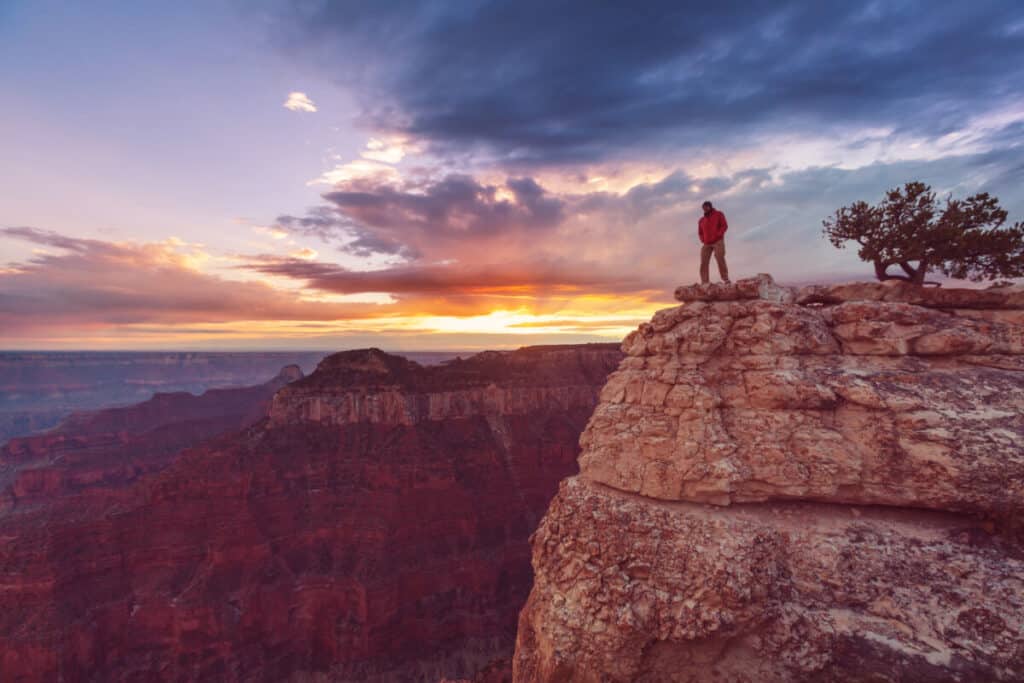
The view starts with Bright Angel Canyon on the North Rim and includes Ninety-one Mile Creek, Trinity Creek, and Ninety-four Mile Creek because the ridge stretching from Hopi Point blocks some of the canyons in the east.
Along with Hopi Point, Mohave is one of only two eastbound stops on the Hermit’s Rest shuttle bus route, and both are well-known spots to see the setting sun. Hopi offers more panoramic views, but Mohave offers multiple overlooks rather than just one, has a smaller visitation population, and is therefore generally more tranquil.
Additionally, The Alligator, a striking red sandstone mesa with sharp edges, is located directly underneath Mohave Point.
The Abyss doesn’t protrude out into the canyon like some of the other picturesque vantage sites along Hermit Road. This is a steep, notched, or hollow indentation in the canyon walls that plunges precipitously almost 3,000 feet into the Grand Canyon to the Redwall Formation.

This picturesque vantage point in Grand Canyon National Park provides views of Monument Creek, the Tonto Plateau, the Colorado River, Granite Rapids, and the Monument, a sizable sandstone column in the Grand Canyon, in addition to a slightly frightful, steep, vertical view down the canyon into the Monument Creek drainage area.
Your favorite part of the Canyon Rim Trail along Hermit Road might be the hike from Mohave Point to The Abyss. As you make your way up stone stairs and along a rock wall at the edge of the canyon, snowflakes will be gently drifting around you. On a long stretch of the walled overlook, you can unwind at a solitary picnic table and take in The Abyss.
Pima is the final point along West Rim Drive, but the road continues for another 1.5 miles to Hermit’s Rest, which contains a gift shop, restrooms, and a cafe. However, the views from here are somewhat limited because the canyon edge is quite densely forested and the overlook is at the end of a side canyon.
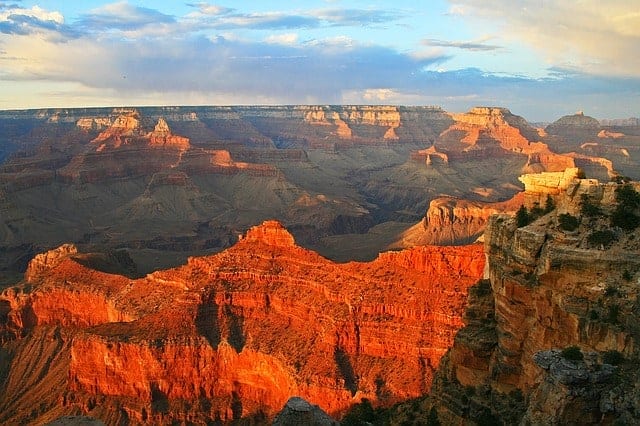
There is nothing to obstruct the view of the Grand Canyon from Pima Point, which is located at the northernmost corner of a broad promontory. The view extends over 40 miles, from Bright Angel Canyon in the east, all the way to the Powell Plateau, and the Great Scenic Divide in the west.
Hermit Creek’s deep, red canyon dominates the foreground on the west side, and the rocks that rise sharply up to the next two points may be seen there (Yuma and Cocopa). In contrast to the mostly dry cliffs and canyons further west, the lower portion of the creek features year-round flowing water and a short corridor of vivid green flora.
The Hermit Trail can be seen in many places, snaking through Travertine Canyon, crossing Hermit Creek, and zigzagging down Cope Butte. In the eastern panorama, a beautiful vista along Ninety-four Mile Creek may be seen just across from Monument Creek, the Granite Rapids, and The Alligator.
Grand Canyon Village
Grand Canyon Village draws a lot of visitors since it is the park’s most well-liked entrance point. However, there’s a reason for the area’s popularity: it’s home to Yavapai Point, one of the best vantage spots for viewing the canyon.
You might visit Grand Canyon Village for lunch after a morning of sightseeing. Additionally available are the Maswik Food Court, the Bright Angel Restaurant, and the traditional El Tovar Dining Room. The dining area is relatively affordable for its position, which is close to the Bright Angel Trail trailhead and offers views of the Grand Canyon.
These little cabins are perfect for snuggling up with hot cocoa after a winter stroll, especially with the likelihood of snow in the Grand Canyon. If you want to be in the park but don’t want to tent, this is where you should go. This area of the Grand Canyon is the busiest and has the most lookouts.
Hermit’s Rest Scenic Drive
Hermit Road, a well-known 7-mile circuit that begins at Hermits Rest and travels along several picturesque overlooks, is situated near the westernmost point of the south rim.

Along this route, shuttle buses run by the Grand Canyon are available and the highway is accessible to private vehicles in January.
Some of the canyon’s best vistas, including those from Hopi Point, Mohave Point, and Pima Point, can be found along this route.
Plateau Point
Although the Plateau Point Trail, which is 1.5 miles long, is not particularly challenging, the entire adventure—from the South Rim Trail to the beautiful viewpoint—is 12 miles round trip.
Just past the ranger station and mule corrals at the northern end of Indian Garden, the Plateau Point Trail begins. After crossing Garden Creek and leaving the shade behind, proceed west along the Plateau Point Trail. Follow the Tapeats sandstone’s contours as it crosses a dry plateau and a series of ravines. There is no shade here; instead, cacti and other vegetation cover the generally level desert terrain.
Turn right to head northeast at the intersection of the West Tonto Trail and the fork. From here, you can almost directly ascend across the Tonto Platform to the viewpoint. To get to a flat top rock and a viewing platform, pass a water tank and a mule hitching post. See if you can spot Rafters navigating Horn Rapids while admiring the breathtaking scenery.
Kids should not play near the edge! This trail allows mules to watch out for their droppings.
Desert View Watchtower
On the park’s South Rim, Desert View is the area with the biggest concentration of development. The Watchtower, a designated National Historic Landmark, was built in 1932. This specific tower was modeled after the Hovenweep Round Tower and the Mesa Verde Round Tower.
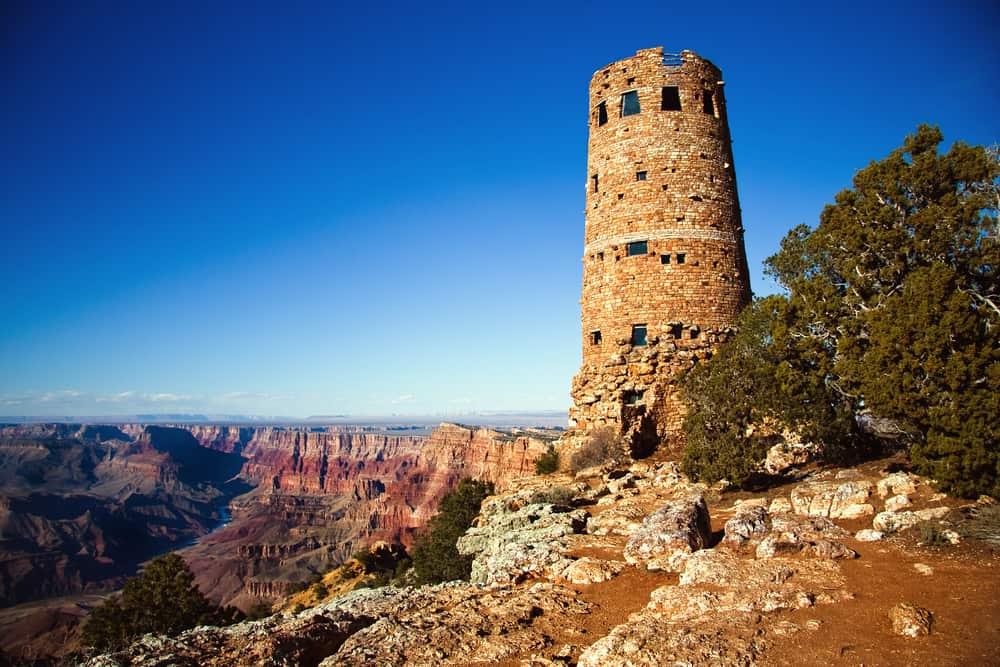
The view of the eastern side of the Grand Canyon from the Watchtower offers a distinctive viewpoint. Looking northeast from here, one can see in the distance where the Colorado River leaves the comparatively small Marble Canyon and enters the much larger Grand Canyon.
Tusayan Museum and Ruin
One of the most significant archaeological finds in Arizona is the 3-mile-west of Desert View Point, Tusayan Museum, and Ruin.
The ruins of a Pueblo village, thought to be over 800 years old, can be found inside the ruins themselves. The museum, which is adjacent to the ruins, houses a variety of displays that aim to help visitors better appreciate the special history of the canyon.
A beautiful winter day would be perfect for visiting the museum and learning about the 12,000+ years of fascinating archeological history.
Recent Posts
15 Tips for Visiting the Grand Canyon in September – 2023 Ultimate Guide
Visiting the Grand Canyon in September is a great time to visit. September is a busy time to visit but the crowds are starting to arrive especially toward the end of the month. I’ve included...
15 Tips for Visiting the Grand Canyon in August – 2023 Ultimate Guide
Visiting the Grand Canyon in August is a great time to visit. August is a busy time to visit but the crowds are starting to arrive especially toward the end of the month. I’ve included all...

What It’s Really Like to Visit Grand Canyon in Winter (+Seasonal Tips)
By Author Jurga
Posted on Last updated: November 16, 2023

Thinking of visiting Grand Canyon National Park in winter and wondering what to expect? What is the weather like and what you can see and do at the Grand Canyon in the winter months?
This guide should answer all your questions and give you a better idea of what it’s really like to visit the Grand Canyon in December, January, or February. But also the end of November and the beginning of March can still be quite cold and wintery here, so most of this information applies to those months as well.
Good to know: Grand Canyon has three main areas that you can normally visit: South Rim, North Rim, and Grand Canyon West.
- Grand Canyon North Rim is CLOSED in winter and cannot be visited. The road towards North Rim normally closes at around mid-November and doesn’t reopen until mid-May.
- Grand Canyon West (where Grand Canyon Skywalk is located) is not part of Grand Canyon National Park. It’s owned and operated by the Hualapai Tribe. If coming from Las Vegas, this is the closest part of the Grand Canyon (a bit over 2 hours drive). It’s normally OPEN in winter and you don’t need much special knowledge or preparation to visit here. Just show up, pay, and you’ll be explained what and how you can see it. If the weather is really bad, however, there is no point in driving here either – you won’t see much.
- Grand Canyon South Rim is the nicest part of the Grand Canyon National Park. When people talk about visiting the Grand Canyon, this is the place they usually mean. South Rim is OPEN in winter, but there are quite a few things you may want to know when planning to visit. All the information in this article is focused on visiting the South Rim of the Grand Canyon in winter.
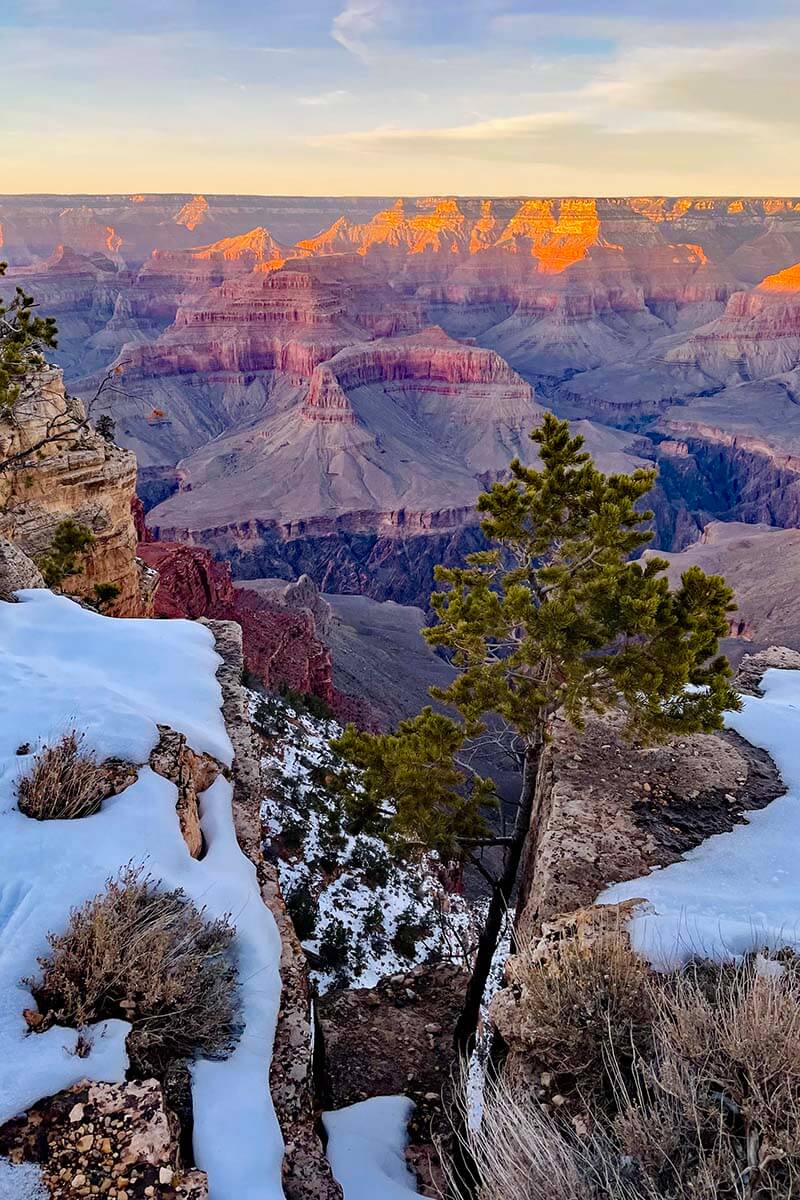
Complete guide to visiting Grand Canyon in winter – OVERVIEW:
- The weather
- How are the roads?
- Can you see much if it snows?
- Daylight hours.
- Is it busy?
- How to avoid the long queues at the park entrance?
- Best things to do in winter.
- What to wear?
Is Grand Canyon worth it in winter?
- Alternatives for if the weather gets really bad.
Grand Canyon Winter Weather
The Grand Canyon South Rim sits at an elevation of 7,000 feet (2,100 m). So it will not come as a surprise that the weather here can get really wintery in the coldest months of the year.
You never know exactly what you will get until you can see the forecast a few days before your visit. But you can expect everything from clear blue skies to rain, wind, and also snowstorms.
Good to know: There is a big difference in elevation and thus in temperatures inside the canyon and at the top. Unless you go hiking, your visit will not include the canyon floor, and you will spend all your time touring the South Rim and its many viewpoints. So when checking the weather, look for the forecast for Grand Canyon Village ; that way, you get a better idea of what to expect.
The average winter temperatures at the Grand Canyon Village (Grand Canyon South Rim) are around freezing point. The average lows between December and February are 18 F (-8°C) and average highs are 45 F (8°C). In November or March, average lows are around 24 F (-4°C), and average highs are around 53 F (12°C).
As already mentioned, you might get some rain, but between December and February, it’s more likely that you will get snow.
Our experience: We visited the Grand Canyon at Christmas. We had two days with amazing sunny weather and daytime temperatures of up to 50 F (10°C). During the day and in the sun, you could easily walk around in a sweater. But at night, it was around 24 F (-4°C) and our car windows were frozen.
The day we were leaving the park, it was extremely windy and it felt freezing cold. Even though the temperatures were about the same as the previous days, without the sun and with a very strong windchill effect, it felt really cold. We needed winter jackets, gloves, and warm scarves to even just walk around at a couple of viewpoints on Desert View Road.
The day after we left, it started snowing, and the roads got closed for two days. It also stayed really wintery for weeks after that. Luckily, it doesn’t snow every day at the Grand Canyon in winter, and the roads do get cleared when possible, but it remains so cold that you will see snow at the South Rim of the Grand Canyon for the biggest part of the winter.
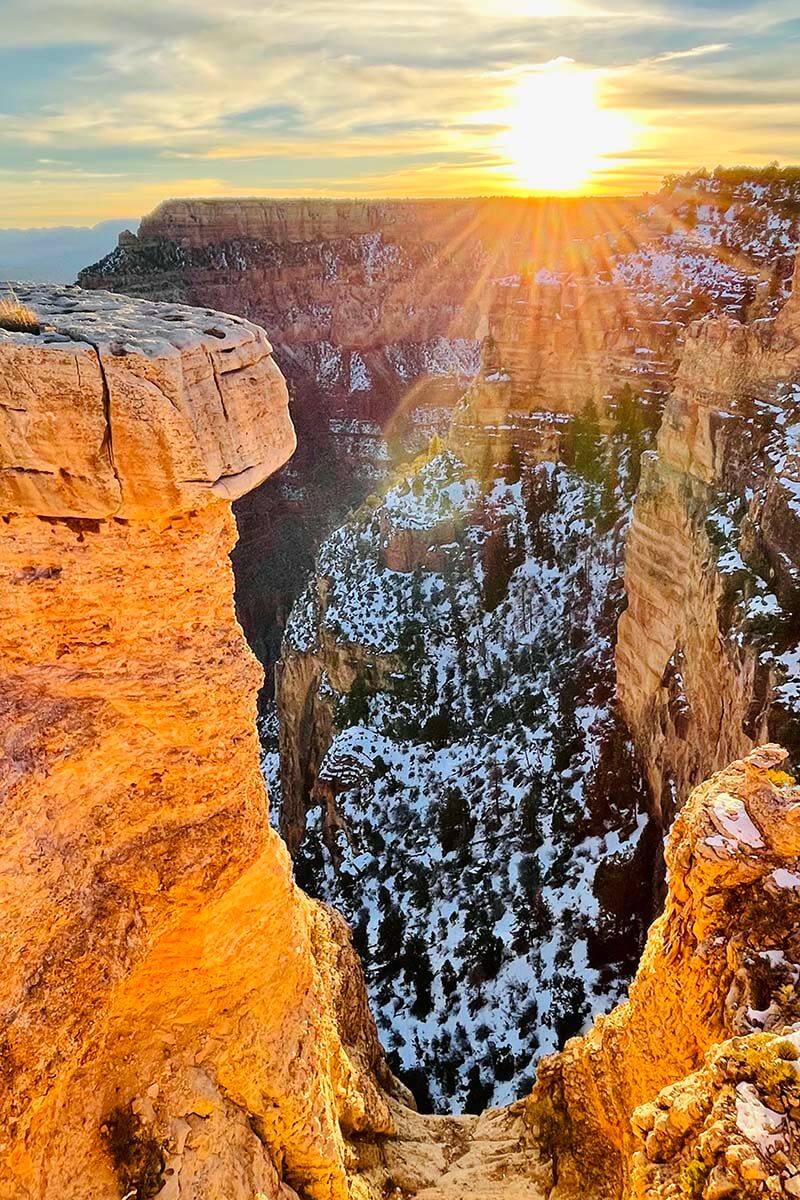
Are Grand Canyon roads open in winter?
The roads at the Grand Canyon South Rim are normally open the whole year round. However, when it snows, some roads get temporarily closed.
Which roads get closed and for how long, really depends on the weather.
Normally, the main road SR64 from Williams, AZ, to Grand Canyon Village is always open. This is where most travelers enter the Grand Canyon National Park. It’s here that the visitor center is located and it’s here that you will find all the hotels, various facilities, and some of the best viewpoints of the Grand Canyon.
Desert View Road in the direction of Cameron often gets closed during snowstorms. It’s usually cleared as soon as the conditions allow it. But it’s not uncommon for Desert View Road to remain closed for several days in a row in the winter months.
Hermit Road is a scenic road in the heart of the South Rim. In the summer, this road is only accessible with the park shuttle. In the winter, you can drive here in your own car. However, this is a local road that only leads to several viewpoints so it’s not really a big priority to keep it open. If it snows, Hermit Road will often be the first to close and the last to reopen.
TIP: It’s essential to check the official website for up-to-date information and road conditions when visiting Grand Canyon in the winter! We also highly recommend checking their Facebook page , where they usually post any important information about the weather and road conditions.
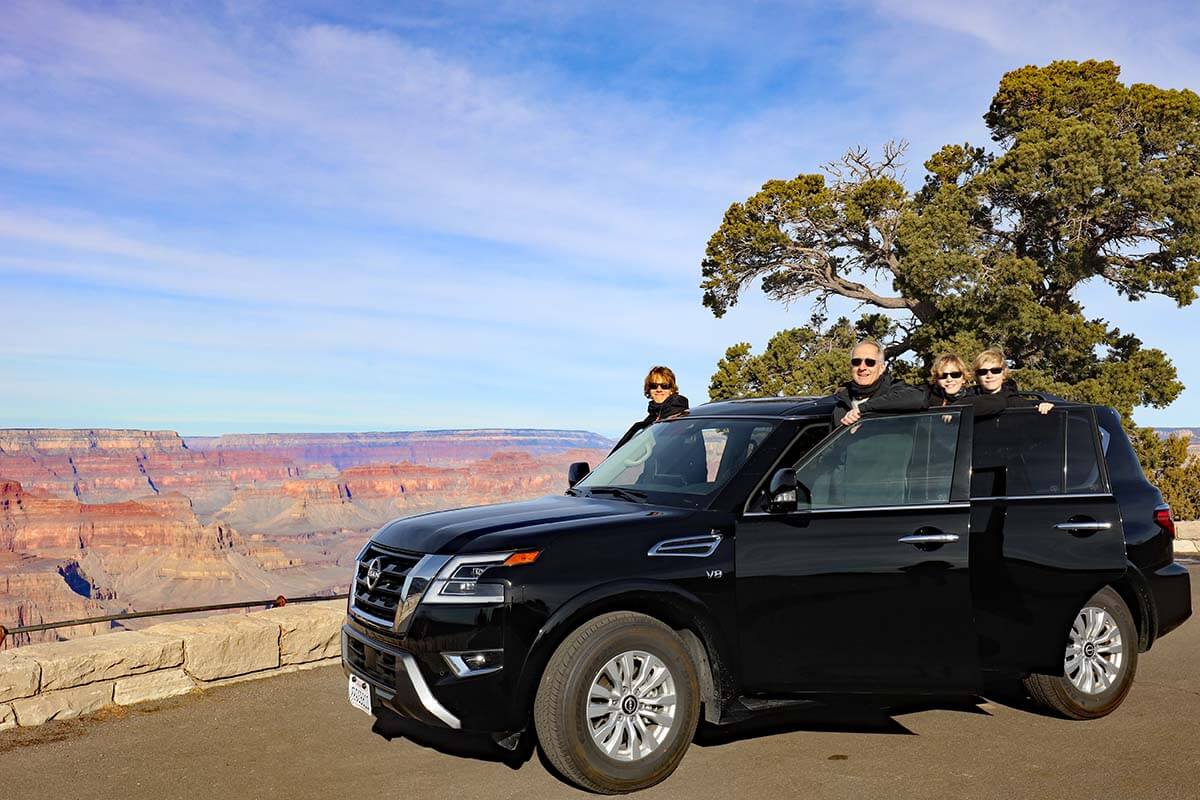
How about the Canyon views – can you see much if it snows?
Normally, you can enjoy amazing views of the Grand Canyon in any season. But indeed, in winter it can happen that the entire canyon is covered by clouds/mist . I’ve seen pictures shared by the official Facebook profile of the park where the ‘view’ was totally white. This is usually the case during snowstorms.
So if there is a snowstorm in the forecast, you should really consider if it’s worth visiting the Grand Canyon. Not only you won’t see much, but the roads can also get dangerously slippery or even close completely.
TIP: When making plans to visit the Grand Canyon in winter, try to keep your itinerary somewhat flexible. If you are booking accommodation, be sure that it offers free cancellation. If you are planning to drive for just a day, make an alternative plan for places to visit nearby in case you decide not to drive to the Grand Canyon. And if the weather is great and you are not too far away, just go!
For that, ideally, you foresee a few days in the area so that you can adjust your plans based on the weather forecast if needed. This is precisely what we did on our recent trip when we saw that there was a snowstorm forecasted for the days when we were planning to be there. We changed half of our road trip itinerary in order to get to the Grand Canyon a few days earlier than foreseen.
For us, it worked out great. We had wonderful sunny weather and could enjoy the best that Grand Canyon has to offer in the winter, and we were out of the area just before it started to snow. But this does require quite some flexibility.
We have a couple of suggestions for this at the end of this guide.
Good to know: Many hotels in Tusayan, just a few miles from the park entrance, can be booked online via websites like Booking.com , Expedia , or Hotels.com . We always use Booking.com. You can immediately see which hotels offer free cancelation, and it takes just a few clicks to cancel or change your reservations.

Daylight hours
It probably goes without saying, but just in case – the days are much shorter at the Grand Canyon in winter than in the summer. How short depends on when exactly you are visiting.
The shortest days are around the end of the year. So if you visit the Grand Canyon around Christmas – New Year, you should know that it doesn’t get light before 7 am and it gets dark at around 5 pm.
Here are approximate sunrise and sunset times at the Grand Canyon in the darkest winter months:
- December. Sunrise 7.20 – 7.40 am. Sunset 5.15 – 5.25 pm.
- January. Sunrise at around 7.40 am. Sunset 5.25 – 5.40 pm.
- February. Sunrise 7 – 7.30 am. Sunset 5.55 – 6.30 pm.
This is still plenty of daylight in order to see and do everything that you want. But it’s something to keep in mind when planning your visit.
Important! If you are traveling to the Grand Canyon in winter from e.g. Las Vegas, you should know that there is a 1-hour time difference between Nevada and Arizona. So, for example, when it’s 7 am in Las Vegas, it’s already 8 am at the Grand Canyon. This is only the case between November and March because Nevada participates in Daylight Savings Time and Arizona doesn’t.
TIP: No matter when you visit the Grand Canyon, try to start your days early. Beautiful sunrises or short daylight hours are not the only reason for that – see below!
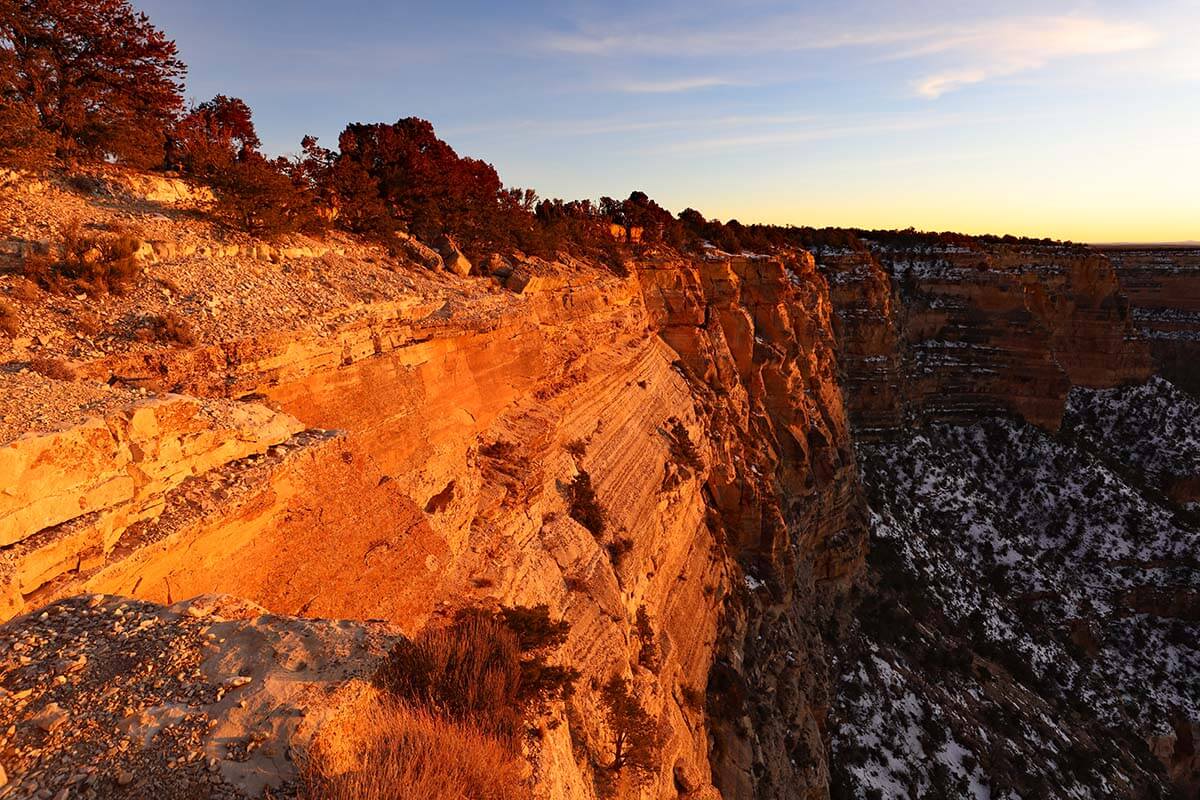
How busy is it at the Grand Canyon in winter?
Normally, winter months are really quiet at the Grand Canyon, so the crowds shouldn’t be an issue. But you should expect it to be very busy during the Christmas holiday season, around Thanksgiving, and other public holidays, such as Martin Luther King Day in January. Also sunny winter weekends can get very busy at the South Rim.
That being said, the crowds spread out inside the park so it’s usually not such a big issue in the winter. Even finding parking at the most popular viewpoints during the day should be ok. We visited Grand Canyon in the peak season at Christmas and – while it was busy – we never had issues with parking or so.
But there is one bottleneck and that’s the south entrance gate at Grand Canyon South Rim. During busy days, the lines at this entrance can stretch for several miles, and it can ruin your entire day.
Below, we have some tips on how to avoid long queues – take a look!
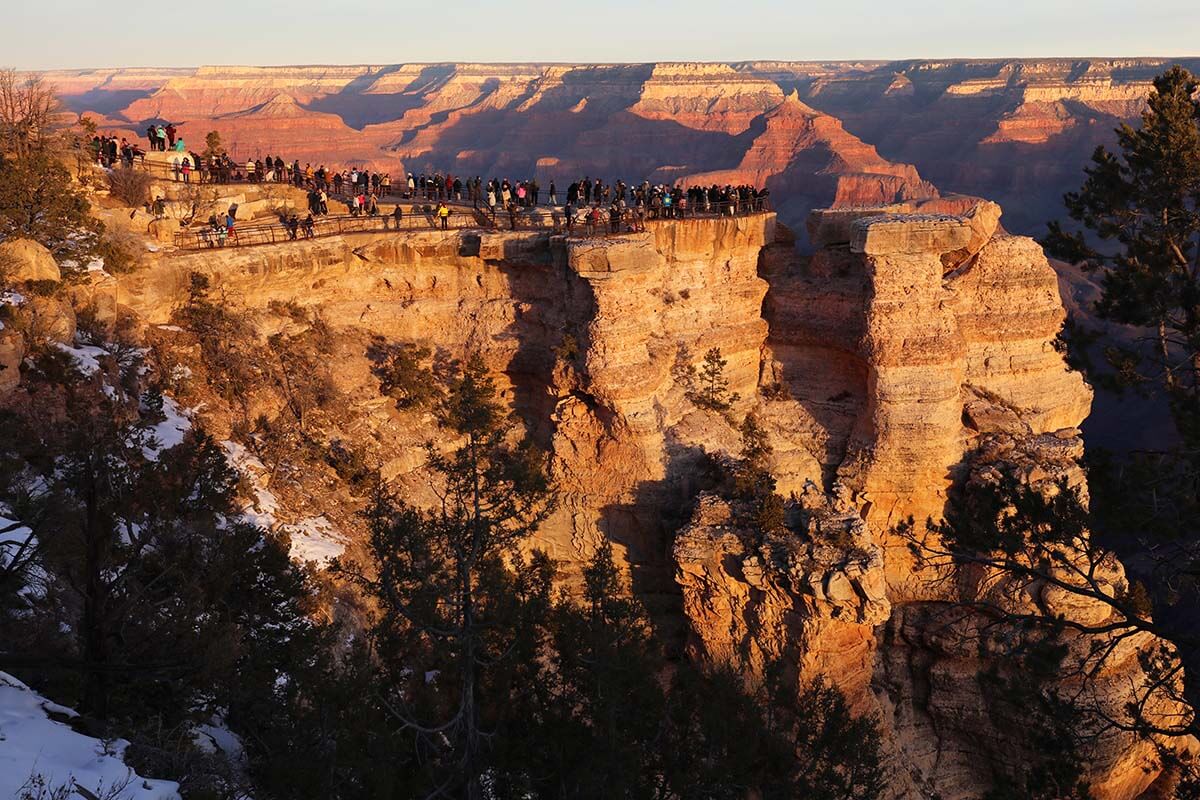
How to avoid the queues at the South Entrance Station?
Grand Canyon’s south entrance is known for the notoriously long queues. This is something you have to take into account even if visiting the Grand Canyon in winter, especially during the holiday season, but also on the weekends.
During busy weekends in winter, wait times to get into the park between 10 am and 5 pm can be as long as 2 hours!!!
To give you an idea, on one of the days when we were driving out of the park at 3 pm, the queue to get in was stretching all the way to the Tusayan General Store (about 1.7 miles). If it takes you two hours to get inside and the sunset is at around 5.30 pm, it will be dark by the time you get there! Everyone in town was wondering why people were even queuing at that time…
A good thing is that there are several simple ways to avoid the long wait times at the Grand Canyon’s south entrance. We have a more detailed guide explaining all the best options – take a look via the link below.
LEARN MORE: How to avoid long queues at the Grand Canyon South Entrance Station
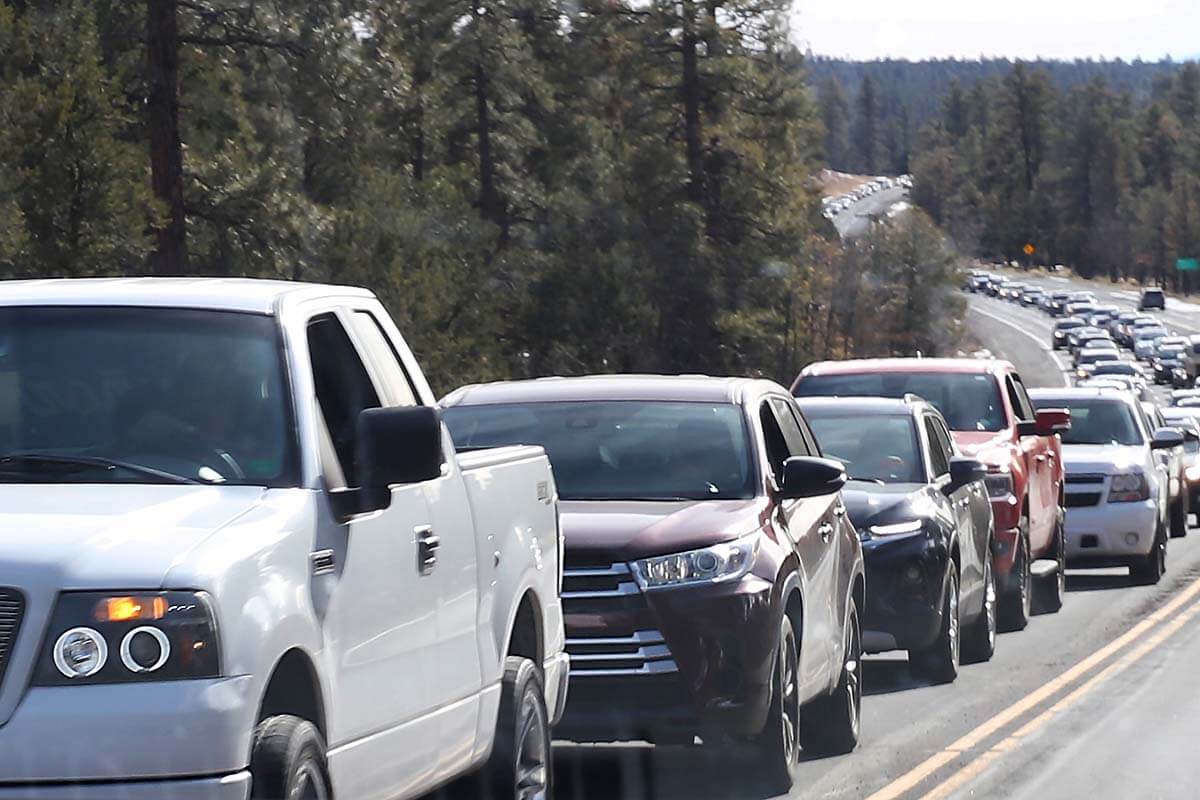
What can you see and do at the Grand Canyon in winter?
Weather permitting, you can see and do pretty much the same things at the Grand Canyon in winter as in the summer.
You can visit the nicest viewpoints, walk along the South Rim Trail, go hiking into the canyon, go stargazing, book a helicopter flight , take a journey on the Grand Canyon Railway , visit museums and visitor centers, etc.
Needless to say, you can visit museums, visitor centers, and gift shops in any weather. But the real reason to come here is to enjoy the majestic views of the canyon.
So of course, some activities can be influenced by the winter weather. It’s best to take that into account and keep some flexibility in your plans. Below, you can find an overview of what you can see and do at the Grand Canyon in winter.

Here are some of the best things to do at the Grand Canyon in winter:
Viewpoints at the Grand Canyon Village
By far the best thing to do at the Grand Canyon in winter is to enjoy the views from the various viewpoints on the South Rim. The easiest viewpoints to visit are the ones located at the Grand Canyon Village .
The most popular of them all is Mather Point where the main visitor center is located. Yavapai Point nearby is somewhat quieter and offers amazing wide views in all directions. Yavapai is also a good place to be if it’s very cold and windy because you can also enjoy the great views from the museum which is located here.
Normally, you can also easily get to the viewpoints at the Bright Angel Lodge and pretty much the entire stretch of the Rim Trail at Grand Canyon Village. These places are easily accessible from the main roads which are normally always cleared in winter.
Good to know: Even if it snows and some roads get closed, you should always be able to visit this part of the Grand Canyon (whether you will see much in a snowstorm – that’s another question).
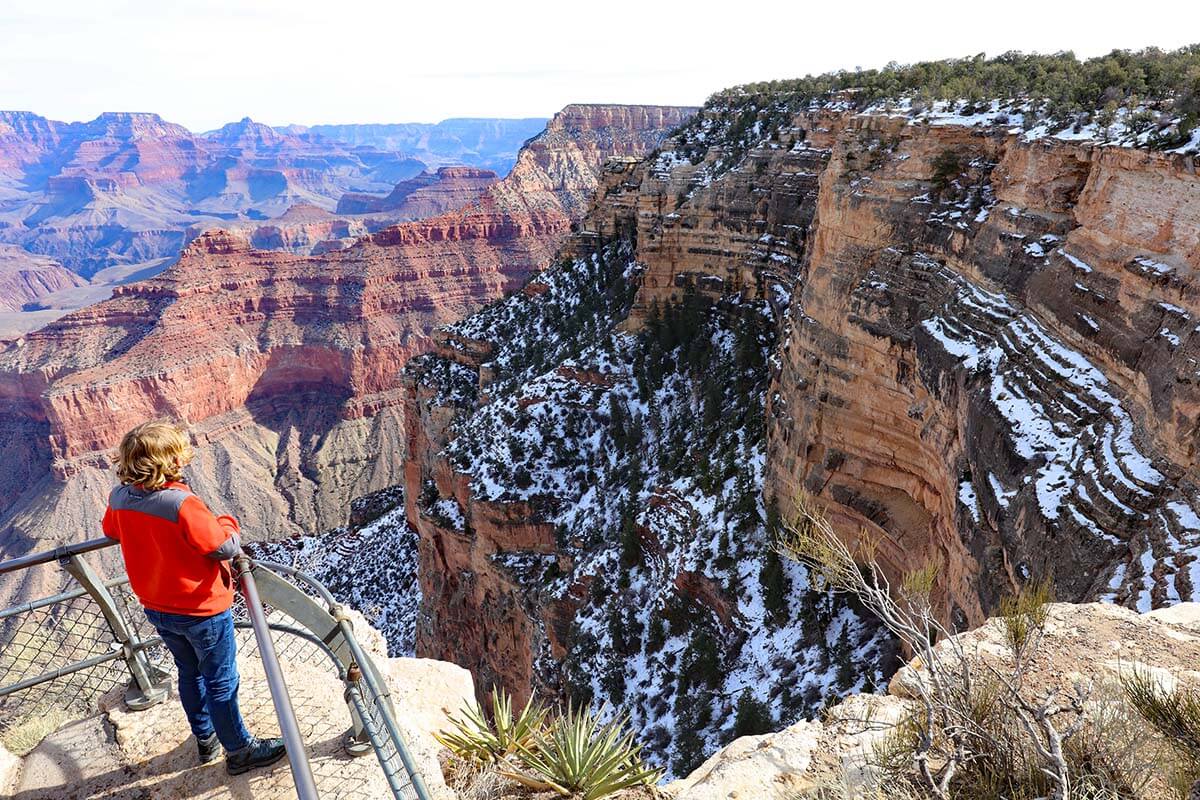
Hermit Road
In addition, you can also visit many viewpoints on Hermit Road . In winter (December 1 until March 1) the shuttle doesn’t cover this area of the park, so – weather permitting – this road is open to private vehicles.
Driving Hermit Road and stopping at every single viewpoint along the way is one of the best things you can do in the Grand Canyon in winter!
It’s incomparably quieter here than at the main viewpoints at the Grand Canyon Village, and the views are stunning. We noticed that this area does get quite a lot busier at sunset because some of the best west-facing viewpoints are located here. But during the day, and especially in the morning, it’s very peaceful here.
This was one of our personal favorite parts of the Grand Canyon to visit in winter! And if the road is open when you are visiting, don’t miss it!
If you don’t have the time for all the viewpoints, don’t miss Powell Point, Hopi Point, and Mohave Point. We also really liked the Abyss (pictured below).
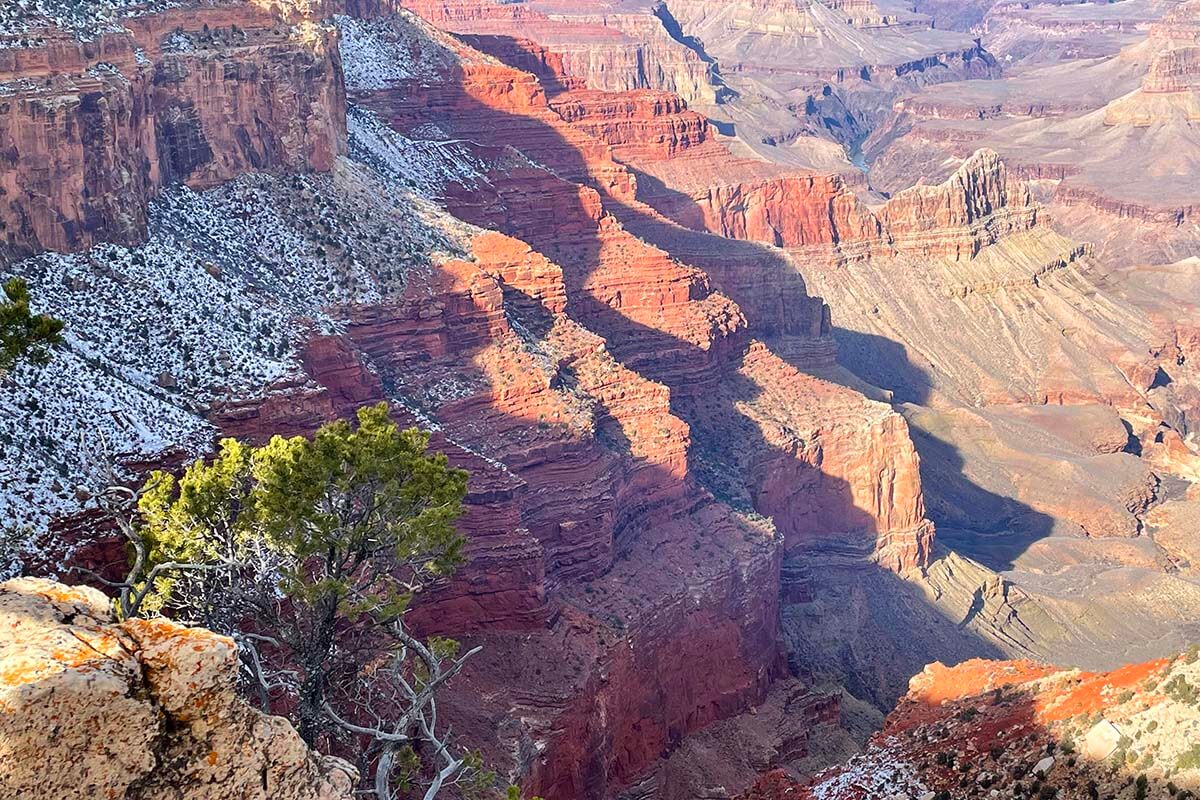
Desert View Road
Desert View Road also offers easy access to several nice viewpoints of the South Rim. The further east you drive, the more open the views, and you also see more of the Colorado River.
Some of the best viewpoints not to miss here are Grandview Point, Moran Point, Lipan Point, Navajo Point, and – all the way at the end – Desert View.
As already mentioned, both – Hermit Road and Desert View Road – can sometimes be closed in winter.
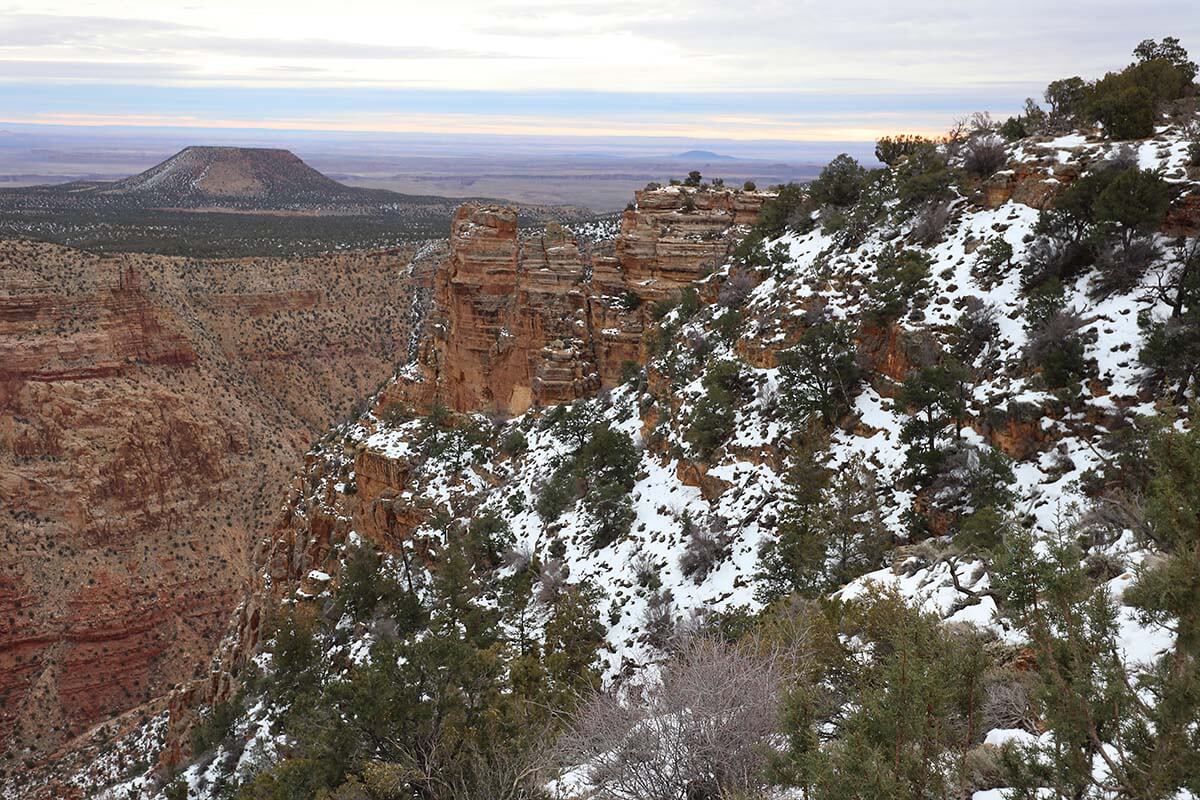
Sunrises and sunsets
Another great thing to do in Grand Canyon in winter is to watch the sunrise and/or the sunset. There are a few reasons for this.
First, the days are short in winter, so the sun comes up late and goes down early. This means that you don’t have to sacrifice much sleep in order to see the Grand Canyon in the most spectacular light.
And second, the light is spectacular indeed, especially when there is a big temperature difference between night and day. This usually means that the sky can get some spectacular colors.
Of course, you never know what you get in advance. But if you are staying nearby, it’s really not a big effort to come and see the Grand Canyon at sunrise and sunset.
TIP: Check sunrise/sunset times before you go (you can simply just search ‘sunset time Grand Canyon’) and you’ll see the exact times for your travel dates. For the best light, ideally, you get to a nice viewpoint at least 15-20 minutes before sunrise and at least half an hour before sunset.
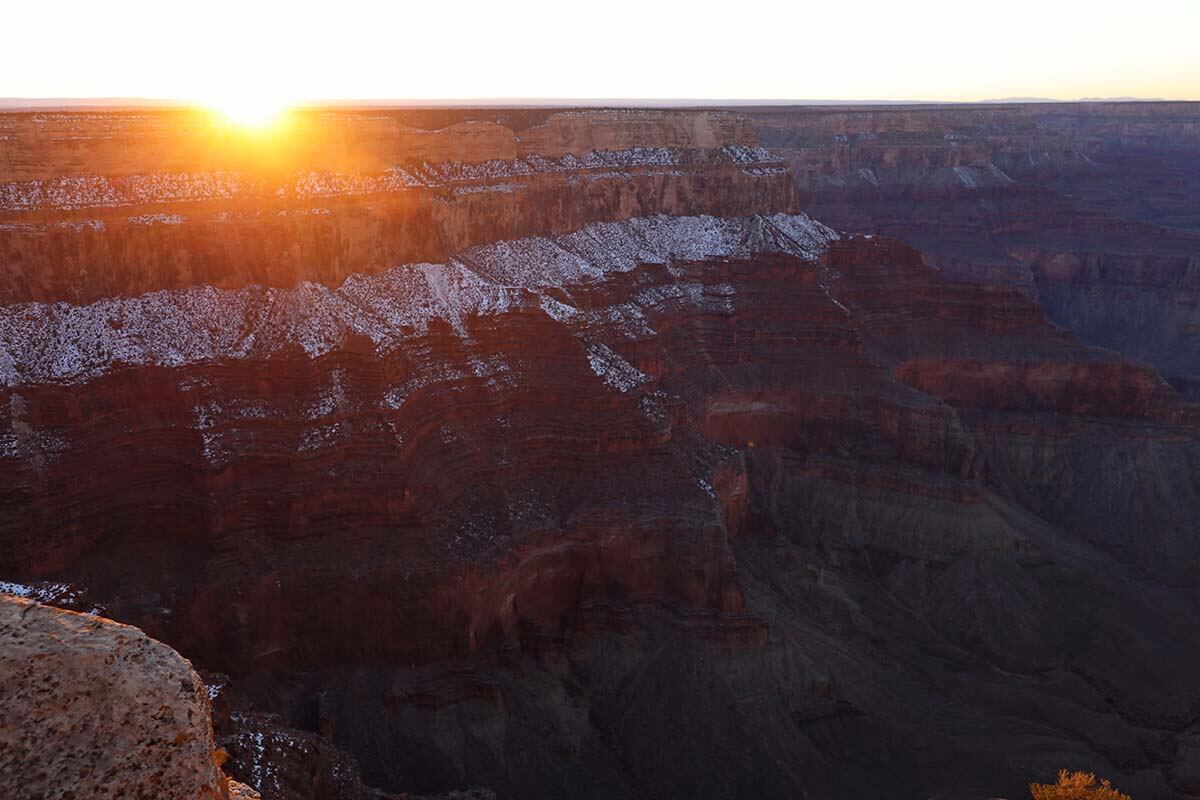
Museums, visitor centers, and gift shops
Most of the facilities at the Grand Canyon South Rim are open in the winter. This includes visitor centers, museums, shops, etc. Of course, if Hermit Road or Desert View Road gets closed because of the snow, the places along those roads will be closed too.
So if you are looking for some things to do inside, concentrate on the main area around the Grand Canyon Village.
One of the best places to see here is Yavapai Geology Museum . In addition to the exhibits where you can learn more about the Grand Canyon, they also have large panoramic windows overlooking the canyon. The view here is amazing and you can enjoy it without having to worry about the cold, the wind, or the rain.
But there are a few other places that you can check out if interested (see here ). Sometimes, they also do some tribal craft demonstrations, ranger talks, or other workshops. You’ll be able to get all this info at the visitor center.

Hiking in winter
Winter is one of the best times to hike deep into the Grand Canyon . It’s scorching hot down there in the summer and usually warm enough for shorts and t-shirts in the winter.
However, hiking trails at the top of the canyon (where you start) can be covered in ice. So you need to pack traction cleats/crampons and ideally also hiking poles if you plan on hiking at the Grand Canyon in winter.
And yes, you really need them from the moment the first snow has fallen. The trails get very icy and because it’s so cold, they remain this way during the entire winter. Because the sun is low in winter and most viewpoints face northwards, there are many places at the South Rim that remain in the shadow during the biggest part of the day.
When we visited Grand Canyon at Christmas, there hadn’t been any snow for 10 days before our trip and daytime temperatures were around 50-57 F (10-14°C). Still, there was snow and ice everywhere around us – next to the roads, at most viewpoints, and also at most hike trailheads that we saw.
We didn’t see many people hiking on longer trails, but the ones who had crampons and hiking poles could clearly do it with much more ease. Whereas the ones with regular hiking boots were scrambling at places. And if you come here in sneakers, do yourself a favor and just stick to the main viewpoints (but even those can be really icy).
If you want to do some hiking at the Grand Canyon in winter, be sure to travel well-prepared. Also, do some research so that you know exactly what to expect. And if you plan a hike, keep in mind that it gets dark very early, and coming back up will take more time than going downhill. So take all this into account and don’t forget to add some extra hiking time for the icy parts at the top of the canyon too!
TIP: It’s always a good idea to ask park rangers for recommendations and up-to-date trail conditions before you set off.
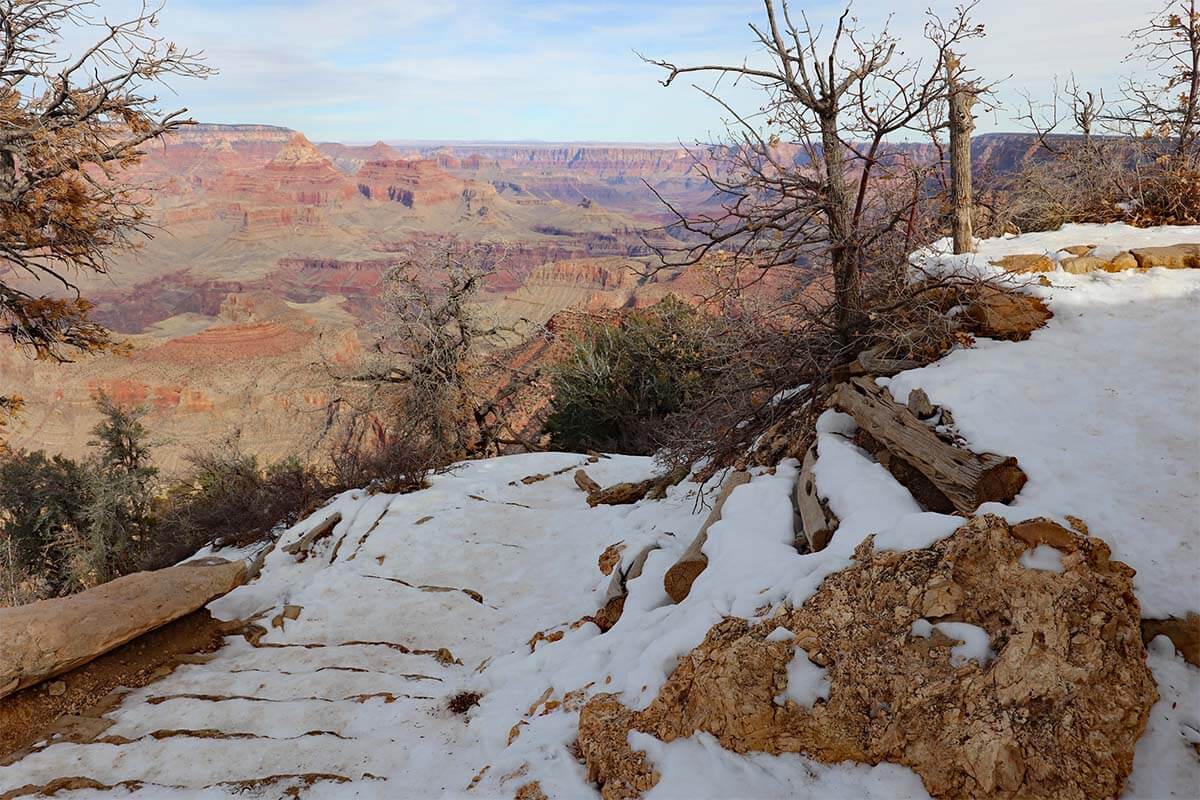
Scenic flights over the Grand Canyon in winter
Just like in any season, seeing the Grand Canyon from the air is a great experience. We once did this in summer and it was a great way to see the canyon without worrying about the heat. It’s definitely the case in the winter too, especially on a sunny day. Even if some of the roads are closed after a recent storm, but the weather is good, this is a nice way to enjoy amazing views in the coldest months.
You can opt for a scenic flight by helicopter or a small airplane .
These flights depart from Tusayan Airport, which is located just outside the southern entrance gate. Weather permitting, they are available daily during the entire year.
The links above lead you to a booking platform where you can reserve these flights in advance without any worry. You have a 24-hour free cancelation, and if the weather doesn’t cooperate, you can either cancel or reschedule the tour. And even if it gets canceled last minute because of the weather, you shouldn’t have any problems getting a refund.
Good to know: If you are staying in Las Vegas and find a day trip to the Grand Canyon in winter too much of a hassle, you can also see some amazing scenery by taking a helicopter tour from Vegas . Since Grand Canyon South Rim is over 4 hours drive from Las Vegas, helicopter tours are by far the quickest way to visit if you only have a day.
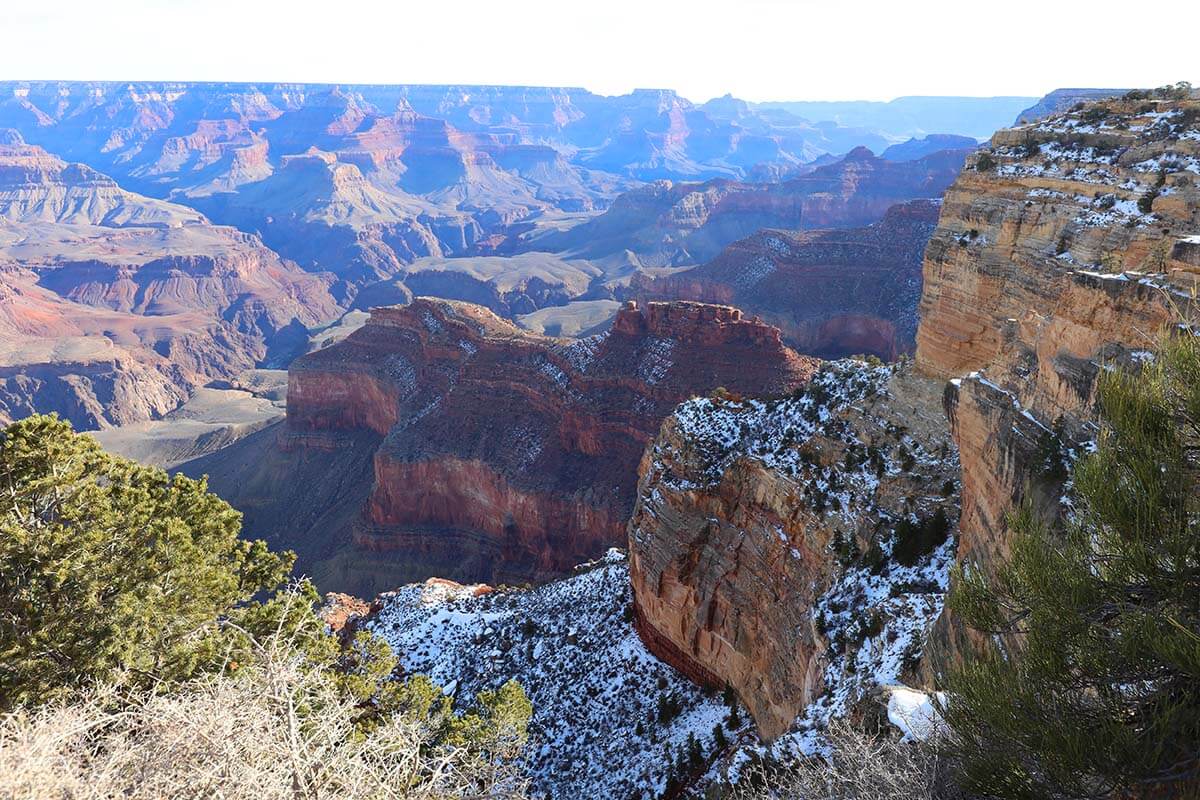
What to wear at the Grand Canyon in winter?
While this will depend on the weather, in general, you will need a warm sweater and a winter jacket when visiting Grand Canyon in the winter. We also recommend long pants, gloves, a scarf, and a hat. Shoes with a good grip are also very helpful, even if you are only visiting the viewpoints since they are often very icy.
If you are planning to go hiking into the canyon , you will definitely need sturdy hiking boots. Traction cleats and hiking poles are also highly recommended. Keep in mind that it will be much warmer inside the canyon, so you are better off wearing layers and packing a light windbreaker instead of a warm winter coat.
I would still recommend long pants if you are going hiking (hiking pants would be perfect). We saw people trekking in shorts, but if you slip on the ice and snow, it won’t be fun…
Our experience: We had a bit of a mix in terms of the weather at the Grand Canyon. Most of the time, we wore jeans, a sweater, and an insulated windproof jacket. There were moments when the jacket wasn’t necessary, but there were also moments when it was too cold with the jacket closed and we needed gloves and scarves (and were still cold).
We wore light hiking shoes (like this ) on this trip and it was perfect for exploring the viewpoints. One evening, kids went to see the sunset in their ‘city sneakers’ and they were slipping and falling all the time (partially for fun, but still).
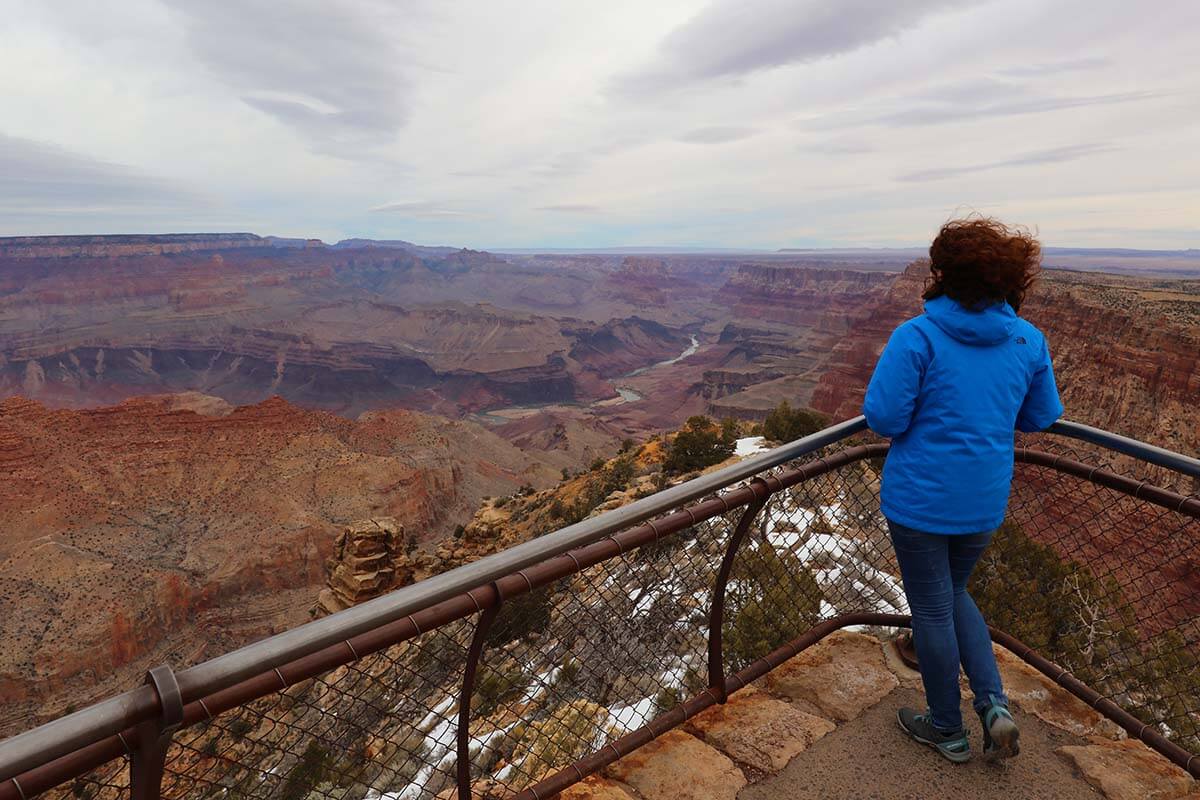
Visiting the Grand Canyon in winter can be a magical experience, especially if you are lucky with the weather.
You can enjoy the beautiful views of the South Rim without big crowds, drive Hermit Road at your own pace, and even do some hiking. White snow on the red canyon walls adds a beautiful touch to the scenery as well! Plus, you don’t have to get up early or stay late in order to see some amazing sunrises and sunsets at the Grand Canyon.
Winter is also a good time to see wildlife at the Grand Canyon.
In addition, accommodation costs are generally lower (unless you travel during the winter holidays).
But there are some drawbacks to visiting the Grand Canyon in the winter as well. The main one is the uncertainty in terms of the weather. If you are unlucky to plan your visit during a snowstorm, you won’t be able to enjoy the views, and driving conditions can be dangerous too, not even to mention that the scenic drives might get closed.
So, ideally, when planning your winter visit to the Grand Canyon, you keep some flexibility in your plans as already discussed above. Below, you can see some alternative suggestions of places to visit nearby if the weather really doesn’t cooperate.
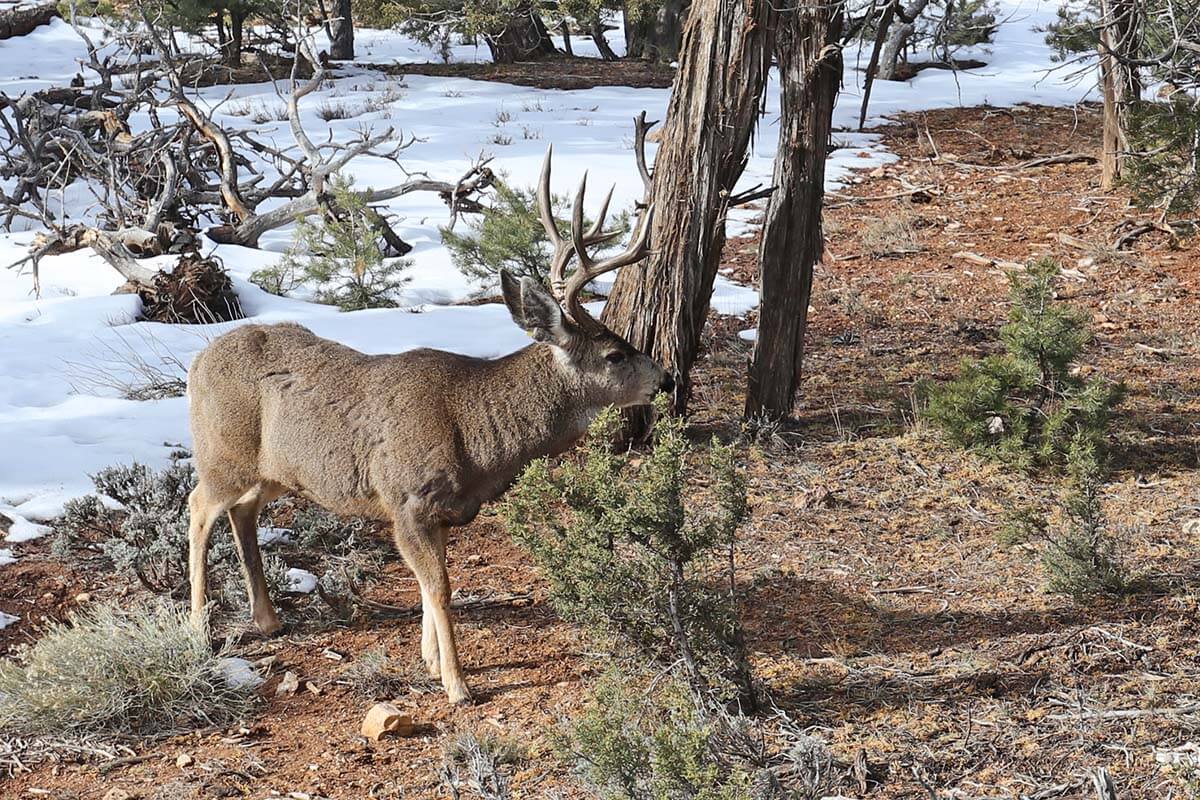
What to do if there is a snowstorm in the forecast?
Normally, a snowstorm doesn’t come unannounced and it doesn’t last very long. So if you keep an eye on the weather forecast and the warnings on the official website of the park, you should have enough time to adjust your travel plans if needed.
Good to know: If you don’t go hiking, you only really need a day in order to see the best of the Grand Canyon. So you should be able to find a good-weather day for a visit if you are in the area for at least a couple of days.
LEARN MORE: Grand Canyon in One Day
Also, there are many amazing places in Arizona where the elevation is much lower than at the Grand Canyon South Rim, and the chances of winter weather ruining your travel plans there are very slim. So you can always switch your planning around and explore some of the best places in Arizona on snowy days.
For example, Sedona is one of the best alternatives just a few hours drive from the Grand Canyon. Also Monument Valley or Antelope Canyon can be good alternatives, depending on your overall itinerary. But for the latter, you should check if there are still any tours available before you decide to drive there.
Also, Las Vegas and its surroundings can be a good alternative in case of bad weather at the Grand Canyon. It’s always much warmer there and there’s plenty to see and do in Las Vegas in any weather.
Oh, and if you are stuck inside, at the Grand Canyon itself, you will be glad if you chose a really nice hotel with good facilities . For example, our hotel had a nice restaurant, a bar, an indoor pool, and a hot tub. All this really helps when the evenings are dark and cold, not even to mention if the weather is not great.
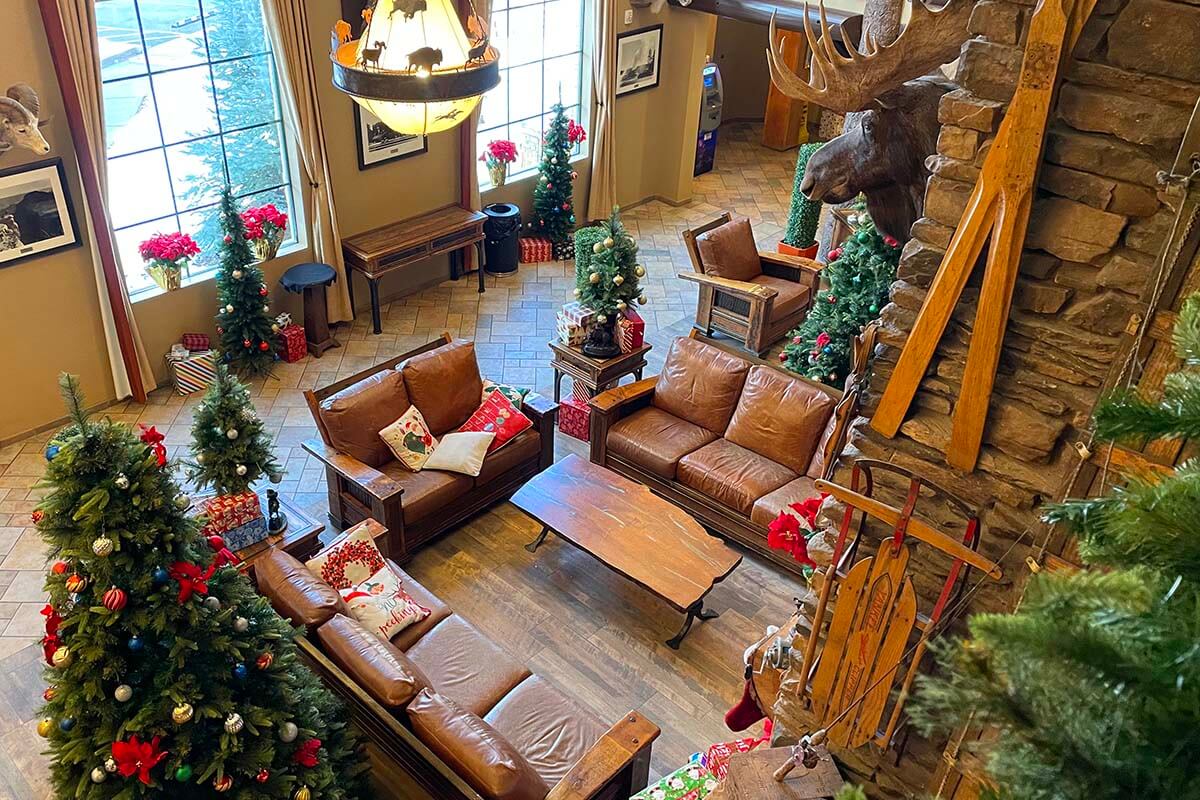
Grand Canyon Winter FAQ
Yes, you can visit the Grand Canyon in winter. While the North Rim is closed, Grand Canyon West and Grand Canyon South Rim can both be visited in winter.
The nicest part of the Grand Canyon is the South Rim and it’s open the whole year round. This is the area that we recommend visiting, also in winter.
Average temperatures at the Grand Canyon Village are around freezing point. The average lows in December, January, and February are 18 F (-8°C) and average highs are 45 F (8°C). At the same time, it can be around 60 F (15 °C) on the canyon floor. The weather can change quickly in winter, and so does visibility, so be sure to check the weather forecast when planning your visit.
Yes, snow is very common in Grand Canyon National Park in winter. It doesn’t snow every day, but when it snows, visibility can be limited and driving conditions can be challenging. Also, because of the high elevation and cold nights, the snow doesn’t melt quickly. So you will see snow at the Grand Canyon pretty much during the entire winter.
Most of the facilities at the Grand Canyon Village are open the whole year round, so also in winter. But there is also a possibility that some roads (Hermit Road and/or Desert View) can be closed during or just after the snowstorm.
Yes, the main Grand Canyon park shuttles – Village Route (Blue) and Kaibab Route (Orange) – run in the winter months as well. Hermit Road shuttle (Red Route) doesn’t operate in December, January, and February, so you can explore this scenic drive in your own car. Also, Tusayan Route (Purple) doesn’t operate in the winter.
Yes, absolutely, Grand Canyon is more than worth a visit in the winter months. It’s usually not too busy, the air is crisp and the views are amazing, plus the scenery with a touch of snow is even more spectacular than in the warmer months. You just have to keep an eye on the weather forecast and adjust your travel schedule if needed.
So, this is our guide to visiting the Grand Canyon in winter. I hope that it gives you a better idea of what you can expect and helps you plan an unforgettable visit.
Have a great trip!
More travel inspiration for the Southwestern USA:
- Bucket list trip: Grand Canyon, Antelope Canyon & Horseshoe Bend 2-day Itinerary
- Arizona: Top Places to Visit in Arizona & Monument Valley Scenic Drive
- Las Vegas: Tips for Visiting Las Vegas & Best Things to Do in Las Vegas & Best Day Trips from Las Vegas
- Death Valley NP: Best Things to Do in Death Valley
- Gold Butte, NV: Travel Guide to Gold Butte National Monument
- Sedona, AZ: Best Things to Do in Sedona & Sedona Day Trip
- Zion, UT: Best Hikes in Zion National Park & Zion to Bryce Canyon & Where to Stay in Zion
- Moab, UT: Moab, Arches, and Canyonlands National Park
- Arches NP, UT: Best Things to Do in Arches National Park
- Canyonlands NP, UT: Best Things to Do in Canyonlands National Park
If you found this post useful, don’t forget to bookmark it and share it with your friends. Are you on Pinterest? Pin these images!
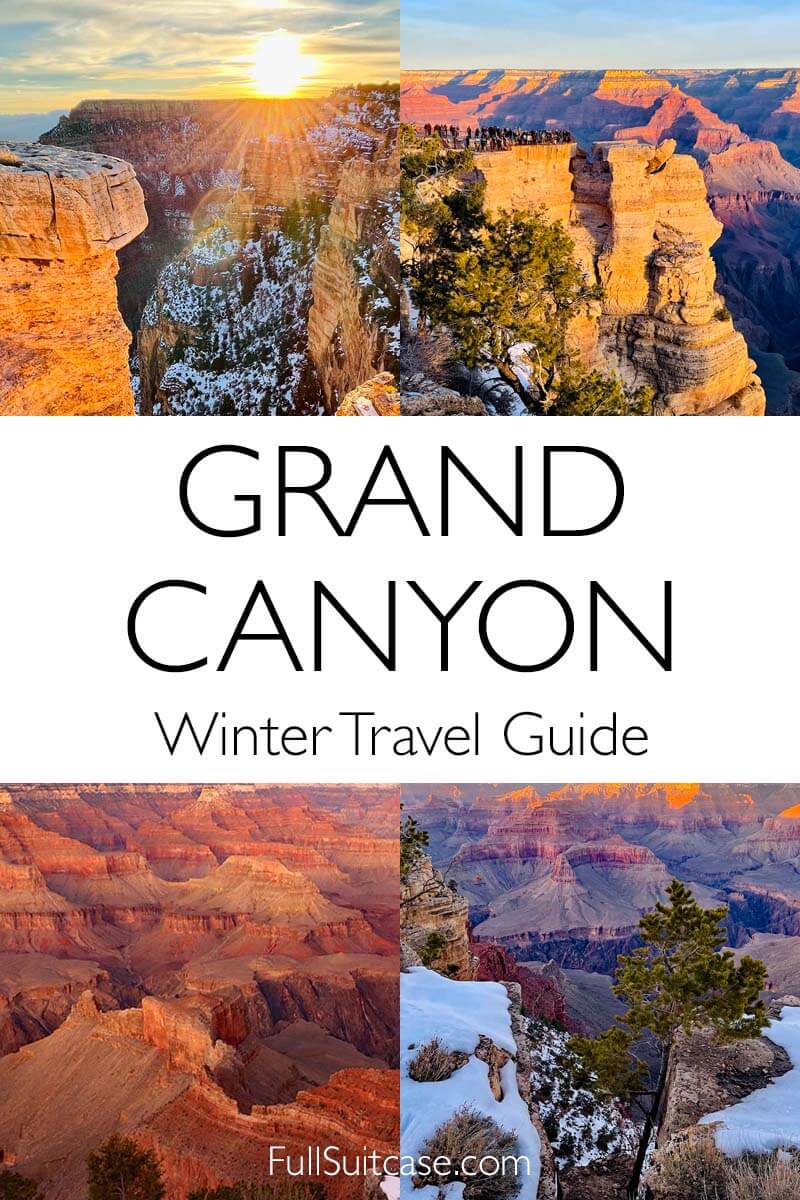
Seasonal travel inspiration for the USA:
- USA National Parks to Visit in November
- USA National Parks to Visit in December
- USA National Parks to Visit in January
- USA National Parks to Visit in February
- USA National Parks to Visit in March
This site uses Akismet to reduce spam. Learn how your comment data is processed .
Sunday 19th of February 2023
I have a trip scheduled later this week and will be at GC 2/24 to 2/26. The forecast looks like lots of snow, so I'm wondering, if both Desert View Road and Hermit Road get closed, is it worth going? What would we be able to see? What parts? Thanks in advance.
Monday 20th of February 2023
Hi Angela, if all the roads get closed, the only part that usually remains open is the Grand Canyon Village. There are some amazing viewpoints there such as Yavapai, Mather Point, etc. It’s only really not worth it if it’s misty/cloudy and all the views are covered (= usually during snow storm). Otherwise, it’s definitely worth going especially if you haven’t been before and this is your only chance. Keep an eye on the weather forecast a few days before your travel dates and decide at that time. From what I see now, the weather is great at the moment, then there is some snow on the forecast, and it looks better again towards the end of the week. Hope it works out well for you. Have a great trip!
Monday 30th of January 2023
Your article brought back many wonderful memories of a trip to USA from Australia in 2005. Thank you! I took my children (then aged 22 and 17) for what I thought might be the last time they'd want to travel with their mother! We stayed at the Grand Canyon for 2 days over Christmas, a truly magical time to be there. Snow outside, big fires and wonderful decorations inside. It was cold (of course) but we rugged up and drove or walked to several viewing points for the most breath-taking views imaginable. And the most special Christmas treat for all of us was a helicopter ride over the Canyon. So majestic and beautiful. I don't recall having any difficulty driving to and from the Canyons or on any of the roads around We'd all love to re-visit.
Your experience at the Grand Canyon at Christmas sounds very similar to ours, Margaret. If the weather cooperates, it's a truly magical time to be there! Happy travels!
Sunday 29th of January 2023
We have been to the Grand Canyon 3 times, all in the hot summer months. One time, we hiked down to Supai and my wife was fretting about us running out of water and having only fruit juice left that may not keep our boys from getting dehydrated. She was really worried about that but we made it to Supai village and we all lived through the ordeal.😀😀
I know how your wife must have felt, Michael! We once visited in July and ran out of water on the Rim Trail and even that was not the most pleasant experience. Going down into the canyon without having enough water to stay hydrated can be really dangerous in the summer. They say that even in winter you need to carry a lot of water if hiking into the canyon.
Wednesday 18th of January 2023
Hi Jurga, this is a very timely post. We will be in the area in a few weeks time and I was wondering what to expect. Thanks for the tip to check the facebook account of the park. I saw that they got tons of snow recently and are posting updates about road closures and when they get open again so I will keep an eye on it before our trip. Hopefully we get nice weather as you did!
Thursday 19th of January 2023
Hi Adele, glad to hear that you found some useful tips for your trip. Fingers crossed you get nice weather too! But - as I think I mentioned in the article - you only need a day if you just want to see the viewpoints. So it's usually not a big issue to adjust your itinerary a bit if the forecast would be really unfavorable. And indeed, they did get quite some snow at the Grand Canyon in the last few weeks. Hopefully, it stabilizes again. This winter, the weather has been quite extreme in many parts of the USA... Have a great trip!
Grand Canyon National Park Travel Guide
Courtesy of Piriya Photography | Getty Images

Best Times To Visit Grand Canyon National Park
The best times to visit the Grand Canyon are March through May and September through November, when daytime temperatures are cool and crowds are thin. If you decide to visit during the summer (the park's peak season), be prepared for hordes of tourists and very limited lodging availability. You can find deals on hotels during the winter, but much of the park (including the entire North Rim ) closes after the first snowfall. The South Rim is open throughout the year.
Weather in Grand Canyon National Park
Data sourced from the National Climatic Data Center
Find Flight and Hotel Deals
Navigate forward to interact with the calendar and select a date. Press the question mark key to get the keyboard shortcuts for changing dates.
Navigate backward to interact with the calendar and select a date. Press the question mark key to get the keyboard shortcuts for changing dates.
Popular Times to Visit Grand Canyon National Park
Tourism volume is estimated based on in-market destination search query interest from Google and on travel.usnews.com in 2015-2016. Hotel prices are sourced from a sample of U.S. News Best Hotels rates through 2015-2016.
Explore More of Grand Canyon National Park

Things To Do

Best Hotels

You might also like

# 1 in Best Party Cities in the U.S.

# 2 in Best Day Trips from Phoenix

# 5 in Best Day Trips from Phoenix
If you make a purchase from our site, we may earn a commission. This does not affect the quality or independence of our editorial content.
Recommended
The 18 Best Napa Valley Wineries to Visit in 2024
Lyn Mettler|Sharael Kolberg April 23, 2024

The 25 Best Beaches on the East Coast for 2024
Timothy J. Forster|Sharael Kolberg April 19, 2024

The 50 Best Hotels in the USA 2024
Christina Maggitas February 6, 2024

The 32 Most Famous Landmarks in the World
Gwen Pratesi|Timothy J. Forster February 1, 2024

9 Top All-Inclusive Resorts in Florida for 2024
Gwen Pratesi|Amanda Norcross January 5, 2024

24 Top All-Inclusive Resorts in the U.S. for 2024
Erin Evans January 4, 2024

26 Top Adults-Only All-Inclusive Resorts for 2024
Zach Watson December 28, 2023

Solo Vacations: The 36 Best Places to Travel Alone in 2024
Lyn Mettler|Erin Vasta December 22, 2023

26 Cheap Beach Vacations for Travelers on a Budget
Kyle McCarthy|Sharael Kolberg December 4, 2023

The 50 Most Beautiful White Sand Beaches in the World
Holly Johnson December 1, 2023

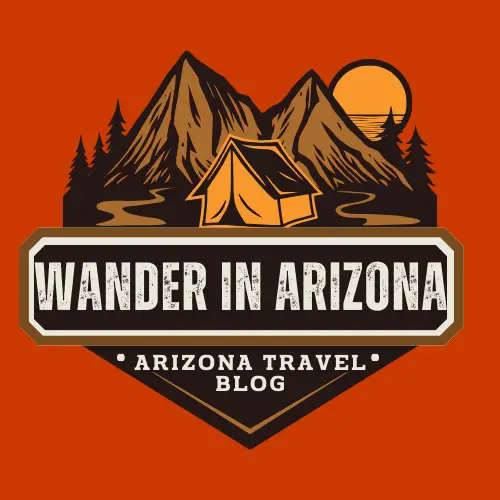
WANDER IN ARIZONA
ARIZONA TRAVEL BLOG
A Guide For Visiting Grand Canyon In Winter
- Recent Posts
- HIGHWAYS & VORTEXES: A PHOENIX TO SEDONA ADVENTURE - February 27, 2024
- FROM CACTI TO CANYONS: THE PHOENIX TO BISBEE ROAD TRIP YOU NEED - February 21, 2024
- TUCSON TO BISBEE – A ROAD TRIP LESS ORDINARY! - February 21, 2024
Visiting the Grand Canyon in winter may not be the idea you think of when planning a trip to this national park.
Most US national parks remain open throughout the winter, and the same goes for Grand Canyon.
Grand Canyon in winter looks even more fascinating and is one of the secret seasons many do not know.
Colder temperatures, shorter days, and snow bring fewer people. Still, the skies are the clearest, and the temperatures are the coolest, making it one of the fabulous winter getaways in Arizona.
In this detailed guide, we’ll share what to do in Grand Canyon in winter, winter weather in Grand Canyon, helpful tips, and things to do in Grand Canyon in the winter months.
Table of Contents
VISITING GRAND CANYON IN WINTER – THINGS TO KNOW
Should you visit grand canyon in winter.
Yes, it is worth visiting Grand Canyon in winter. The Grand Canyon during winter is spectacular, and it may be even better for you if you love snow-sprinkled landscapes.
The winter season sees the lowest number of tourists – a significant factor to consider when you plan a trip to one of the most visited national parks in the United States and the most seen among Arizona National Parks .
The temperatures are much lower, unlike typical baking hot Arizona weather, and the unique landscapes look distinct, making you instantly fall in love with its fascinating panoramas.
WHAT IS THE WEATHER LIKE IN GRAND CANYON IN WINTER?
With a vast difference in elevations throughout the park, which ranges from 2000 feet to 8000 feet, the weather changes rapidly and is unpredictable.
Winter is still a great time to visit Grand Canyon. Winter Weather typically begins in November, and fog can occasionally form sometimes.
But the unpredictable means you get to see stunning landscapes, especially if you happen to be in Grand Canyon in Winter after heavy snow pours without any haze.
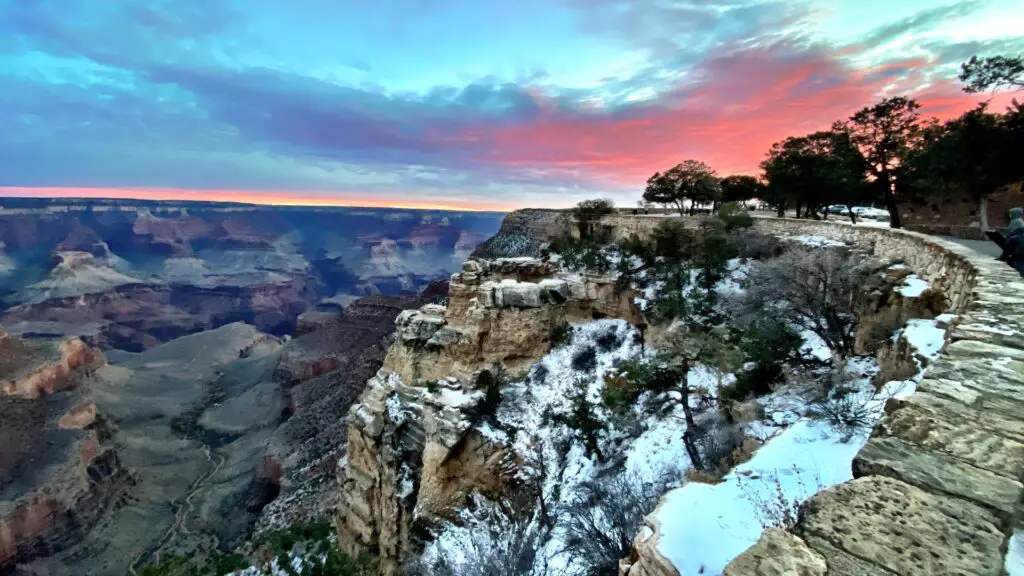
Grand Canyon weather in winter can be freezing and windy, so be prepared.
In December and January, average daytime temperatures reach 7°C and drop to -8°C at night. February is slightly warmer, with a slight temperature uptick, but it will still be in the single digits.
The temperatures are relatively higher than the rim, where the low temperatures prevail.
DOES IT SNOW IN GRAND CANYON IN WINTER?
Yes, it does snow in Grand Canyon. For the best chances of viewing snow-carpeted landscapes, check out the North Rim, which gets the most snow, averaging from 50 to 100 inches annually, while the South Rim gets slightly less.
You can see snowfall in Grand Canyon if you visit during December, January and February when the chances are highest.
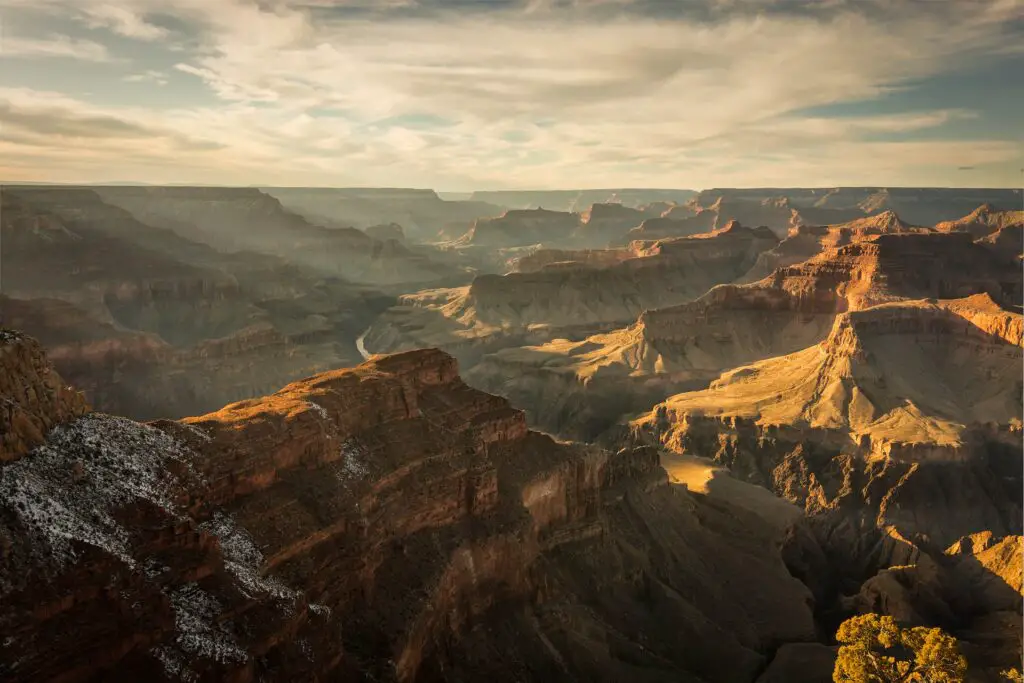
By March, most areas would be clear as it starts melting, with some snow remaining at higher elevations even in April, depending on the intensity each year.
IS THE NORTH RIM OPEN DURING WINTER?
Yes, the North Rim remains closed from the 1st of December to the 15th of May, sometimes even earlier, as the region gets heavy snowfall, including State Route 67 south of Jacob Lake. The hotel, restaurants, store and gas station are closed as well usually.
IS THE SOUTH RIM CLOSED IN WINTER?
While the North Rim remains closed throughout winter and spring, the South Rim is open to visitors with many attractions and activities to explore.
But note that trails and roads can be slippery, and it is best to check with rangers and stay on course, especially if you plan to hike during winter.
Many hotels, campgrounds and shops on the South Rim also operate regularly during the winter months.
IS IT POSSIBLE TO DRIVE IN GRAND CANYON IN WINTER?
Driving in Winter at Grand Canyon may sometimes be challenging, mainly if snowstorms occur. Although roads are cleared regularly after a heavy snowfall, they may be closed for a time until the snow is cleared.
Check for live road conditions and weather forecasts before you start.
It is best to be prepared for winter driving, including snow, ice and high wind.
Both roads in and out of the Grand Canyon remain open in winter. The Desert View Drive remains open during winter, offering you to stop at many points along the way.
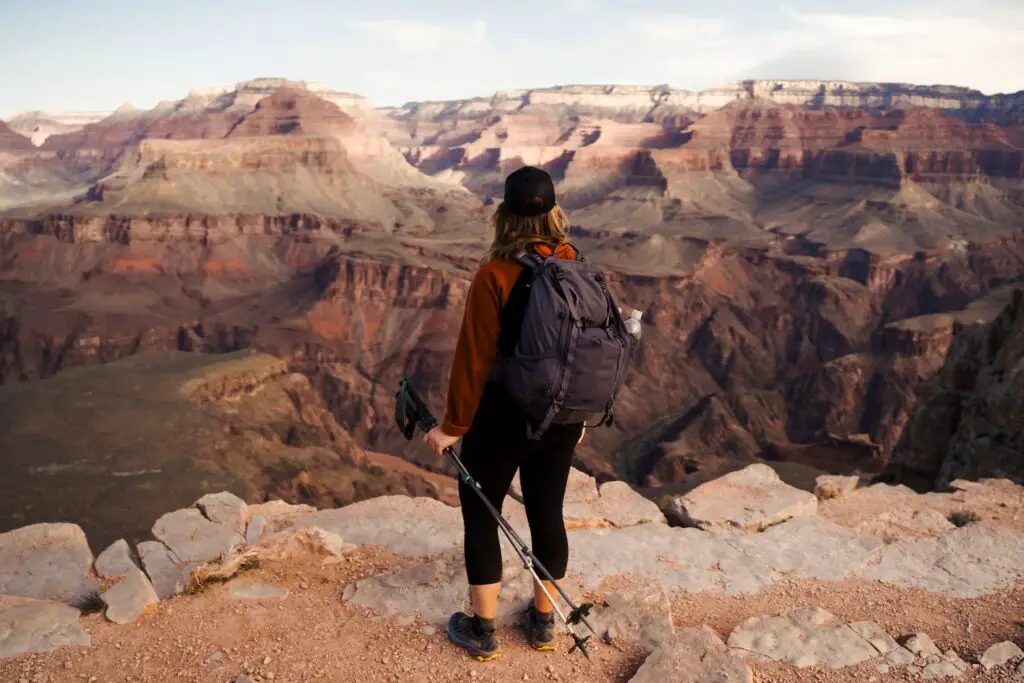
The Hermit Road or the Hermits Rest Route, from the South Rim area, remains closed for vehicular traffic for the rest of the year and is only accessible via the shuttle bus.
But one of the parks of arriving at the Grand Canyon in winter is during December, January, and February. You can drive along Hermit Road and access parking in specific areas to access hiking trails and viewpoints.
Since plenty of attractions, trails and viewpoints offer gorgeous panoramas; you will love driving on Hermit Road in winter.
IS CHRISTMAS A GOOD TIME TO VISIT GRAND CANYON?
Yes, Christmas is a great time to visit the Grand Canyon, with only fewer tourists and excellent views, pleasant weather, and many viewpoints, camping sites, and hiking trails ideal for exploration in the rugged outdoors.
CAN YOU HIKE IN GRAND CANYON IN WINTER?
Yes, the trails are open. Winter is a great time to hike in Grand Canyon.
Compared to summer, when the temperatures are high and scorching, winter has delightful temperatures. Visibility is greater. The air is clear in winter, without fog lasting all day, common in summer.
But winter at 7,000 feet can mean cold temperatures, snow and ice, and common storms, which usually lead to road closures and make hiking trails dangerous.
While any trail into the canyon is strenuous, winter presents more difficulties. The upper reaches of the trails are often snow-covered and slippery.
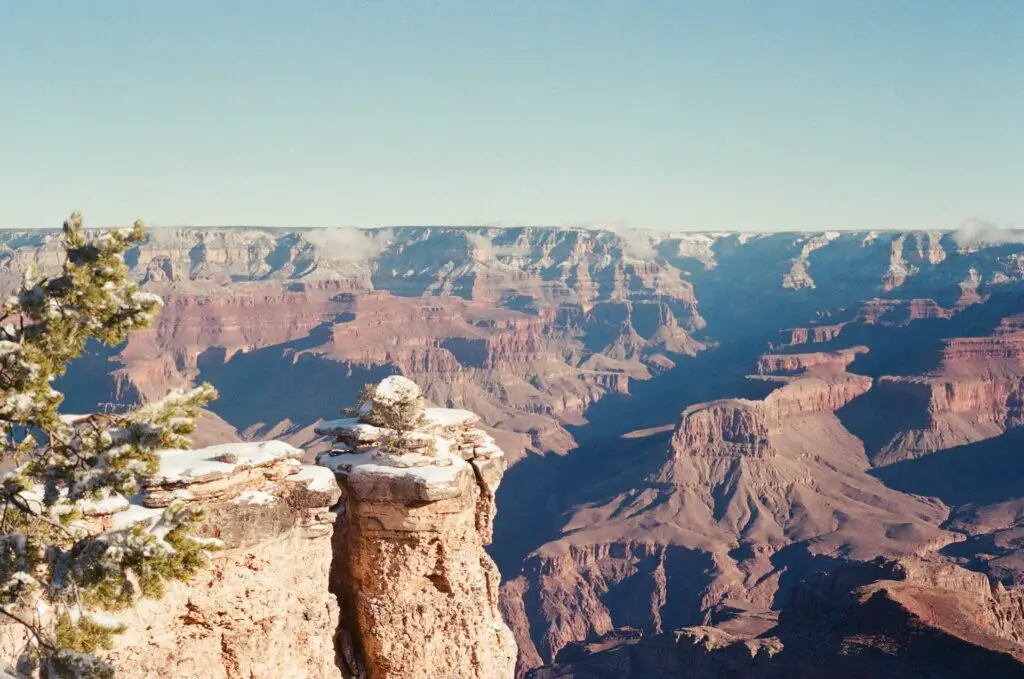
Since you’ll be hiking down first and then up – Grand Canyon is mostly an inverted mile-high mountain so that you will feel it the most challenging on the return trip.
Dress in layers to stay warm and dry. Keep emergency supplies in your vehicle. Check for weather and trail conditions before your trip. Use traction devices for hiking boots and trekking poles for added safety.
If you want to hike into the canyon and stay overnight, don’t forget you must apply for a Backcountry Permit .
Read further below for details of all the trails available for winter hiking in the Grand Canyon.
RECOMMENDED FOR YOU – 18 NATIONAL MONUMENTS IN ARIZONA YOU SHOULD NOT MISS
IS CAMPING POSSIBLE IN GRAND CANYON IN WINTER?
Yes, it is possible to camp during winter in Grand Canyon. You need a backcountry camping permit and reservations to access camping. Check more details about camping below.
HOW MANY DAYS TO SPEND AT GRAND CANYON IN WINTER?
You can easily cover the highlights and major attractions of the Grand Canyon over a weekend, including driving to all panoramic spots along Desert View Drive.
You can also hike some short sections of the Rim Trail, and walk the interpretive trail around Mather Point.
But if you plan to do other hikes like the South Kaibab Trail or even Angel’s Landing or if you want to camp, you’ll need another day or two more.
HOW TO GET AROUND GRAND CANYON DURING WINTER?
You can take a shuttle or drive around Grand Canyon, depending on what you prefer. Find more details on this in the further sections.
THINGS TO DO IN GRAND CANYON IN WINTER
Stop at the visitor centre.
The best way to acquaint yourself with everything you need to know to explore the Grand Canyon in winter is to stop at the visitor centre first, located in the south entrance station at the south rim.
You can get detailed information about the weather conditions, road closures, details and the current status of hiking trails.
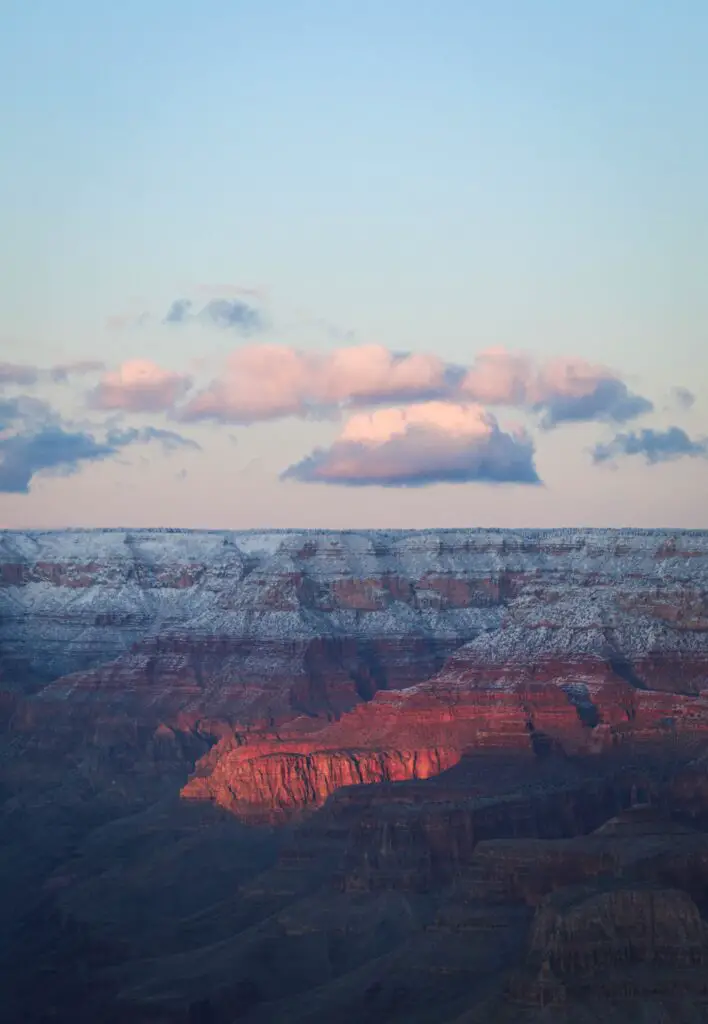
When you are at the visitor centre, do not miss Mathers Point, a five-minute walk away and a popular viewpoint thanks to the splendid views of many landmarks here.
Opening hours – 9 AM to 4 PM
ENJOY LUNCH IN GRAND CANYON VILLAGE
The Grand Canyon Village, located on the South Rim, is a popular spot among tourists to stop by to relax, dine, and shop between driving and hiking the Grand Canyon.
Most of these restaurants also offer beautiful panoramic views thanks to their stunning location.
One of the recommended places to have lunch is the Arizona Room, a part of Bright Angel Lodge, offers incredible views over the Grand Canyon near the Bright Angel Trail trailhead.
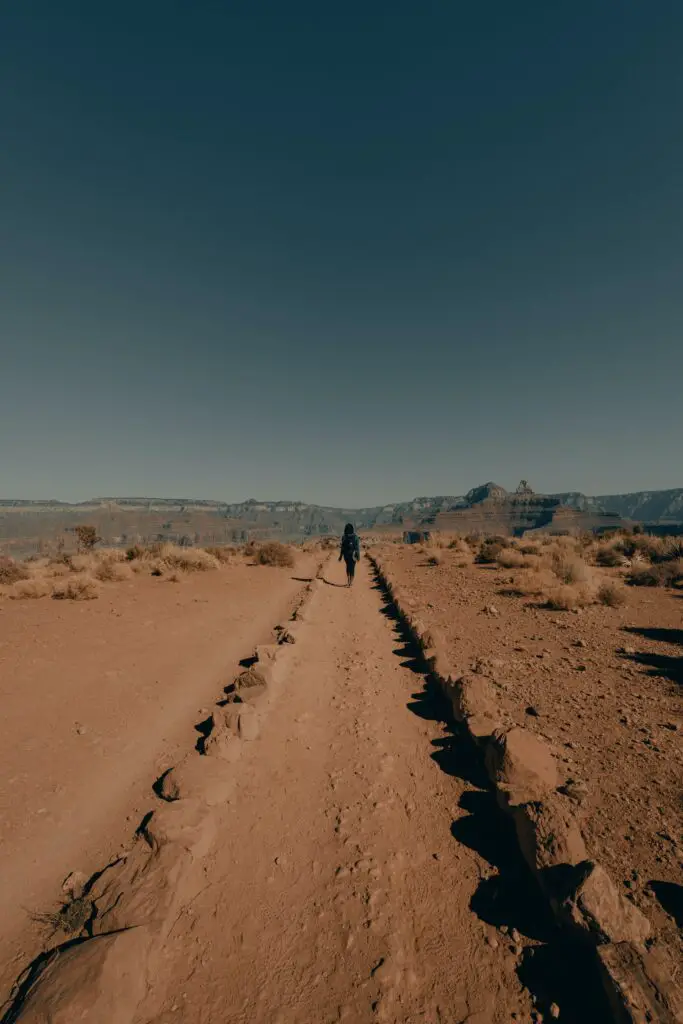
Other popular spots are El Tovar Dining Room, and the Maswik Food Court, if you want to dine on a budget.
CHECK OUT TOP ATTRACTIONS VIA A SHUTTLE
If it’s snowy or you do not prefer driving, one of the best ways to get around prominent attractions and viewpoints in the Grand Canyon in winter is by taking a shuttle bus to the views rather than driving yourself.
The shuttles are the best and safest choice if you are not a seasoned driver having experience in driving in winter conditions in ice and snow.
There are four shuttle bus routes around the Grand Canyon South Rim – orange, blue, red and purple. Only two, orange and blue, operate in the winter from December 1 through February.
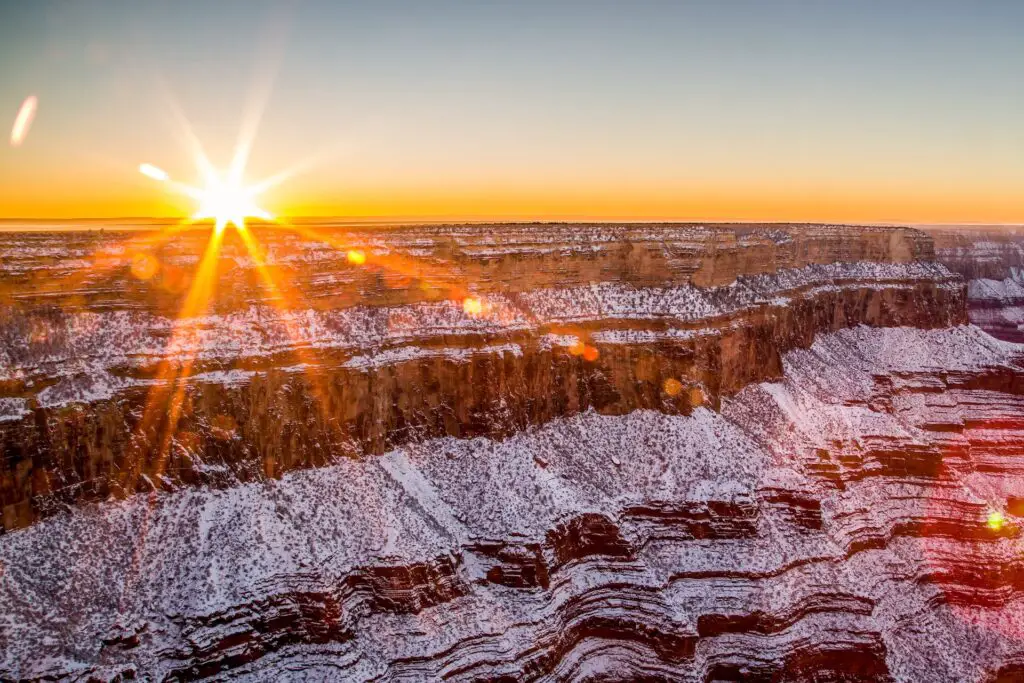
The orange route, Kaibab Rim, beginning at the visitors centre, leaves every 30 minutes. It is the best route to check out many top attractions for free.
This route, connecting the visitor centre to the South Kaibab trailhead, stops at many gorgeous viewpoints, including Mathers Point, Yavapai Geology Museum, South Kaibab Trailhead, Yaki Point and Pipe Creek Vista.
The Village Route (blue) starts from the visitor centre to locations around Grand Canyon Village.
DRIVE TO BEAUTIFUL SPOTS
If you are into hiking or prefer avoiding hiking during your winter visit, one of the easiest and most convenient ways to explore the Canyon is by driving to all the various viewpoints along the rim.
Overall, there are 32 miles between Desert View, the easternmost viewpoint, to Hermits Rest in the west available for driving.
The views get more fascinating as you head towards the west.
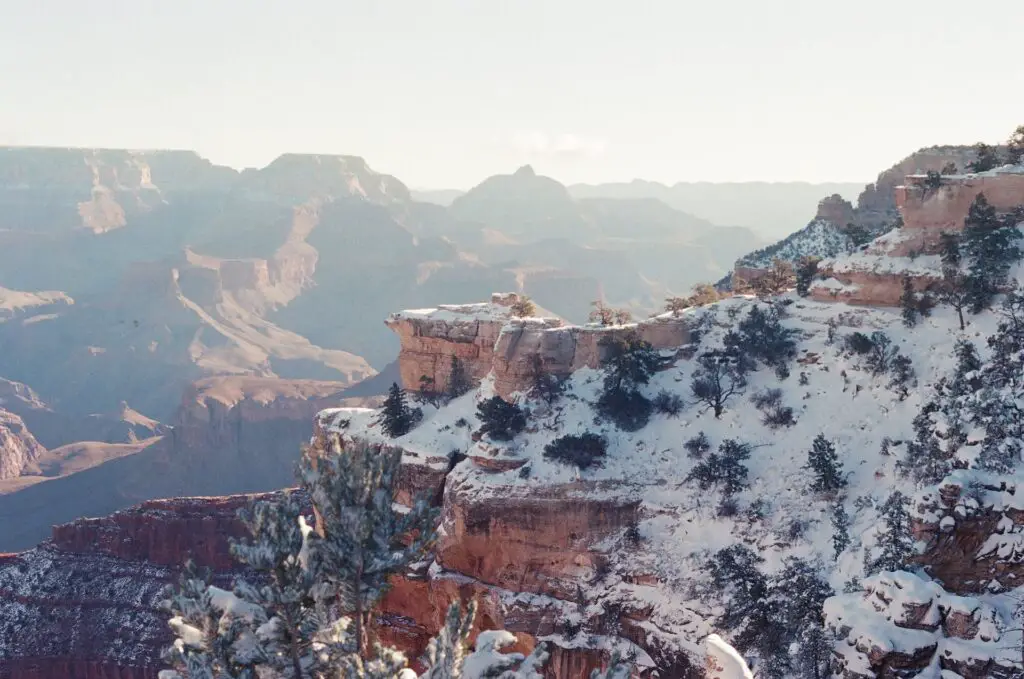
Hermit Road, at the west end of the south rim, is a popular 7-mile route that takes you along many panoramic viewpoints. Winter is the only time of the year when this road is open to private vehicles, so make the most of this!
Along this route, stop at the many best Grand Canyon viewpoints, including Grandview Point, Moran Point, Yaki Point, Hopi Point, Mohave Point and Pima Point.
If you do not want to drive in the snow, take the Orange Shuttle running every 30 minutes, which stops at major viewpoints.
ENJOY THE GORGEOUS SUNRISE AND SUNSET
Grand Canyon offers spectacular sunsets and sunrises, and you can view them at different points scattered in the national park.
Among the most popular stop for watching sunrise and sunsets in Grand Canyon is Hopi Point along the south rim offering incredible panoramic views of the canyon
Yavapai Point is another best spot to see the splendid colours of sunset and magnificent views of the Grand Canyon, accessible by a short walk from the visitor centre.
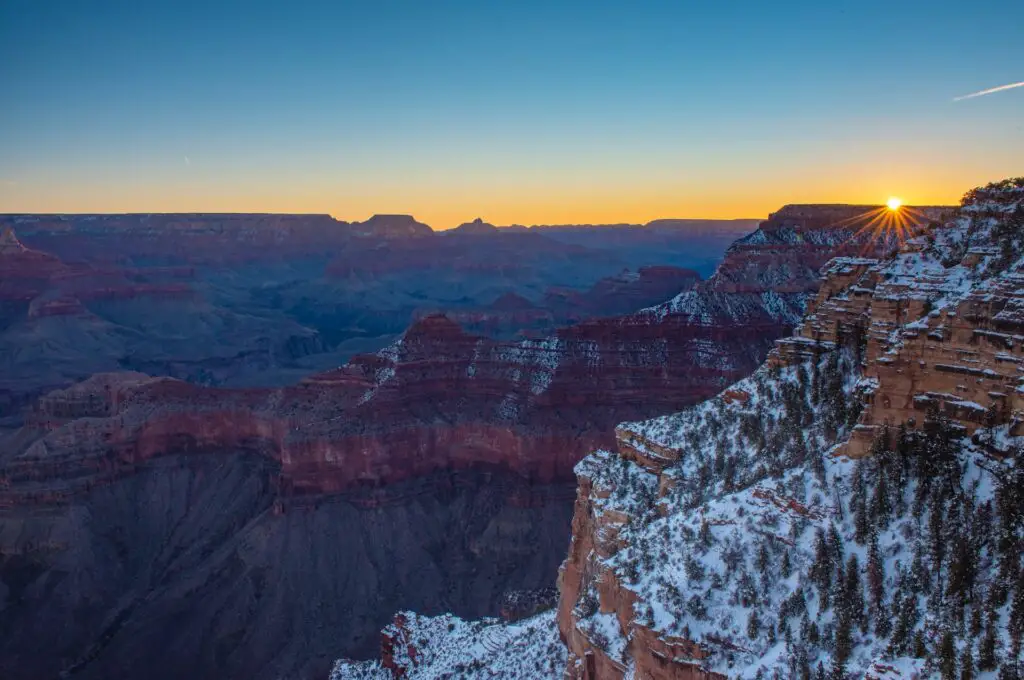
The after colours are gorgeous when the sky gets painted with brilliant hues of orange, golden, yellow, red, pink and purple, so stay for some time after the sun goes down.
There are a few advantages of visiting in winter.
Apart from fewer crowds, the sunrise and sunset happen relatively later than during summer, which means you do not have to wake up at 5 AM to run early and secure a spot!
RECOMMENDED FOR YOU – 10 TOP SPOTS TO WATCH SEDONA SUNRISES
GO FOR WINTER HIKES
Winter in the Grand Canyon is perfect for hiking. Apart from almost empty trails, you will have pleasant weather to enjoy the stunning snow-blanketed views.
The trails around the rim are relatively easier and suitable for beginners. Below are the trails worth exploring in the Grand Canyon during winter.
BEST HIKES IN SOUTH RIM
Hermit trail.
Distance – 13 miles; Elevation – 200 ft; Duration – 6 hours
The entire trail is known as Rim trail, a flat, mostly paved trail beginning from South Kaibab Trailhead to Hermits Rest on the western side, running along the edge of the Grand Canyon for about 13 miles. But you can hike just part of it and take the shuttle bus back.
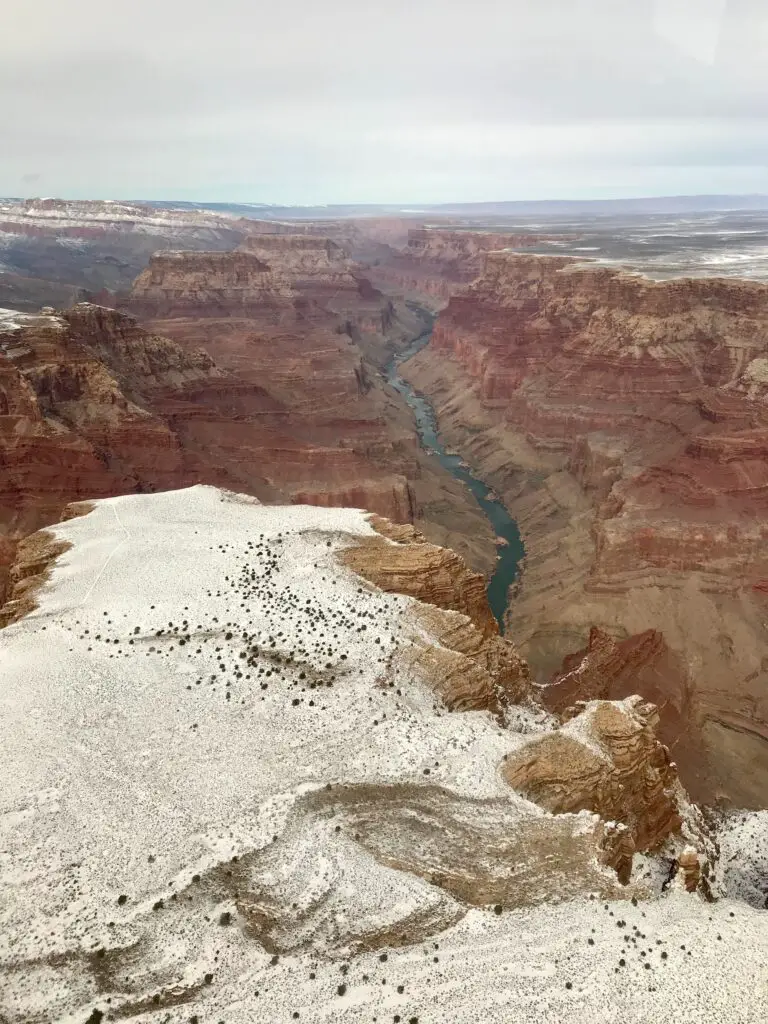
The first part of the trail, from South Kaibab Trailhead to the visitor centre, and the last part past the Village to Hermits Rest is known as the Hermit trail.
Another popular section of the trail is the 1.5 miles path between the visitor centre and Yavapai Point, approximately 1.5 miles, offering some beautiful panoramas.
BRIGHT ANGEL TRAIL
Distance – 12 miles; Elevation – 2900 ft; Duration – 10 to 12 hours
If you have more than two days in Grand Canyon, one of the recommended things to do in the Grand Canyon in winter is go on a day hike along Bright Angel Trail.
It is a strenuous hike only recommended if you are a seasoned hiker.
It is a well-maintained trail that will reward you with splendid views of the Canyon, but an additional challenge when doing it in winter is that the initial part of the trail is steep and slippery as it is layered with ice.
It is best to carry hiking poles and traction devices.
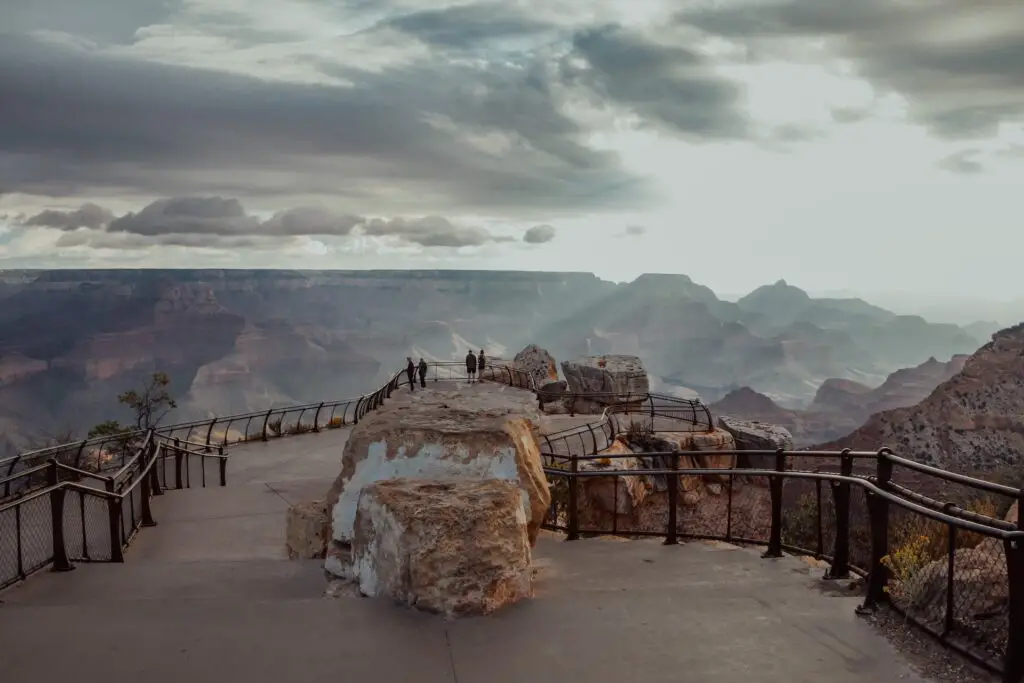
You can only hike until Plateau Point for completing in a day, which is about 12 miles. Although it may feel like a short distance, the elevation will take longer.
You can turn back after reaching other points along the way if you want shorter versions of this hike.
SOUTH KAIBAB TRAIL
Distance – 6 miles; Elevation – 1500 ft; Time – 4 to 5 hours
Another among the longest and most popular hiking trails enjoyable in Grand Canyon in winter is the South Kaibab trail.
The 16-mile round-trip with over 4,000 feet of elevation change is best done over 2-3 days, including camping, as it involves descending all the way into the canyon to the river and hiking back up
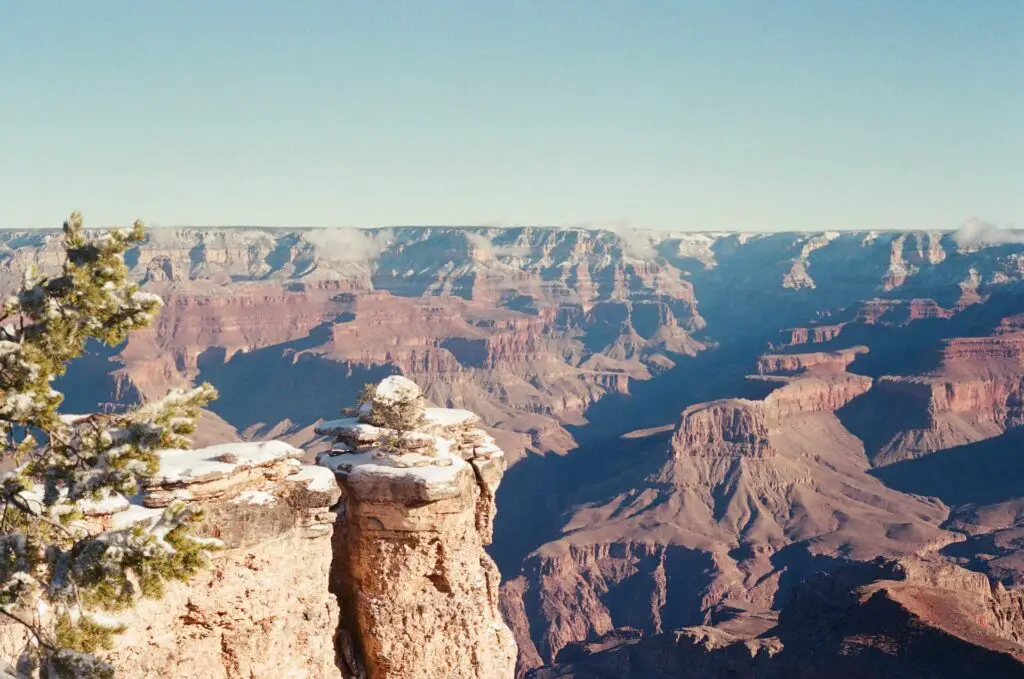
You will need the Backcountry Permit for this hike.
If you do not want overnight camping in winter, you can also hike part of the South Kaibab Trail as a day trip until the recommended point by NPS, Skeleton Point, which is a 6-miles round trip.
Another shorter option along the South Kaibab Trail is hiking 1.8 miles return to the Ooh Aah Point.
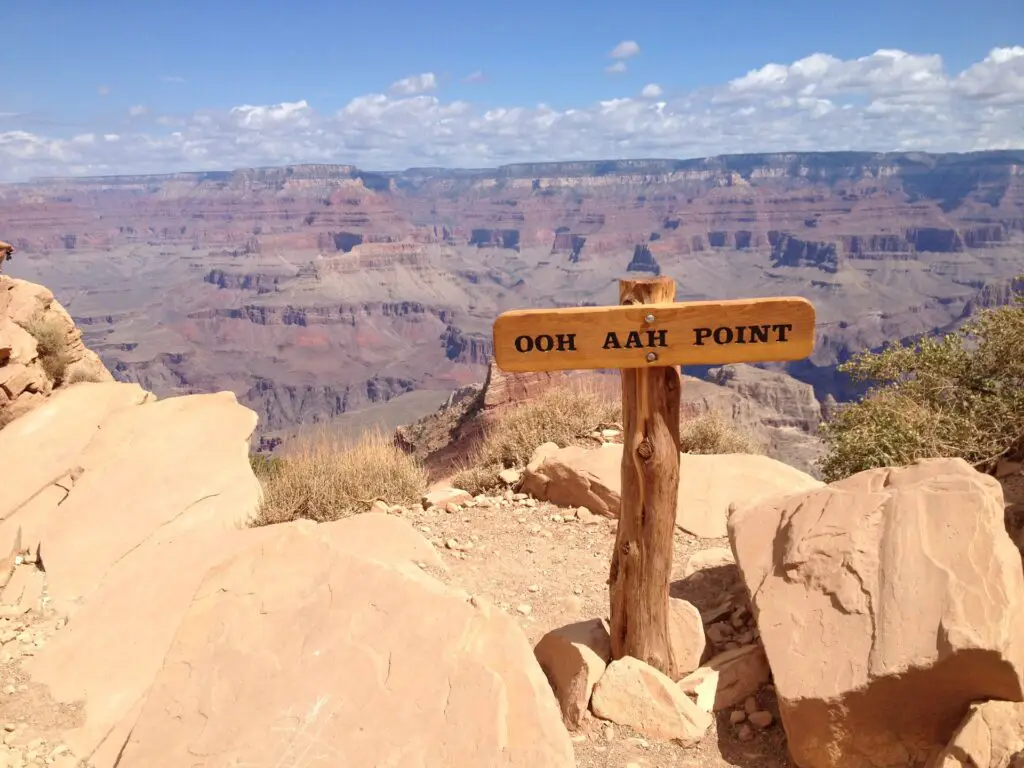
The hike down to Ooh Aah Point is also mainly downhill, which means it involves uphill climbing back up.
The views are fascinating no matter what trail you want to tackle if the weather favours you.
ENJOY CAMPING IN THE COLD
If you do not mind the cold or love camping in the winter, Grand Canyon has a few options that remain open at this time.
Here are some of the campgrounds you can check out for camping in the Grand Canyon in winter. The Mather Campground , in Grand Canyon Village is open on a first-come, first-served basis.
There are no online reservations possible if you plan winter camping.
You can book your spot using an automated fee machine at the campground office kiosk at the entrance to the campground.
It may fill quickly if you are here during holiday weekends, especially around Christmas and New Year’s Eve.
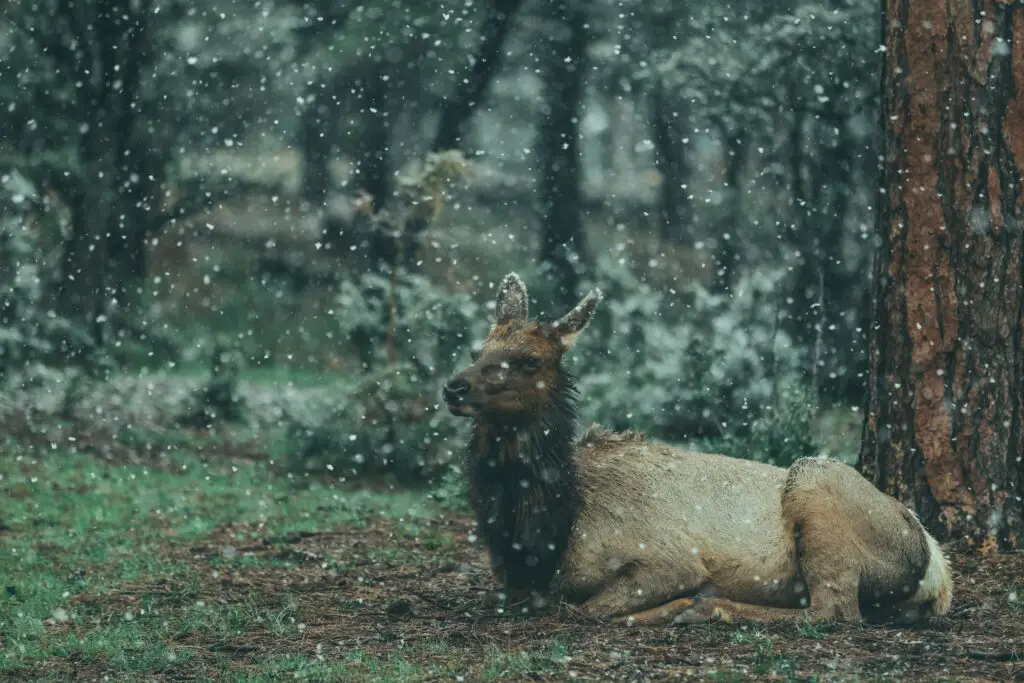
The North Rim Campground is available for winter camping. But the challenge is accessing the grounds, which may not be everyone.
It can only be reached by hiking the inner canyon trails from the South Rim or by hiking, cross-country skiing or snowshoeing 45 miles from Jacob Lake.
Trailer Village RV Campground is also open all winter and offers full hookups. Desert View Campground at the South Rim’s east entrance is closed for winter.
To camp at the North Rim during winter, you need a backcountry permit .
EXPLORE WILDLIFE IN GRAND CANYON
Surprisingly, not many know that winter is an excellent time to see the rich wildlife in the Grand Canyon.
Many animals, plants and birds thrive through cold winter days, but you need to be patient and know where to enjoy them in their natural habitats.
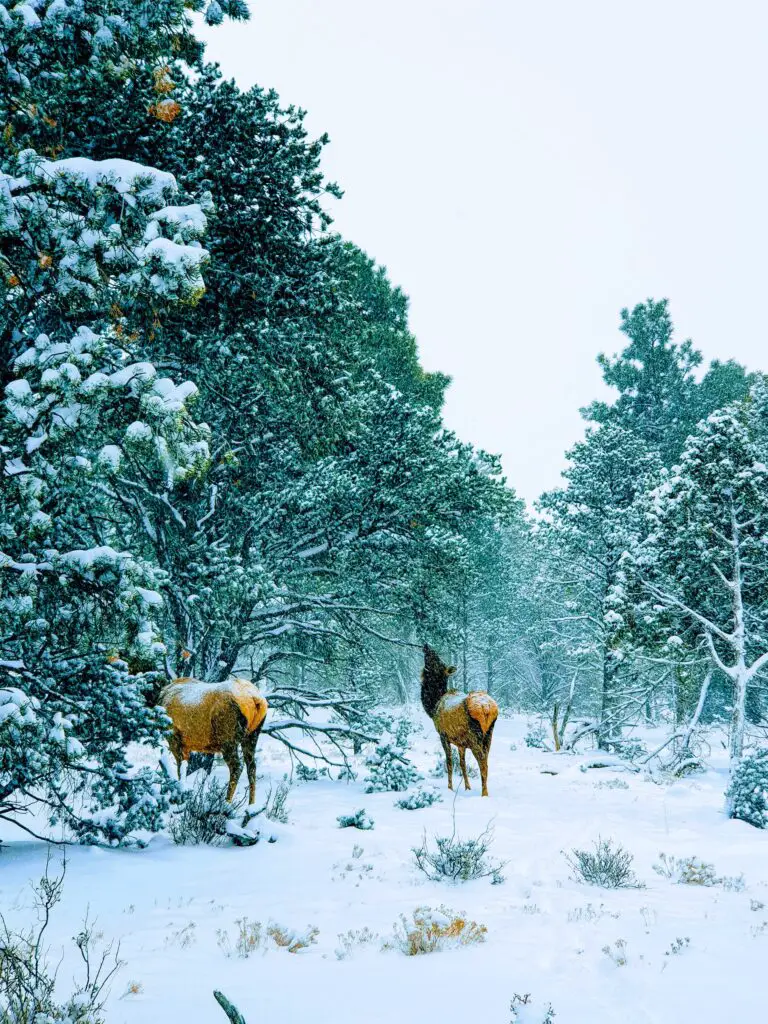
You can see animals foraging along the trails and forests, spotted commonly on hiking trails and drives.
Look out for the local special species of Mule deer, rock squirrels, elk and ravens, common during these colder months.
HOP ON THE GRAND CANYON POLAR EXPRESS
Every winter the Grand Canyon Railway’s Polar Express comes to life on a journey from the nighttime wilderness of Williams in Arizona, to the enchanted beauty of “the North Pole, Grand Canyon South Rim depot.
Here you will have Santa Claus and his reindeer waiting with a keepsake present. Enjoy hot chocolate and chocolate chip cookies while listening to this timeless story.
The ride lasts a little over an hour, with the train leaving each night at 5:30 PM and 7:30 PM.
Tickets begin at $57 for adults and $38 for children if you book early, but worth getting on the trail for a unique family holiday spirit to enjoy a special winter holiday in Grand Canyon.
Find out more details to book here.
TOTAL ROUND-TRIP TIME: Approximately 90 minutes.
GET ON TOP OF DESERT VIEW WATCHTOWER
Among the many viewpoints, one of the landmarks you should not miss is Desert View Watchtower, located next to the East Entrance Station.
If you are entering Grand Canyon National Park from the east entrance, you can enjoy stunning first views of the canyon by climbing to the top of Desert View Watchtower.
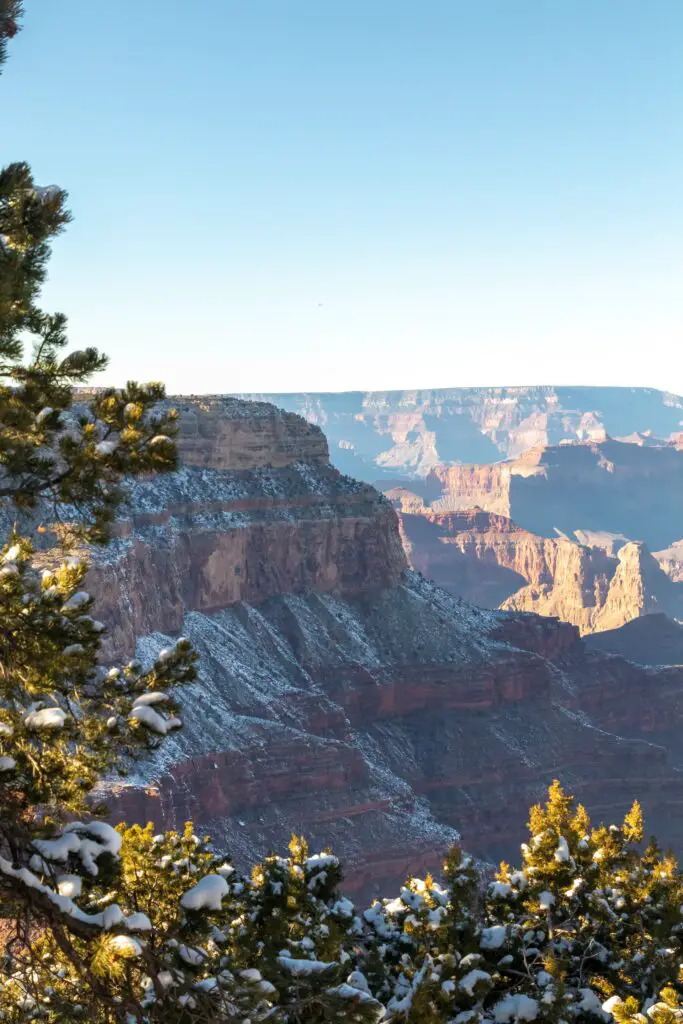
This 70 ft-high stone tower, built in the 1930s in the style of Puebloans with murals inside, is one of the famous attractions that allows you to admire beautiful views of the Canyon at different levels.
WHAT TO PACK FOR GRAND CANYON IN WINTER?
Here are the things we recommend you pack for the Grand Canyon in winter.
- Hiking Boots
- Camping Sleeping Bag
- Wind Jacket
- Pocket-Sized Water Filter
- Reusable food storage bags
- Ultralight First Aid Kit
- Hiking Leggings
If visiting the Grand Canyon during winter, one of the things to keep in mind is to pack in layers.
- Base Layer – Long Sleeve Sun-Protected Light Weight Top + Light Weight Hiking Pants
- Insulating Layer – Light Weight Pullover
- Outer Layer – Light Weight Windproof jacket with hood or Insulating Light Weight Jacket for fall/winter weather.
CAMPING ESSENTIALS
Here are some of the camping essentials you need:
- Cooler for food and water – Ultra Travel Cooler
- Camping Chair – Quad Camping Chair
- Camping Cot – Folding Camp Cot and Air Bed with Side Tables and Battery Operated Pump
- Sleeping Bags – Brazos Cold Weather Sleeping Bag
- Sleeping Tents – Ultralight Tent 3-Season Backpacking Tent 1 Person/2 Person Camping Tent
- Camping Lantern – Rechargeable LED Camping Lantern
- Reusable Water Bottle + Light Weight Water Filter
OTHER ESSENTIALS
Even if you aren’t into photography, you may want to bring a camera with a good lens. Panasonic LUMIX DC-ZS70S is best if you prefer lightweight gear.
WHERE TO STAY IN GRAND CANYON IN WINTER?
Since it is winter, you can expect snow storms or heavy snowfall and ice, which may delay your trip further, so staying as close as possible to the Grand Canyon is recommended.
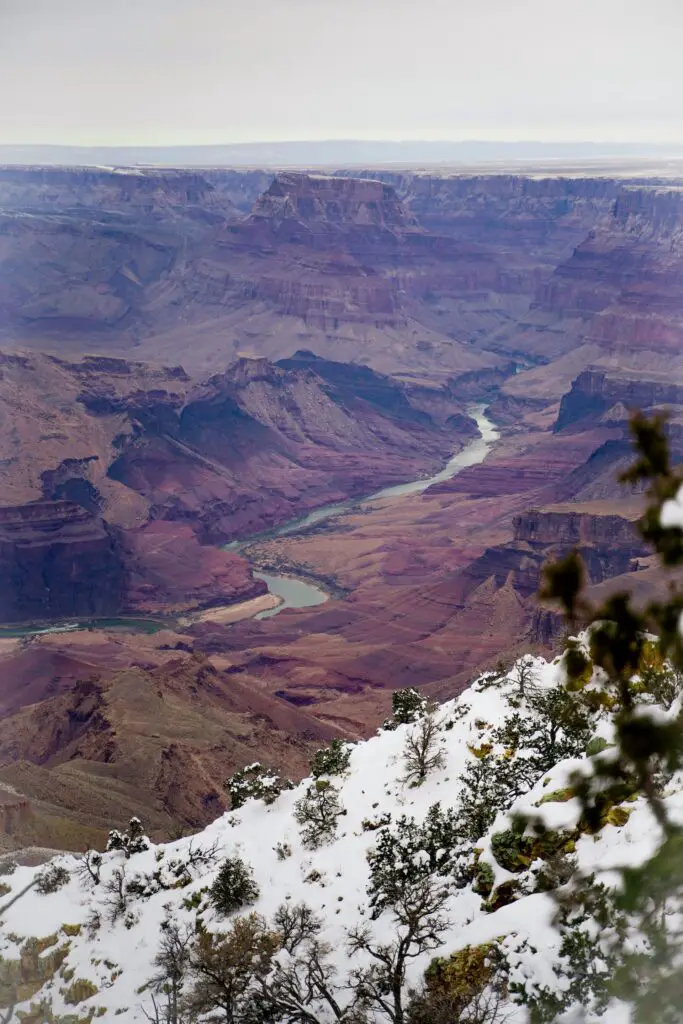
STAYS INSIDE GRAND CANYON NATIONAL PARK
One of the top advantages of visiting the Grand Canyon in winter is staying at one of the Grand Canyon’s historic South Rim lodges, sometimes even at the last minute.
If you have been here during the summer, you will know that it is nearly impossible to get your booking to stay in South Rim during the busy summer unless you book months in advance.
There are six places to stay at Canyon Village. All of them are elegant, offering stunning views and excellent amenities for comfortable stays.
- El Tovar Hotel – It is one of the best historic National Park lodges in the US, and come here during winter to enjoy your stay at this elegant place
- Bright Angel Lodge & Cabins – One of the best cabins known for its rustic vibes.
- Kachina Lodge – A pretty modern-day hotel surrounded by fantastic views
- Thunderbird Lodge – Stay here if you want to be close to the centre of Grand Canyon Village.
- Yavapai Lodge – Also located in the heart of Grand Canyon Village.
- Maswik Lodge – Surrounded by wooden forests, it is a unique stay close to shops and restaurants.
STAYING IN NEARBY CITIES
If, for some reason, you prefer staying in the cities nearby, the closest town is Tusayan, Arizona.
This little town is very close to the South Entrance of Grand Canyon National Park. But the downside is that there are limited stay and food options
If you prefer bigger cities, Flagstaff is the largest town near Grand Canyon.
There are many incredible things to do in Flagstaff, which deserves a day or two to be explored and is packed with more varieties of hotels.
HOTELS IN TUSAYAN
- The Grand Hotel at the Grand Canyon
- Best Western Premier Grand Canyon Squire Inn
HOTELS IN FLAGSTAFF
- Unwind in the Pines & a Huge Playhouse! Near NAU
- Beautiful Mountain Retreat
- High Country Motor Lodge
- Little America Hotel Flagstaff
- Twin Arrows Navajo Casino Resort
Chief Editor and CEO
Veronica Samuels is a travel content creator from San Francisco, but calls Arizona her home as she moved to the Grand Canyon state after a series of trips made her fall in love with Arizona inspiring her to move.
She created Wander In Arizona to share first-hand information about traveling to the many fantastic cities, trails, national parks, monuments and more as she continues to explore.
Similar Posts
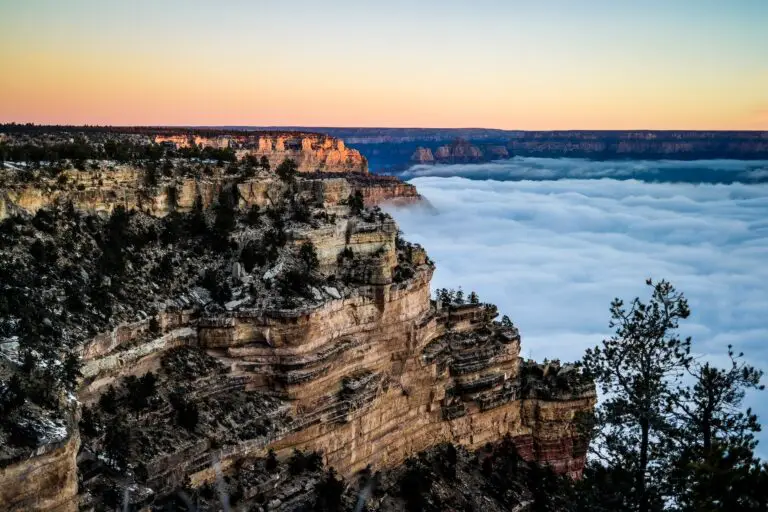
12 Best Grand Canyon Sunrise Spots For Spectacular Views
Author Recent Posts Veronica Samuels Veronica Samuels is a travel content creator from San Francisco, but calls Arizona her…
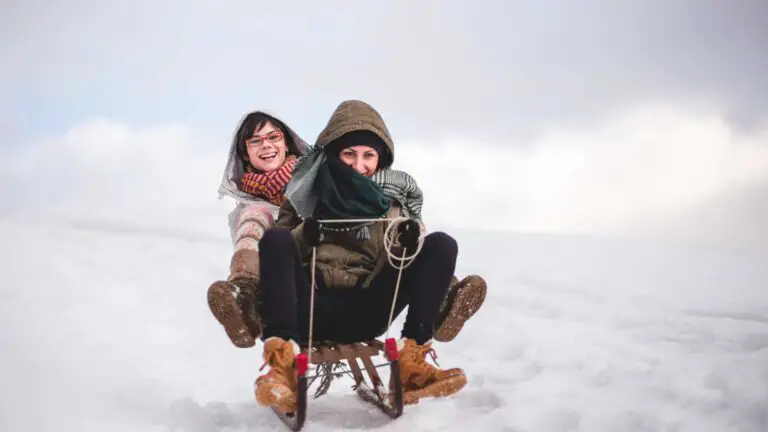
7 BEST PLACES FOR SLEDDING IN FLAGSTAFF THIS WINTER
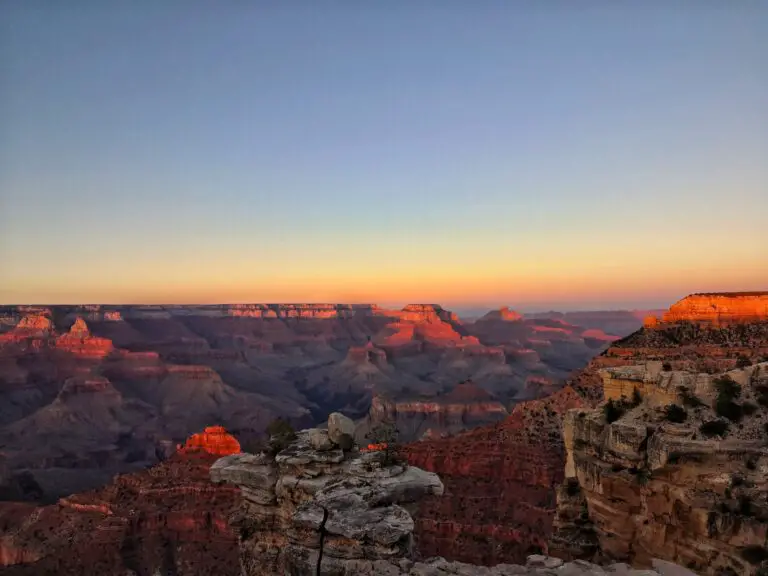
15 Grand Canyon Sunset Spots To Enjoy the Stunning Spectacle
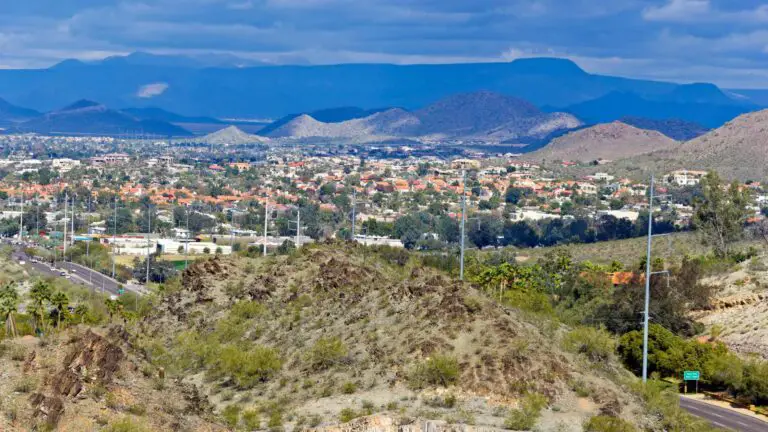
PHOENIX IN WINTER – 21 BEST THINGS TO DO THIS YEAR
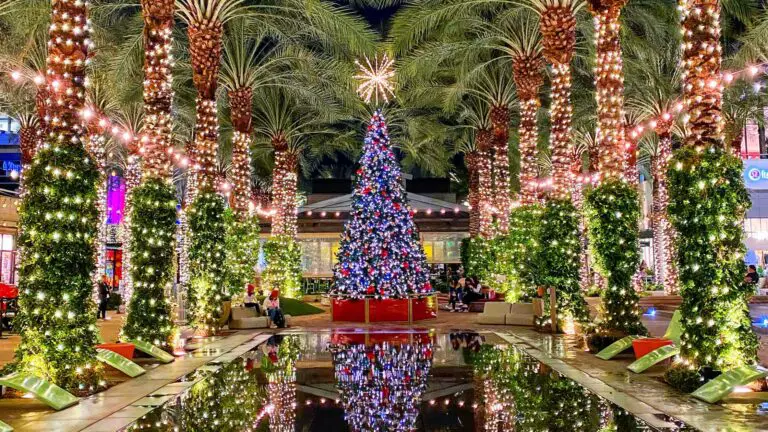
15 TOP SCOTTSDALE CHRISTMAS ACTIVITIES AND EVENTS
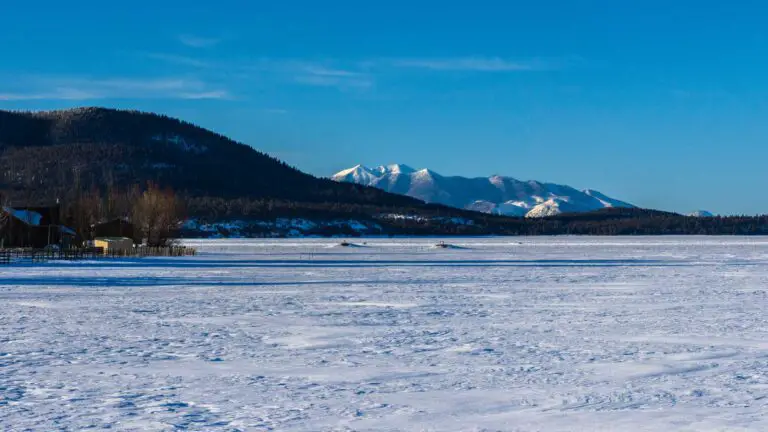
13 TOP PLACES TO FOR SLEDDING IN ARIZONA
Leave a reply cancel reply.
Your email address will not be published. Required fields are marked *
Save my name, email, and website in this browser for the next time I comment.
- Search Please fill out this field.
- Manage Your Subscription
- Give a Gift Subscription
- Sweepstakes
- National Parks
Everything to Know Before Visiting Grand Canyon National Park
Grand Canyon National Park is a must-visit — here's what you need to know before you go.
Evie Carrick is a writer and editor who’s lived in five countries and visited well over 50. She now splits her time between Colorado and Paris, ensuring she doesn't have to live without skiing or L'As du Fallafel.
:max_bytes(150000):strip_icc():format(webp)/evie-carrick-df91be43396540c492c4141c56a71a9e.jpg)
Know Before You Go
Best time to visit, how to get there, best things to do, places to stay, places to eat.
Lauren Breedlove/Travel + Leisure
There are few natural wonders that can challenge the great jaw-dropping size and beauty of the Grand Canyon. It is a mile deep and 10 miles across, showcasing an eye-catching array of layered red rock that reveals millions of years of geological history in a single glance. It is a wonder that is so bold, big, and beautiful that it marks planet Earth in a scar that can be seen from space.
To see the 277-mile canyon, you should visit Grand Canyon National Park in northern Arizona, a protected area that contains most of the canyon and the Colorado River that runs through it.
“The canyon landscape itself is the main draw for visitors from all over the world,” said Joelle Baird, a public affairs officer at Grand Canyon National Park, in an email interview with Travel + Leisure . She has lived and worked at the Grand Canyon for 12 years and says the landscape is special for many reasons.
“Many visitors are surprised by how high in elevation we are here (7,000 feet on the South Rim, 8,000 feet on the North Rim), so we have ponderosa pine and juniper/pinyon pine forests that encompass the high desert landscape as well.”
To provide you with a comprehensive guide to the park, we leaned into Baird’s expertise. After 12 years working in and along the canyon — as a biological science technician, preventative search and rescue ranger, and now a public affairs officer — she offers a wealth of inside knowledge. Below are her recommendations on everything from when to visit to where to hike.
Don Eim/Travel + Leisure
Grand Canyon National Park straddles the canyon itself and is broken into two sections: the South Rim and the North Rim.
Most people see the canyon from the South Rim, which is open 24 hours a day, seven days a week, year-round and is home to the main Grand Canyon Visitor Center. The South Rim also has a second visitor center, Verkamp's Visitor Center, which focuses on the people who have lived along the canyon and showcases what it was like to live and work in the park. To get to the South Rim, you can enter at the South Entrance near Tusayan, Arizona or the East Entrance (Desert View) near Cameron, Arizona. Most people use the South Entrance.
“I would recommend visiting the South Rim for at least a few days if it's your first trip to the canyon. The South Rim has a lot of visitor services including hotels, restaurants, and ranger programming that is definitely worth checking out,” said Baird.
Meanwhile, the North Rim near the Arizona-Utah border is quiet and remote, and completely closed to visitors between Dec. 1 and May 14. It is quiet and beautiful on the North Rim, but it also has fewer services, even in the summer. The North Rim Visitor Center and Park Store is open from May 15 to Oct. 15.
If you want to visit both rims, you have to take a five-hour drive around the canyon. For that reason, most visitors choose to just visit one of the canyon’s rims.
To enter the park from any entrance, you’ll have to pay $35 per day, per vehicle, or purchase the $70 annual park pass. Grand Canyon National Park does not require reservations or time-entry passes to enter the park.
Most people visit Grand Canyon National Park between late May and early September. June, July, and August tend to be the busiest months. The quieter “shoulder seasons” run from March to May and September to October, while the low season runs November to March.
The South Rim, which is open year-round and is easier to get to, is always busier than the North Rim of the canyon, which is only open between May 15 and Oct. 15, weather dependent. If you’re planning to visit the South Rim over school holidays, summer break, or fall weekends, you should expect long lines, limited parking, and crowded viewpoints. To lessen wait times, you can buy your park pass in advance in Tusayan, the South Entrance gateway town; enter the park at the less-busy East Entrance; or take the Grand Canyon Railway from Williams, Arizona to the South Rim.
According to Baird, if you don’t need to visit the North Rim, winter can be an extra-special (and quiet) time at the South Rim. “As a resident of Grand Canyon, my favorite time is the winter! We typically receive low visitation and many of the popular viewpoints are uncrowded. It is a much quieter time and the contrast between the red rocks of the canyon and snow on the rim is a magical sight.”
The best time to see and photograph the Grand Canyon is typically at sunrise and sunset . Sunrise is between 5:11 and 7:40 a.m., depending on the season, while sunset fluctuates between 5:14 and 7:49 p.m.
Related: The Best Times to Visit the Grand Canyon
The closest town to the South Rim is Williams, Arizona, which is a direct one-hour-and-20-minute drive on Route 64. From the larger city of Flagstaff, the South Rim is one hour and 45 minutes via Route 180. Phoenix is the closest major city (and airport) and is three hours and 45 minutes away by car. Las Vegas is around four hours and 45 minutes from the South Rim.
Once you’re in the South Rim “village,” there are several free shuttle buses that take you to various viewpoints, sites, and trailheads around the rim. Some routes run year-round, while others are seasonal. Check the schedule on the website .
You can also get to the South Rim on the Grand Canyon Railway , which departs from Williams, Arizona. By taking the train, you can avoid entrance line waits and parking headaches.
The North Rim, which is typically open between May 15 and Oct. 15, is around two hours south of Jacob Lake, Arizona on Highway 67. Las Vegas, which is over 5 hours away by car, is the closest major city and airport to the North Rim. And as we previously mentioned, driving between the two rims takes a full five hours.
Lauren Breedlove/Travel + Leisure
Scenic Drives
One of the best ways to experience the size and beauty of the canyon is to drive the Desert View Drive along the South Rim. The road takes off near the South Rim village and continues along the canyon rim for 23 miles, passing six viewpoints and a Tusayan Pueblo site. A shuttle bus also runs along this route.
Hermit Road (formerly West Rim Drive) runs in the opposite direction of Desert View Drive on the South Rim and offers a completely different look at the canyon (with nine viewpoints). Hermit Road is closed to private cars from March 1 to Nov. 30. During that time, there is a free shuttle bus that runs along the road.
On the North Rim, you can drive between Cape Royal and Point Imperial on a scenic road with plenty of pullouts and viewpoints, including Walhalla Overlook and Roosevelt Point. Keep in mind the North Rim and its scenic roads are closed in the winter.
Related: Best Grand Canyon Viewpoints
If you’re interested in going down inside the canyon, a raft trip is a must. There are full and half-day river trips that can be arranged through lodging accommodations on the South Rim, along with multi-day excursions down the Colorado River (for the latter, you need to secure a permit in advance).
Merrill Images/Getty Images
Road Biking
On the South Rim, there are around 13 miles of bike-friendly road and greenway trail (including Hermit Road, formerly known as West Rim Drive). The shuttle buses have bike racks so you can bike out and ride the bus back. There are regular and e-bike rentals available from the Bright Angel Bicycles shop adjacent to the Grand Canyon Visitor Center on the South Rim.
Cultural Demonstrations
There are ongoing cultural demonstrations at the Grand Canyon Visitor Center on the South Rim. These free demonstrations allow park visitors to meet members of the area’s 11 Indigenous groups and watch how traditional and modern crafts are made.
Best Hikes
Canyon rim trail.
This flat route runs right along the rim of the canyon and is a great introduction to the park. It starts at the visitor center at the South Rim and follows the edge of the canyon, eventually running alongside Hermit Road, which has nine exceptional overlooks.
Trail of Time
The Grand Canyon has a long and beautiful geological history, and it’s showcased along the Trail of Time, which runs almost three miles round-trip along the canyon rim between the Yavapai Museum of Geology and Verkamps Visitor Center on the South Rim. Each meter walked on the timeline trail signifies one million years of Grand Canyon's geologic history, and there are samples of rock and exhibits that explain how the Grand Canyon was formed.
South Kaibab Trail
Baird says, “Day hikes into the canyon should definitely be on your list if it's your first time.” She recommends hiking along the South Rim’s South Kaibab Trail to Cedar Ridge (three miles round-trip) or Skeleton Point (six miles round-trip). Just keep in mind, the trail descends into the canyon and is extremely steep. The national park notes that “the openness of this trail lends itself to extreme heat during the summer months and little to no protection from passing storms.”
Bright Angel Trail
Another in-canyon hike on the South Rim that Baird recommends is the Bright Angel Trail to the 1.5- mile rest house or the three-mile rest house. This route follows in the footsteps of the canyon's Indigenous people, miners, and early tourists.
Transept Trail
This route on the North Rim follows the canyon rim from the Grand Canyon Lodge to the North Rim Campground. The canyon views are plentiful on this three-mile round-trip hike.
North Kaibab Trail
This is the only maintained trail that goes into the canyon from the North Rim. You can go as far as you want, with the Coconino Overlook and Supai Tunnel just 1.5 miles and four miles round-trip, respectively. The North Kaibab Trail goes all the way from the rim to the river at the bottom of the canyon, but the park warns that “Under no circumstances should you attempt to hike from the rim to the river and back in one day” as the route is 28 miles round-trip with a steep 6,000-foot descent.
Hotels and Lodges
On the South Rim of the Grand Canyon, there are seven year-round lodging options. Five are in the historic district and are bookable online at grandcanyonlodges.com . The other two are located on Market Plaza near the visitor center and can be booked on visitgrandcanyon.com .
Standouts include El Tovar Lodge in the historic district, which is located directly on the rim and is a National Historic Landmark. El Tovar has hosted park visitors like Theodore Roosevelt, Albert Einstein, and Oprah Winfrey. Maswik Lodge South just opened in June 2022 for visitors looking for a modern take on traditional national park lodging. And Yavapai Lodge on the Market Plaza is notable because it has clean, simple rooms and is pet friendly.
There are also plenty of places to stay outside the park near the South Rim, including the Grand Canyon Railway & Hotel in Williams, Arizona where the train to the Grand Canyon departs from. Baird notes that “staying close to the park during your visit ensures you can make sunrise and sunset times more convenient.”
On the North Rim, the only lodge within the park is the Grand Canyon Lodge , which fills quickly during the North Rim’s opening window of May 15 to Oct. 15.
Campgrounds
There are four campgrounds along the South Rim, including the year-round Mather Campground for tent camping and Trailer Village for RVs. The South Rim also has two seasonal campgrounds that open for the spring, summer, and fall: Desert View near the East Entrance and Ten-X Campground.
There are also two seasonal campgrounds on the North Rim of the canyon, the North Rim Campground and the DeMotte Campground. Neither have hookups.
Related: Everything You Need to Know About Camping at the Grand Canyon
On the South Rim, there’s everything from grab-and-go lunch options (check out the Bright Angel Bicycle Rental and Café ) to full-service dining at places like the Arizona Steakhouse in the Bright Angel Lodge and the El Tovar Dining Room and lounge inside the El Tovar Lodge. You can also pick up groceries at the Canyon Village Market general store.
When the North Rim is open, you’ll find a general store adjacent to the campground as well as a saloon, deli, and full-service dining room in the Grand Canyon Lodge.

Visiting Grand Canyon in January with a lot less crowds!
Things to do in the grand canyon in january.
One of the benefits of visiting the Grand Canyon in January is that there are far less crowds than in the summer.
Table of Contents
There are also drawbacks for visiting the Grand Canyon in January as well and we all know that it is the weather and a chance of a snowstorm in January.
The blanket of snow across the canyons, the crisp temperatures and the low tourist numbers brings a unique experience to the Grand Canyon and offers another beautiful look at the magnificent canyons below.

Keep reading to check out these Grand Canyon in January reviews and what to do in the Grand Canyon in January. This is everything you need to plan your Grand Canyon visit in January.
Thank you for supporting this website written by an American. This post may contain affiliate links. This means I earn a small commission on these links at no extra cost to you.
To visit any of the National Parks in the USA, I recommend buying a National Park Pass. The America the Beautiful Pass is valid for one year and costs $80. Plus 10% of sale proceeds go to the National Park Foundation.
Is the Grand Canyon open in January?
The Grand Canyon National Park remains open for year-round visitors.
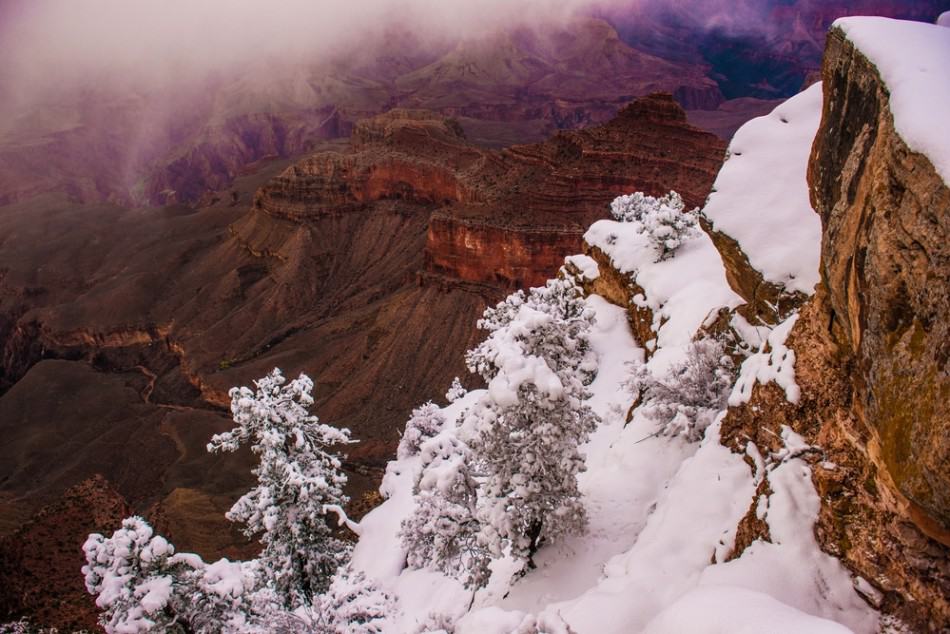
Although, during the winter months the north rim is closed , due to safety concerns. The South Rim is open year round and there are many beautiful Grand Canyon Lookout Points . Grand Canyon south rim in January is completely different and you can experience snow at the Grand Canyon.
How busy is the Grand Canyon in January?
The more popular South Rim remains open year-round. Due to the wintery conditions, the tourism rate at the Grand Canyon remains at its lowest during these months.
Thus, making winter a perfect time to visit the national park if you don’t want to be surrounded by too many tourists. The low tourist numbers also allow winter visitors to experience more of the tranquillity that the canyons have to offer.
Another benefit of going in the winter with less tourists is the fact that booking accommodation will be easy!
I don’t recommend just showing up though because some places will be closed but check out the list of the best accommodation in Tusayan below.

Is it a good time to visit Grand Canyon in winter?
There is never a bad time to visit the Grand Canyon.
As long as you are ready for short days and cooler temperatures and unpredictable weather you will enjoy visiting the Grand Canyon in Winter.
Winter in the Grand Canyon is a great time to visit with less crowds, clear skies and cooler weather. I think the key to visiting in the winter is to have good shoes. You cannot just wear sneakers as the snow will melt and get in your shoes. Waterproof shoes are a must!
Make sure to pack the following if you are planning to visit the Grand Canyon in January:
- Waterproof shoes
- Winter Jacket
- Gloves, Hat, Scarf
- Thermal Layer, sweater, sweatshirt
- Shoes with a good grip
Does it snow in the Grand Canyon in January?
Yes, the Grand Canyon sees snow during January and the days are much shorter.
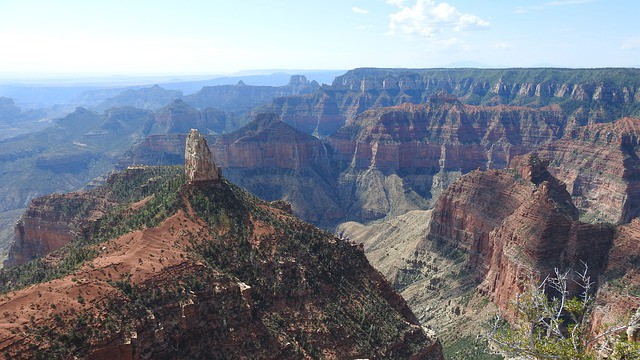
Storms in the Grand Canyon in January can dump anywhere from 50-100 inches of snow.
The blankets of snow are contrasted with clear sunny skies and crisp air providing great conditions to get out and experience the beautiful views of the sweeping canyons and Grand Canyon with snow.
Is the Grand Canyon cold in January?
Yes, it does get cold in the Grand Canyon in January. January and February are the coldest months. During the day it is in the 40s and 50s but at night it can get well below freezing.
There will be snow and at some point in the month there will be around 10 inches of snow in the village. Other times it will only have an inch or two of snow.
Things to do at the Grand Canyon in the Winter
You can do all of the same activities in the Grand Canyon in winter that you can do during the warmer months. Yes, a few trails will be closed due to the icy conditions but as long as you dress warm you will be able to enjoy visiting the Grand Canyon in winter.
1. Visit the Visitors Centre to find out the conditions.
Located just inside the south entrance station at the south rim, the visitors centre is open from 9am-4pm during these winter months.
At the visitors centre you will be informed of the weather conditions of that day, finding out if it is safe to hike some trails, if some trails are closed off and what viewpoints are safest to visit.
Also, at the visitor centre, there is a short film all about the park that takes visitors through a visual experience before jumping into it themselves.
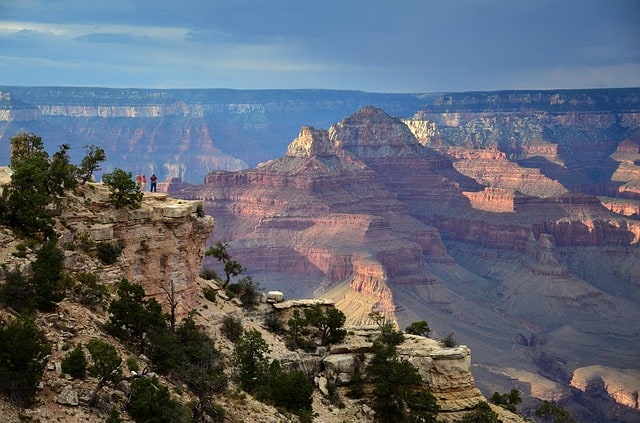
Just a short 5-minute walk from the visitor centre is the Mathers Point viewpoint. This is often the number one choice for many visitors, particularly during the winter due to the close proximity to the carparks and the visitor centre.
To get to the viewpoint does not require much effort nor is it time consuming, making it an easy spot to see the canyon if you don’t want to tread the wintery conditions.
2. Take a Shuttle if its snowy and you don’t want to drive.
If it’s snowy it is best recommended to take a shuttle bus to the viewpoints rather than driving yourself. It is safe to drive if the roads are clear, however, unless fully experienced and confident with driving on snowy roads – the shuttles are the best and safest choice.

The Grand Canyon offers two shuttle bus routes to see the best of the canyon, although the orange route (Kaibab Rim) is arguably the best for free transport to the best spots. Beginning at the visitors centre, the orange route shuttle bus leaves every 30 minutes.
During the route, the bus takes visitors to 5 major viewpoints offering beautiful scenery of the canyons. These viewpoints include, Mathers Point, Yavapai Geology Museum, South Kaibab Trailhead, Yaki Point and Pipe Creek Vista.
3. Drive to Hopi Point, if not snowy and you want to drive
One of the must visit spots along the west rim of the canyon, is located on Hermits Road, Hopi Point! Located about half way down the 7-mile road lies arguably one of the greatest lookouts of the canyon.
Hermit’s road is only open to private vehicles during the winter months, making it a perfect time to plan your trip out there.

Hopi Points is one the most popular viewpoints along the west rim due to the stunning panoramic views of the Colorado River, the Dana Butte, and the sweeping canyons. Hopi Point is also voted as being one of the best places to see the sunrise and sunset due to the wide vistas.
If, however, it is snowy and the roads are deemed unsafe for private vehicles, the park does offer shuttle buses along the Hermit road which takes you to Hopi Point. Ensuring that no matter the weather you get a chance to see this beautiful view.
4. Take a Short hike in the Grand Canyon
Hiking in the Grand Canyon in winter my seem impossible but I’ve listed a few short hikes that can be done. Most of the trails will be extremely icy so if you are planning to do any more hiking you will need extra gear for it.
All the Trails are monitored and open most days. Check with the visitors centre.
Take a hike to Shoshone Point
The trail begins along the Desert View Drive at a discrete gate. The trail in its entirety is only 1.7 miles, making it a short and easy hike to do during the winter months.
The trail is along a dirt road and only has a slight almost unnoticeable upwards incline along the way. The end of the trail offers magnificent panoramic views of the beautiful canyons below and due to the privacy of this trail, almost always offers a tranquil and calming experience in nature.
Take a hike to Ooh Aah Point
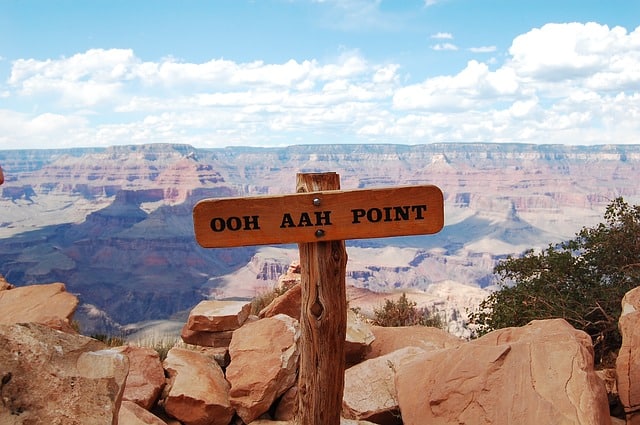
Located about 0.9-miles down the South Kaibab Trail is a beautiful viewpoint and a great end to a short winter hike. Although the hike is short it isn’t necessarily easy.
The hike down to Ooh Aah Point is relatively downhill, therefore coming back up takes approximately double the time. Therefore, in conditions where it isn’t raining or snowing too much, it could be a fantastic hike for those who want a small challenge along with a great view along the way.
Check out my post on the best hikes in the Grand Canyon
5. Drive the Hermits Rest Scenic Drive.
Hermit Road located at the west end of the south rim is a popular 7-mile route that takes you along many scenic viewpoints before finishing at Hermits rest.
There are shuttle buses provided by the Grand Canyon on offer along this route.
In the summer months, you must take the shuttle as there are too many people at the Grand Canyon and not enough parking spots. In the winter months, the road is open to private vehicles.
Along this route, there are some of the best views that the canyon has to offer, including the views from Hopi Point, Mohave Point and Pima Point.
6. Rim Trail – Visitors Centre to Village
A nice and easy 2.5-mile trail from the visitor’s centre to the Grand Canyon Village. The paths are paved and mostly flat, making it perfect for those who want to see the beauty of the canyons while remaining on flat grounds.

Along the trail, there are many viewpoints that bring in a different piece of beauty to your experience at the canyon. This trail is also perfect for those who love walking as it’s generally easy and can be compared to a walk in the park – with added bonuses of the canyon views!
7. Tusayan Museum and Ruin
The Tusayan Museum and Ruin located just 3-miles west of Desert View Point, is one of the most important archaeological discoveries in Arizona.
The Ruin itself contains the remains of a Pueblo Village that is believed to be over 800-years old. The Museum is located nearby the Ruins and contains many exhibits designed to give visitors a greater understanding of the unique history of the canyon. Visiting the museum and learning about the 12,000+ years of rich archaeological history sounds like a great way to spend a crisp winter day.

8. See the wildlife in the park
Many animals in this area have developed a tolerance and adaptation to the colder temperature. So, during the winter months many more animals can be seen out foraging along the trails and forests.
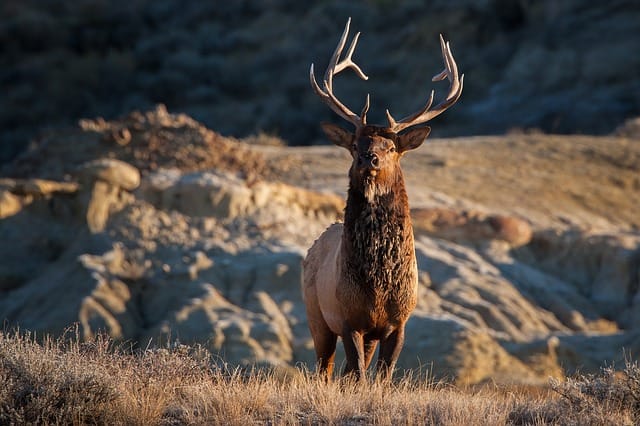
Mule deer, rock squirrels, elk and ravens are all popular sites among the canyons during these colder
9. Catch the Sunset at one of these points
There are many places along the Grand Canyon ranked as great places to view the sunset. Two of the best places to sit and enjoy the sunset on a crisp winter’s evening are arguably Hopi Point and Yavapai Point.
Hopi Point is one of the most popular places along the south rim to view both the sunrise and sunset. This is largely due to the incredible panoramic views of the canyon that is seen from this point. Making any sunrise or sunset truly magical.
Visiting the Grand Canyon during the winter months has its added bonus of getting to watch the sunset from the best spot without having it being overpopulated by visitors. Making the experience just a bit more exciting.
Yavapai Point is yet another great and popular spot to see the sunset at the Grand Canyon. Just a short walk from the visitor centre is Yavapai Point, a viewpoint with truly magnificent views of the canyons and a great spot to view the sunset.
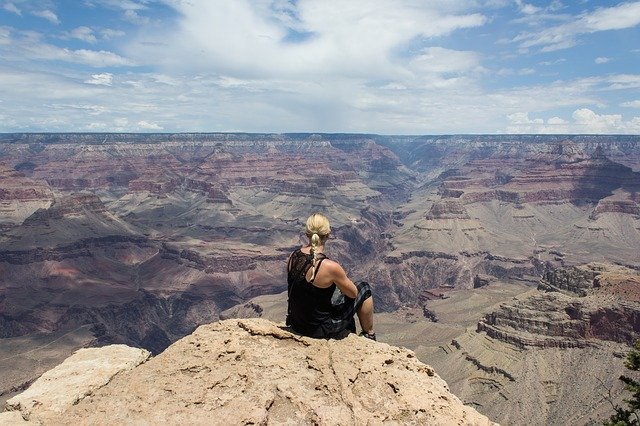
Check out my post on the Best Grand Canyon Viewpoints in the South Rim or the North Rim Look Out Points .
Where to stay near the Grand Canyon
Tusayan is the nearest city to the Grand Canyon. The population city of Tusayan is only 550. The city is located along Highway 180 about 70 miles from Flagstaff.
You will find shops and restaurants there, the Grand Canyon IMAX, and the Grand Canyon Airport is about one mile south of town.
Another benefit of going in the winter with less tourists is the fact that booking accommodation will be easy! I don’t recommend just showing up though because some places will be closed.
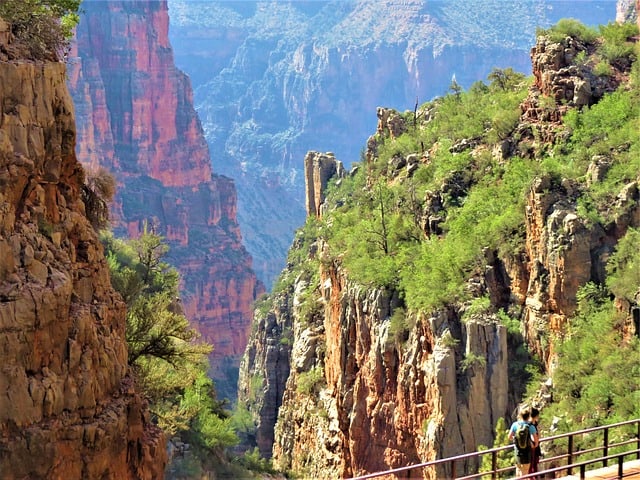
Canyon Plaza Premier Studio and Apartments
Views of the valleys and forest areas are featured in select Arizona apartments. Grand Canyon South Rim Entrance is 5 minutes’ drive.
Studios feature a kitchenette and apartments offer a fully equipped kitchen at Canyon Plaza Premier Studio and Apartments. A balcony is provided in each unit.
JJK’s Restaurant is open for breakfast, lunch, and dinner at the Studio and Apartments Canyon Plaza Premier.
Check out Rates on Booking
Arizona Luxury Expeditions – Grand Canyon
Arizona Luxury Expeditions has tents where you can glamp overnight. This is part of their ll inclusive and customized to include 12’x12′ Expedition Tents, all meals freshly prepared daily, and a professional Tour Guide for your stay with us.
The weather at the Grand Canyon during Dec. averages 30-40 degrees Fahrenheit daytime and 20’s degree at nighttime. They provide heaters for inside your sleeping and the private dining tents with plenty of warm heavy wool blankets. Most guests enjoy this time of the year in the Grand Canyon because of less crowds of people and the winter landscape that is incredible to experience.
Best Western Premier Grand Canyon Squire Inn
Located right next to the Holiday Inn Express, the Best Western has 250 rooms. The Best Western has an indoor heated pool, a hot tub, sauna, and fitness center.
There is also two restaurants in the hotel – Coronado Room and the Canyon Room. If you are looking for fast food you can find the McDonalds and Pizza Hut are close.
Holiday Inn Express Grand Canyon
The Holiday Inn Express is located just two miles from the South Entrance of the Grand Canyon. The Holiday Inn Express has 164 rooms and is located centrally in Tusayan which means you can walk to the restaurants and shops.
The Holiday Inn Express has an indoor pool, a whirlpool, and a continental breakfast is included.
The Grand Hotel at the Grand Canyon
The hotel offers 5-star accommodation with a hot tub. All units are equipped with air conditioning, a flat-screen TV with satellite channels, a microwave, a coffee machine, a shower, a hairdryer and a desk. Guest rooms include a wardrobe.
Featuring a restaurant, bar, shared lounge and free WiFi, The Grand Hotel at the Grand Canyon is located in Tusayan, 10 km from Mather Campground and 12 km from Bright Angel Trail. This 5-star hotel offers a concierge service and a tour desk. The hotel features an indoor pool, fitness centre, evening entertainment and a 24-hour front desk.
Grand Canyon Plaza Hotel
Canyon Plaza Premier Studio and Apartments is a 3 star hotel located 6 miles from the Grand Canyon.
There are only 10 rooms here and each room has a microwave, a refrigerator, and a coffee maker.
There is one restaurant here called JJK’s restaurant. Close to the hotel is the Plaza Bonita where you can also eat.
Conclusion – worth visiting the Grand Canyon in Winter?
The crisp cold weather, the blankets of snow across the canyons, the low
tourism, the foreign animals roaming about and the beautiful sunsets all make
for winter to be a great time to visit the Grand Canyon.
Many parts of the Grand Canyon offer spots of tranquillity and serenity, however, when visiting
in the winter these can be found more frequently and often in many of the most
popular spots of the canyon.
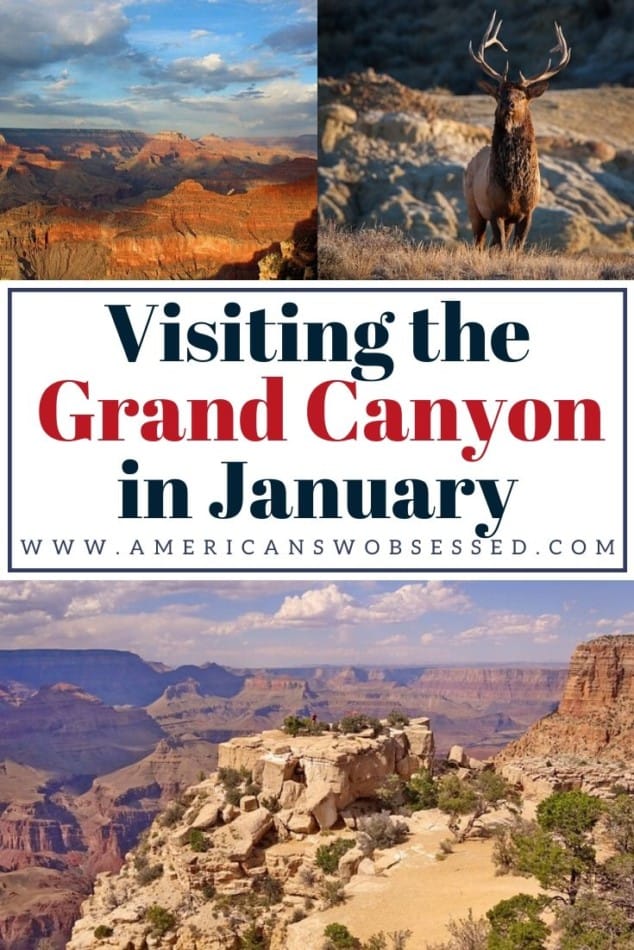
Continue Reading More on my website about the Grand Canyon:
Grand Canyon in December
Grand Canyon National Park Hiking Trails
Best Grand Canyon Viewpoint on the North Rim
15 Best Grand Canyon Viewpoints you won’t want to miss
15 Amazing Arizona Day Trips
Nicole LaBarge
Nicole is a travel expert who has been traveling to the American Southwest since 1992. There is so much to see and do in Arizona, New Mexico, Utah, Nevada, and California. I spend part of the year in Phoenix and travel around the area visiting all the best places and going on the best hikes. Check out my detailed destination guides, the best hiking in each state guides, and the travel gear you need for your next trip.
Recent Posts
19 Day Trips from Vegas: Unmissable Adventures!
Discover the Top 19 Unforgettable Day Trips Just Hours from Vegas! Are you looking for day trips from Vegas? Whether you are looking to get away from the strip or are using Vegas as a base...
15 Upscale Las Vegas Restaurants Worth the Hype
Vegas Fine Dining: A Tour of 15 Exquisite Upscale Dining Destinations Welcome to the ultimate guide to upscale dining in Las Vegas! Whether you're a seasoned foodie or simply seeking a taste of...

The First-Timer's Guide to the Grand Canyon
A t 277 river miles long and 18 miles across at its widest point, the Grand Canyon is big . So big, in fact, that you could spend a week exploring and barely see one rim (let alone the depths of the canyon). To make it all less overwhelming, we've put together the ultimate guide to getting the most out of your first visit, whether you have a day or a week.
Let's start with the basics: The Grand Canyon follows the southwest course of the Colorado River, which sliced a gorge through the Colorado Plateau over a period of 6,000 years. To orient yourself, think of the landscape in terms of the South, North, West, and East Rims, keeping in mind that there's no way to cross the canyon by car-you have to drive all the way around.
The South Rim is the most widely recognized area of the Grand Canyon, with the greatest number of viewpoints, visitor services, and hotels. More than 1,000 feet higher, the North Rim gets a good deal of snow and, as a result, is only open from May to October. A 215-mile, four-hour drive from the South Rim, it's perhaps best reserved for a separate or extended visit.
The West Rim , known as Grand Canyon West, sits on the tribal lands of the Hualapai and includes the Grand Canyon Skywalk , a horseshoe-shaped cantilever bridge with a glass bottom, perfect for conquering that fear of heights. Finally, the East Rim , which is lower in elevation at 4,000 feet, is part of the Navajo Nation and features numerous smaller canyons carved by the Little Colorado River.
Before we dive in deeper, note that not all of the Grand Canyon lies within Grand Canyon National Park . Around the park live four tribes-the Hualapai, Navajo, Havasupai, and Hopi-whose reservation rules and policies govern those areas. Also keep in mind that the season and weather will play a role in your Grand Canyon planning, with roads, viewpoints, and services subject to closure.
If you only have one day . . .
Most people aiming to see the canyon in one day will prioritize the South Rim, where it's possible to see and do the most in the least amount of time. You'll have your sightseeing cut out for you, though, so use the following plan to check all the most important boxes in a short visit.
Start with sunrise
Waking up before dawn will seem well worth it when the first rays make the canyon walls glow gold. Mather Point is the go-to spot to watch the sun come up, but you can't go wrong anywhere along the Rim Trail.
See the main South Rim sights
The primary attractions sit in a loop along the rim, connected by a hop-on, hop-off shuttle. If you get the early-morning start suggested above, you can realistically see them all in one day, though most people tend to skip a museum or two.
Grand Canyon Visitor Center : Watch an introductory movie, check out the relief map, sit in on a park ranger lecture, and catch the rim shuttle.
El Tovar Hotel : Peek into the lobby of one of the grandest of the historic National Park lodges.
Hopi House : Tour this 1905 building designed by Mary Colter-one of the first female architects in the United States-to resemble a Pueblo village. It's now used to showcase Navajo and other American Indian arts and crafts.
Kolb Studio : Visit the early 20th-century home and studio of pioneering photographers Emery and Ellsworth Kolb to see pictures and antique photo equipment.
Verkamp's Visitor Center : Shop for souvenirs and get your questions answered in this 1906 family home.
Yavapai Geology Museum : Learn about the forces that formed the canyon and take in the views at Yavapai Point.
Walk the Trail of Time
A section of the Rim Trail signed with detailed explanations of geological history, the short but worthy Trail of Time helps make sense of the colorful layers that give the canyon walls their candy-stripe appearance.
Explore Hermits Rest and Hopi Point
West of Grand Canyon Village, a series of overlooks along Hermit Road offer some of the canyon's most beloved views. For the best experience, follow the crowds to Hermits Rest at sunset and watch the rays turn the canyon crimson. When the road is closed to private cars from March 1 through November 30, shuttle buses ferry visitors to nine lookouts, including Mojave and Pima Points and the Abyss.
Drive to Desert View
Alternatively, you could watch the sunset at Desert View. After stopping at a few viewpoints along Hermit Road, take the scenic, 25-mile Desert View Drive , which passes the stunning Grandview Point, Moran Point, the Tusayan Ruin, and Navajo Point. The route finishes at the Desert View Watchtower, designed by Mary Colter in 1932. From the top, you can see for well over 100 miles on a clear day.
If you have three days . . .
More time means more opportunities to take in the canyon's variegated colors and gravity-defying formations from different angles and directions.
Hike into the canyon
It's hard to fully appreciate the depth of the Grand Canyon without going to the bottom and looking up. The most popular route down is the Bright Angel Trail , which, at nine miles one way, can't be done without camping overnight at Indian Garden or Bright Angel campgrounds. Don't delay in applying for a backcountry permit because sites fill up fast.
If you'd rather make it a day trip, hike part of the way down to one of the rest houses at 1.5 or 3 miles, then head back up (remember: coming up takes longer than going down) with a far greater appreciation for the canyon's geological marvels.
More rugged and less crowded-it typically sees a tenth of the visitors of the South Rim-the North Rim is cooler and covered in forests of aspen, birch, and maple trees. While snowfall limits the official visitor season to May through October, hikers and cross-country skiers can still access the area during winter months.
A favorite activity here is hiking the North Kaibab Trail , which descends 14 miles to the Colorado River and Bright Angel Campground, with memorable views along the way. For something slightly less strenuous, hike the first part of the trail to the Supai Tunnel, four miles round-trip, or book a mule excursion with Canyon Trail Rides .
Visit Grand Canyon West
Just a 90-minute drive from Las Vegas, the West Rim has become the second most popular area of the Grand Canyon, attracting more than 1 million visitors annually. Located outside the national park on the lands of the Hualapai tribe, it's best known as the site of the Grand Canyon Skywalk, a glass bridge that extends 70 feet past the edge of the canyon rim. If you don't mind touristy attractions, walk its length while gazing past your feet to the canyon floor 4,000 feet below. Afterward, keep your adrenaline pumping with a ride on the West Rim Zip Line , or opt to check out the traditional craft studios at Eagle Point instead.
If you have one week . . .
Human beings have been living in and around the Grand Canyon for 12,000 years, and they've been exploring it in myriad ways. The more time you spend in the canyon, the more its marvels reveal themselves to you.
Hit the water
Ask anyone who has rafted the Colorado River through the Grand Canyon about their experience and you'll be treated to a story of adventure. Guided trips, ranging from 3 to 18 days, stop at places like Lees Ferry , Phantom Ranch , and Whitmore Wash, navigating distances of up to 226 river miles. Among the many outfitters recommended by the National Park Service, we suggest Oars , Grand Canyon Expeditions , Arizona Raft Adventures , and Arizona River Runners .
Witness Havasupai Falls
The iridescent waters of Havasupai Falls have long inspired adventurers to make the 10-mile trek through the verdant Havasu Canyon, home of the Havasupai tribe. The hike has become so popular, however, that in 2019, the Havasupai imposed strict visitation rules, requiring all visitors to obtain permits and stay for at least three nights at their campground or lodge .
Day hiking on the reservation is strictly prohibited, but AirWest Helicopters flies to and from the falls several days of the week (Sunday, Monday, Thursday, and Friday from March 15 to October 15; Sunday and Friday from October 16 to March 14). The 15-minute flights into the canyon leave from a broad shelf below the Havasupai Trailhead parking lot, while return flights depart from an area between the tourism office and café. Flights are first-come, first-served, so it's best to arrive early. Expect to pay $85 one way.
Adventure into the east
Located within the Navajo Nation, the East Rim is the most remote area in the Grand Canyon, with fewer access roads and viewpoints. The most popular attractions here are Antelope and Marble Canyons, as well as Instagram darling Horseshoe Bend , a dramatic viewpoint over the Colorado River. Many road-trippers to the east side head northeast to Glen Canyon National Recreation Area , which encompasses Lake Powell.
Get a bird's-eye view
Many raptors make their homes in the red rocks. Hawkwatch International maintains a counting station at Yaki Point on the East Rim, where educational interpreters are happy to explain migration ecology, raptor identification, and their efforts to monitor long-term trends in the raptor population. As of fall 2019, researchers had identified more than 20 species of raptors living in the canyon, including sharp-shinned, Cooper's, and red-tailed hawks as well as peregrine falcons and bald eagles.
More tips and tricks
To make things even easier, follow these final pointers.
Enlist the experts
One way to take the pressure off your planning is to get some expert help. The Grand Canyon Conservancy offers a series of guided field adventures that include time to take in the views and learn about the canyon's geology and ecosystems.
Take a class
Free National Park Service programming like daily "Geology Glimpse" talks at the Yavapai Geology Museum and "Critter Chats" at the Grand Canyon Visitor Center help you get up to speed quickly, while the Junior Ranger program (available year-round at the South Rim and from May to October at the North Rim) provides kids with a richer experience.
Go by train
Most people drive to the Grand Canyon-and a car is necessary if you plan to visit more than one area along the rim-but a fun, relaxed, and scenic alternative is to take the Grand Canyon Railway , which makes daily round-trips between Williams, Arizona, and the Grand Canyon Depot. Featuring vintage rail cars with live music, the train winds through thick woods and across broad meadows, offering views of unsuspecting wildlife along the way. The cowboy characters who bring the Old West to life aboard make the trip particularly fun for children .
This article was originally published in January 2020. It was updated in August 2022 with new information.
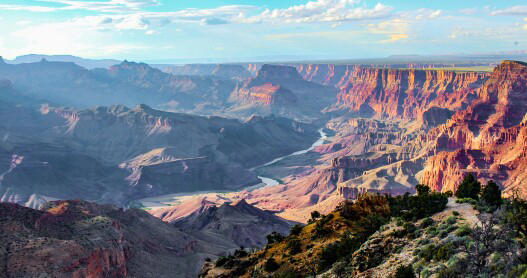
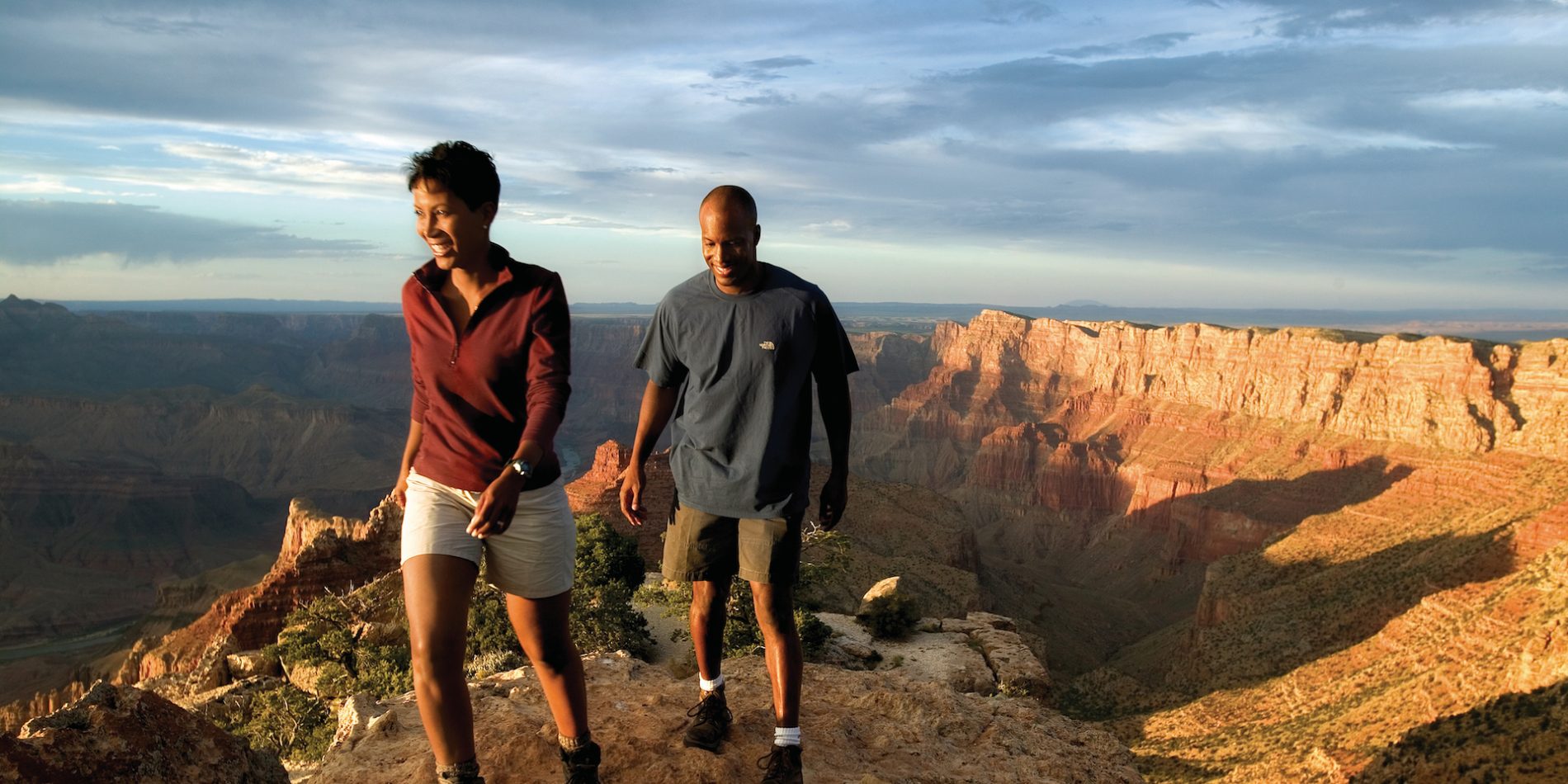
Unmeasurable Adventure
Outdoor Adventures
First-timer's guide to the grand canyon.
For those making their first trip to the Grand Canyon, here's an expert take on when to go, where to stay, and how to get around.
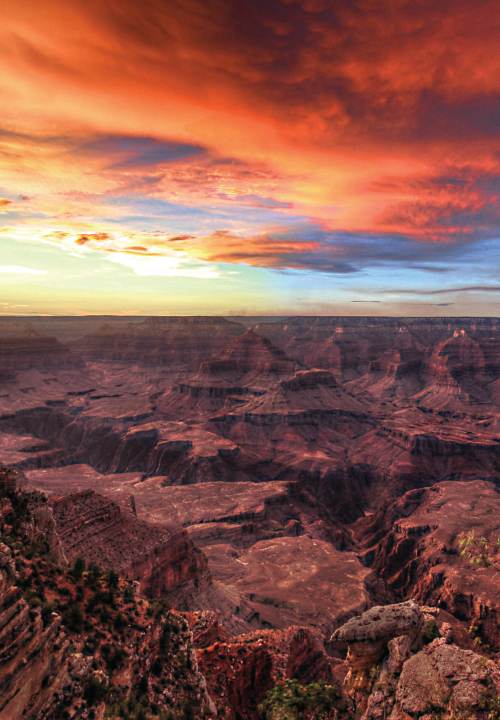
Before you pack your bags and make the trip to Grand Canyon National Park , a few words of practical advice:
With the kids out of school, summertime is undoubtedly the busiest time of year, making peak season at Grand Canyon between June-August. If you're staying during this time, be sure to book your lodging early, as reservations start filling up nine months to a year in advance .
For cooler weather, lighter crowds and better lodging availability, plan your trip during the shoulder seasons between March-May, and September-November.
South Rim or North Rim?
According to the Grand Canyon National Park's official page , though the width of the canyon is roughly 10 miles, driving from the South to North Rim can take at least five hours on a route that sometimes dips south through Tusayan and even Flagstaff before turning back north through Cameron or Bitter Springs. Hiking rim-to-rim is possible but is recommended only for the experienced hiker. (See " Grand Canyon Hiking " for more trail options.)
Most easily accessible from Phoenix, Sedona or Flagstaff, the South Rim welcomes more visitors than the North Rim and offers the most amenities and attractions in terms of lodging, dining, tours, transportation, viewpoints and family-friendly experiences. It is also open year-round. As this area tends to be much busier—particularly during peak season—be sure to book reservations well in advance.
Quieter, more remote and offering fewer visitor services, this rugged portion of Grand Canyon National Park experiences fewer visitors and offers a more outdoor-minded experience. Due to its higher elevation, the North Rim is also cooler in temperature and experiences heavy snowfall in winter, resulting in a shorter season. (It's open from mid-May through mid-October.)
Quieter, more remote and offering fewer visitor services, the North Rim experiences fewer visitors and offers a more outdoor-minded experience.
Where to stay
Bring your tent or RV to enjoy the great outdoors at one of the many campgrounds in the park.
Two of the three National Park Service campgrounds accept reservations: Mather Campground on the South Rim and North Rim Campground . Desert View Campground on the South Rim (open seasonally between mid-April and mid-October) is first-come, first-served, and Trailer Village is a concessioner-run RV park with full hook-ups.
If roughing it isn't quite your style, Grand Canyon National Park Lodges operates numerous hotels, both inside and outside the park.
Located at the top of Bright Angel Trailhead, the historic Bright Angel Lodge & Cabins , designed by Mary Colter in 1935, provides rustic accommodations close to outdoor adventure. Take your pick from budget-friendly lodge rooms with shared bathrooms, standard lodge rooms or private cabins (one of which was home to one of Roosevelt's "Rough Riders").
Perched on the edge of the South Rim, the European chalet-style El Tovar Hotel , which opened in 1905, offers spectacular views, one-of-a-kind rooms and suites, and fine dining in the famous El Tovar Dining Room.
Just a mile from the entrance of the park, The Grand Hotel at the Grand Canyon is the area's only Three-Diamond hotel, and the rustic chalet-style hotel offers an indoor heated swimming pool and hot tub, a steakhouse and saloon, and plush rooms with a kitchenette.
Meanwhile, Thunderbird Lodge and Kachina Lodge are popular choices for families, due to their casual, modern aesthetic and convenient location within walking distance to many of the park's attractions.
On the North Rim, book one of the cozy cabins at the historic Grand Canyon Lodge to stay amid towering pine trees and just steps away from the scenic Bright Angel Point Trail. This landmark lodge boasts cliffside views and an on-site restaurant serving up hearty, regionally inspired dishes such as venison meatloaf and wild rice primavera.
Getting around
Take advantage of the Grand Canyon National Park's free shuttle buses that operate on set routes throughout the park along the South Rim, including:
- the Village (Blue) Route, connecting the visitor center with lodging and other facilities;
- Kaibab Rim (Orange) Route, a figure-eight route between the visitor center and five scenic viewpoints;
- Hermit Road (Red) Route, connecting Grand Canyon Village and Hermits Rest, with scenic overlook stops along the way; and
- the Tusayan (Purple) Route, a park-and-ride service between the community of Tusayan and the park.
The early-morning Hiker's Express Shuttle transports hikers to the South Kaibab Trailhead from Bright Angel Lodge, the Backcountry Information Center and the Grand Canyon Visitor Center. For a $90 fee, the privately run Trans-Canyon Shuttle takes visitors between the North and South Rims.
You've arrived
You made it to the Grand Canyon. Welcome! Now what? We have you covered here, too. Read on to discover our three-day, activity-filled Grand Canyon itinerary —perfect for newcomers and returning visitors.
About the Author
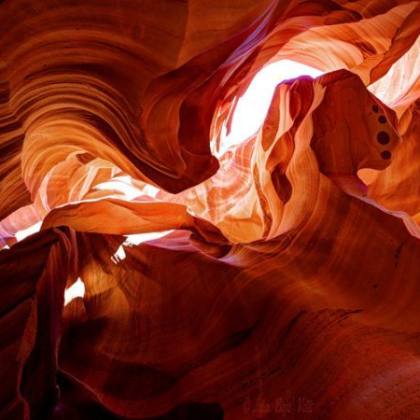
Arizona Office of Tourism
These articles are brought to you by the staff of the Arizona Office of Tourism, and occasionally local tourism organizations around the state.
- Link to site translated for China
- Link to site translated for Japan
- Link to site translated for France
- Link to site translated for Germany
- Link to site translated for Mexico
- Link to Arizona Office of Tourism's official Facebook page Facebook
- Link to Arizona Office of Tourism's official Instagram Instagram
- Link to Arizona Office of Tourism's official Twitter Twitter
- Link to Arizona Office of Tourism's official Pinterest Pinterest
- Link to Arizona Office of Tourism's official YouTube channel YouTube
- Link to Arizona Office of Tourism's official TikTok TikTok
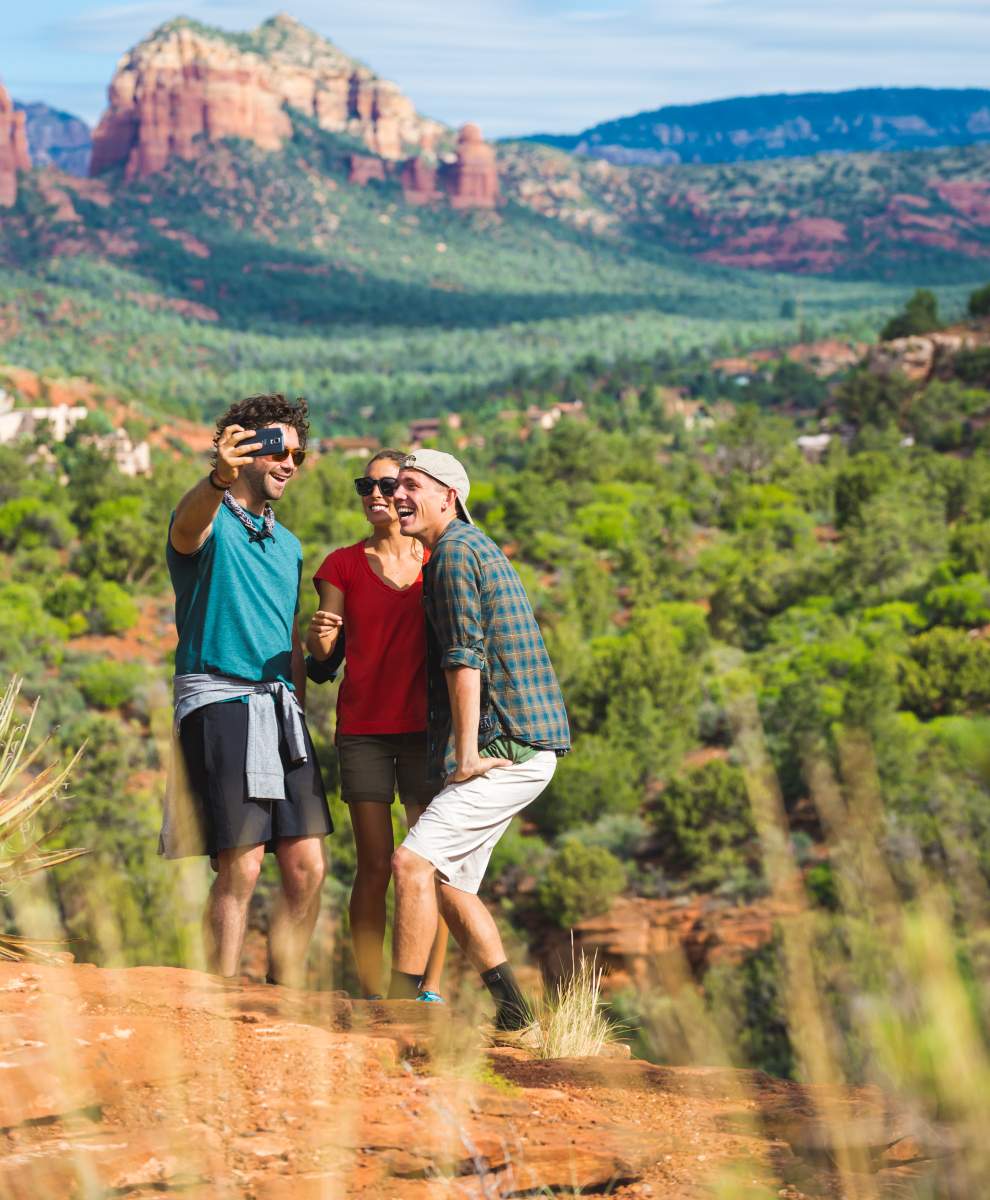
Most Searched Stories

Request Your Copy
Official State Travel Guide

Top Annual Events
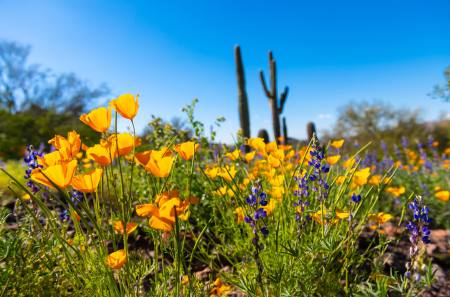
Sustainability
Appreciate AZ

Travel Inspiration
Plan Your Trip
Cities & regions.
From the abundance of Saguaro cactuses and unique wildlife in the Sonoran Desert to the high country and forests of the White Mountains to the breathtaking Grand Canyon, Arizona’s regions are full of experiences that don’t disappoint.
Discover Which Colorado Mountain Town is right for you
Expert’s Secret Guide to the Grand Canyon in Winter
- November 11, 2023
- By foxintheforest
Last Updated on March 31, 2024 by foxintheforest
Arguably one of the greatest marvels of the natural world, the Grand Canyon in winter is a sight to behold. Seeing this red rock marvel carved by years of erosion dusted in snow is a real treat. And the best part? There are fewer crowds too!
I’ve been exploring the American Southwest for the better part of 13 years and it’s always a treat when I get the chance to head to the Grand Canyon. This complete guide to the Grand Canyon in winter gives you expert advice about how to make the most of your off-season visit.
About this Guide to the Grand Canyon in Winter
Inside this expert’s guide to the Grand Canyon in winter you’ll get insider info on how to explore like a pro, not a tourist. Inside you’ll find:
- Practical info about visiting the Grand Canyon during winter
- Info about weather and Grand Canyon winter temperatures
- Things to do in the Grand Canyon during winter
- Where to stay
- What to wear
- Additional planning resources
Practical Info About Visiting the Grand Canyon in Winter
First up, the North Rim of the Grand Canyon is closed to vehicle access during the winter.
Accessing the park from the north end between October 15th and May 15th is extremely difficult and requires some advanced knowledge of traveling over snowy terrain. Best not to visit this part of the Grand Canyon in March .
So, that may help you decide between the Grand Canyon North Rim vs. South Rim .
However, the South Rim of the Grand Canyon is open year-round and is very accessible. In order to access the South Rim, you’ll have to head to either the South Entrance Station or East Entrance Station. Here are a few practical tips:
Entry fee is $35 per day (no ins and outs) or free with the America the Beautiful Annual Parks Pass – a screaming deal if you plan on visiting for multiple days or seeing more than 2 national parks in a 12-month period.
The park is not really dog-friendly. Dogs are not allowed on hiking trails and can only stay on roads or paved walkways. They must be leashed. Heatstroke is not an issue in the Grand Canyon in the winter, but it’s not really fair to leave your pup in the car either.
Services can be limited in the park during the winter. Come prepared by packing a windshield scraper and fluid, extra food and water, blankets, extra lawyers and booster cables.
Crowds are still existent, but far fewer in the winter . It’s the second most popular national park in the US (right behind Yellowstone), so you’ll definitely see people, even in winter, but it’s a far cry from the jam-packed viewpoints and trails of summer.
Pro Tip: There is limited cell service on the South Rim, but don’t rely on it if something goes wrong!
Map of the Grand Canyon
Get oriented with this map of the Grand Canyon. The South Rim is everything south of the Colorado River.
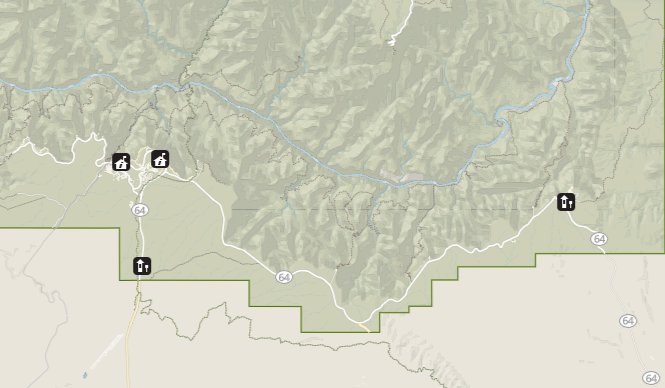
Does the Grand Canyon Get Cold in the Winter?
Yup, it sure does! It even snows (if you’re lucky). Temperatures are relatively mild by winter weather standards, usually hovering in the 40s during the day. However breezy canyon rims can make it feel quite cold, so come prepared.
Snowstorms typically drop a few inches of the white fluff. Once the skies clear, it’s jaw-dropping. But don’t fret if you hate the cold, when the sun is shining and the wind is still, it’s rather pleasant during the winter.
What to Expect From Grand Canyon Winter Weather
The weather in the Grand Canyon in the winter can actually be more pleasant than the searing desert heat of the summer. The winter high temps up on the South Rim average in the low-to-mid 40s and can reach into the 60s down in the bottom of the canyon. But snowstorms and cold fronts can quickly put a kink in your plans, so you’ll definitely want to check the forecast before your trip.
Snow hits the North Rim the hardest, with an annual snowfall average of 142 inches a year. This is why the North Rim is closed to vehicles in the winter. The South Rim average snowfall is significantly less at 58 inches. Snow rarely makes it down to the inner canyon, with Phantom Ranch averaging less than an inch of snow each year.
In general, here is what you can expect from Grand Canyon winter weather each month:
Grand Canyon in December
In the Grand Canyon in December, you can expect an average high temp of 45°F at the South Rim. The evening temperatures will dip into the teens. You will most likely encounter snow in December, especially later in the month.
Is December a Good Time to Visit the Grand Canyon?
Yes! Winter holidays in the Grand Canyon are a real treat. What better way to experience the magic of the season than with a snow-dusted view of the mighty Grand Canyon? Crowds are typically not too crazy but expect to have some company at popular viewpoints and on busy trails.
Weather in the Grand Canyon in January
Weather in the Grand Canyon in January is definitely the deep of winter, but the average high temperature still hovers in the mid-40s at the South Rim. Be prepared for snow, since January sees the highest snowfall averages in the Grand Canyon.
Pro Tip: If you’re into photography, January is an excellent time to pack up your tripod and photograph the Grand Canyon in winter.
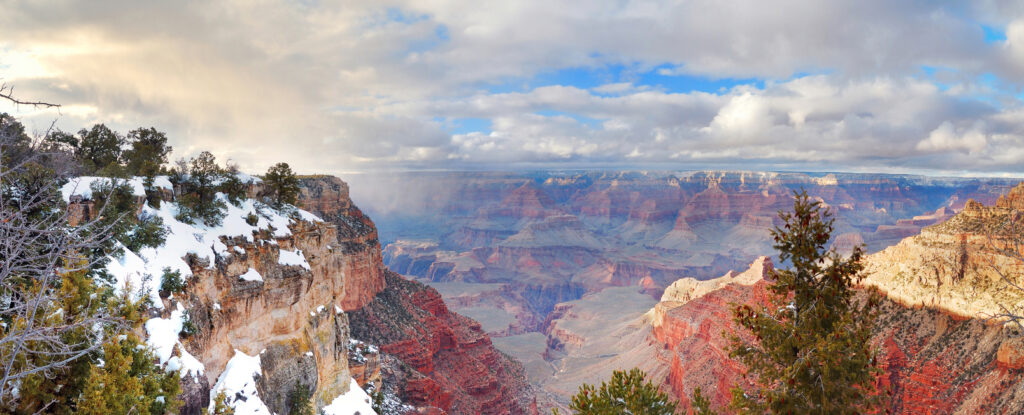
Visiting in February
February weather is very similar to January weather in the Grand Canyon, with high temps on the South Rim averaging about 46°F. Expect a fair amount of snowfall, although potentially a few inches less than in January.
March in the Grand Canyon
The winter weather begins to warm up in March as spring approaches. The average daily high on the South Rim edges up to 51°F, and the inner canyon will get into the 70s. Of course, it will probably still snow, but when it’s snow-free, the conditions in the Grand Canyon in March can be quite pleasant.
Daylight Hours in the Grand Canyon in Winter
Like with most places in the United States, the number of daylight hours that you encounter at the Grand Canyon lessens in the winter.
Therefore, expect to encounter shorter days (or less daylight) towards the end of December, when the sun rises around 7:00 am and sets around 5:00 pm.
However, in general, the sun rises and sets in:
- December Sunrise: 7:20 am – 7:40 am
- December Sunset: 5:15 pm – 5:25 pm
- January Sunrise: 7:40 am
- January Sunset: 5:25 pm – 5:40 pm
- February Sunrise: 7:00 am to 7:30 am
- February Sunset: 5:55 pm and 6:30 pm
That being said, you’ll definitely still have enough time to see all the things you want to see.
But, do try to make the most of the daylight you have by getting up with the sun and returning to your hotel once it gets dark.
Pro Tip: Please remember that from November through March, there is a one-hour time difference between Las Vegas and the Grand Canyon since Nevada uses Daylight savings time and Arizona does not.
So, if it’s 8:00 am in Las Vegas then it will be one later at the Grand Canyon and you should plan accordingly.
What are Crowds Like in the Grand Canyon in the Winter?
If you’re looking to avoid crowds in the Grand Canyon, winter is the ideal time to visit the Grand Canyon to find the solitude you seek. January and February are the months with the lowest levels of park attendance throughout the year.
Backcountry permits are much easier to get in the winter, so you can really head out into the park alone if you’ve got some experience backpacking in the snow. Since the North Rim is closed to vehicles during the winter, if you make the effort to snowshoe or hike into the area, you will certainly find seclusion.
Just be aware that lines to get into the South Rim can still be ridiculously long in the winter.
In fact, wait times to get into the South Rim Entrance can be upwards of two hours long – especially during the holidays and on the weekends. So, it is always best to visit early and to avoid busier times of the week.
Are Grand Canyon Roads Open in the Winter?
The only roads that are open in the Grand Canyon are those on the South Rim. These typically remain open all year long, unless there’s inclement weather.
That being said, the major road (SR64) from Williams, AZ to Grand Canyon Village is basically always open. This is where you’ll probably enter the park and where you can find famous viewpoints and the visitor’s center.
In contrast, Desert View Road (going towards Cameron) will often close when snow hits the area. Sure, they try to clear the road ASAP but don’t be shocked if this route is closed in the winter.
Now, Hermit Road is another popular thoroughfare in the South Rim that will take you to several iconic viewpoints.
In fact, this road is so popular that it is only open to shuttles in the summer. However, come winter, the road is not plowed regularly since it is a small local road.
Therefore, while you can use a private vehicle here in winter, don’t be surprised if the road is closed because of snow.
In general, always check the official Grand Canyon website for the most up-to-date information on road closures before you visit.
Winter Closures in the Grand Canyon
Even though the Grand Canyon is open year-round, winter closures can happen and many of the summertime facilities (as well as activities) shut down.
While the South Rim stays open year-round, the North Rim of the Grand Canyon closes during the winter months. And so do some of the best Grand Canyon viewpoints .
This closure takes place in stages – facilities and services at the North Rim close each year on October 16, and the road to the North Rim closes on December 1st (or potentially earlier if there is a big snowstorm).
From October 16 through December 1st, you can still drive to the North Rim for day use, but the Visitor Center will be closed. The general store will continue to sell goods while supplies last, and limited water will be available at the North Rim Backcountry Information Center after October 31st.
The North Rim Campground will accept reservations through October 31st. On November 1st, the campground will close but can still be used for winter camping with a backcountry permit. To access the campground in the winter, you need to either hike from the South Rim or 45 miles from Jacob Lake.
You can also access the Grand Canyon through the West Rim , which is on the land of the Hualapai Tribe. This entrance is not part of the National Park System, so there is a separate admission fee, and National Parks passes are not accepted.
Shuttle Buses
The shuttle buses operate on a modified schedule during winter in the Grand Canyon. The Village Route, Kaibab Route, and Hiker’s Express shuttle continue running, but with less frequency and fewer stops.
The Hermit Road shuttle suspends service completely in December, January, and February, and private vehicles are allowed on the road instead.
During the winter months, a lot of touristy activities are not available. River trips are not advised and donkey/horse rides aren’t operating. Also, if it’s windy, the choppers won’t fly either (for hikers and those that want some quiet – this is a good thing!).
However, you can check out epic sunset tours of the Grand Canyon and see if they run. You can also do cool Grand Canyon tours from Phoenix .
Is it Ok to Visit the Grand Canyon in Winter?
Yes, the Grand Canyon is a great place to visit at any time of year. And while there will still be people there in the winter, it will be a lot less crowded than it is during the summer.
Just be aware that the North Rim does close during the winter. In contrast, the South Rim is open all year long and the roads are typically open.
Just be sure to check the weather regularly if you plan to visit the Grand Canyon in winter since weather, and visibility can change rapidly.
Pro Tip: Plan multiple days in the park. This way, if the weather is less than ideal, you can wait for it to change and eventually enjoy some amazing views of the canyon.
Is It Worth Seeing the Grand Canyon in the Snow?
Yes, it is definitely worth seeing the Grand Canyon in the snow. A thin blanket of snow adds a certain magic and charm to all of the sweeping panoramas that the South Rim of the park has to offer.
What About the Views of the Grand Canyon in the Winter? Can You See Anything in the Snow?
Yes, you can definitely enjoy amazing, unobstructed views of the Grand Canyon in the winter.
However, due to local weather conditions, be prepared for clouds and mist that can reduce visibility to almost nothing.
Typically, this happens during a snowstorm. So, if there is a snowstorm in the forecast definitely reconsider your trip since you won’t be able to see anything and the roads can be extremely dangerous.
What to do if there is a Snowstorm in the Forecast?
The good thing about snowstorms in and around the Grand Canyon is that they move through the area pretty quickly and are always announced ahead of time.
Therefore, you should have time to rearrange your schedule so that you can visit lower-elevation areas like Sedona, Antelope Canyon, Monument Valley, and even the area around Las Vegas.
Alternatively, you could always book a stay at a nice resort inside the park. Many come with indoor pools that are fun to use should the weather outside turn nasty.
What is there to do at the Grand Canyon in winter?
There are plenty of things to do in the Grand Canyon in winter. So, if you plan to spend at least two days in the park then you could hop on the Dessert View Drive and use this scenic route to access some of the best viewpoints in the Grand Canyon.
Then, when you’re en route to Hermits Rest you could explore the interpretive trail near Mather Point. You could also try a bit of hiking and do the Rim to Rim Trail, Bright Angel Trail, South Kaibab Trail, and the Rim Trail from Bright Angel Lodge.
Pro Tip: Try to create a flexible schedule so that you can change your itinerary if the weather turns bad. Also, make sure your hotel offers free cancelation in case the weather changes at the last minute.
Things to Do in Grand Canyon National Park in Winter
Despite the closure of the North Rim, you’ll still find plenty of things to do in the Grand Canyon in winter.
Can You Hike into the Grand Canyon in Winter?
Absolutely! Hiking is a great way to experience the Grand Canyon in the winter. In fact, you won’t have to worry too much about overheating on the trails during the colder months.
Though the North Rim trails are closed, the Grand Canyon trails starting from the South Rim remain open year-round. Here are some of the best hikes in the Grand Canyon in the winter:
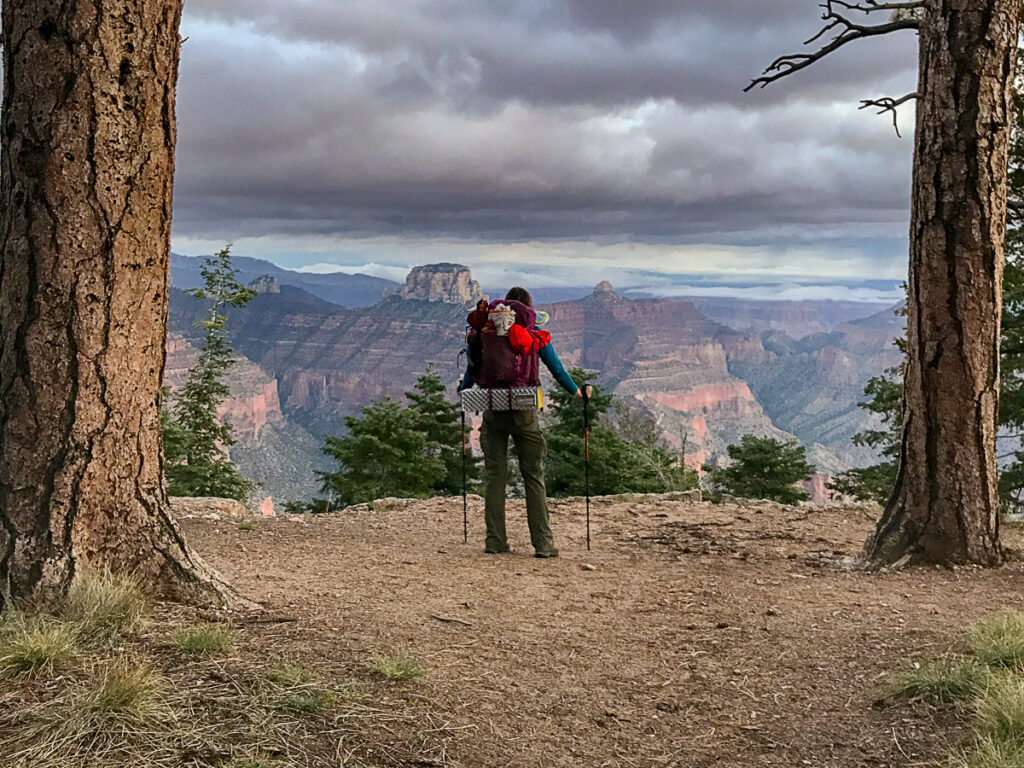
The Rim Trail, like its name suggests, runs along a section of the South Rim. Because you don’t go into the canyon itself, there’s not much elevation gain, making it a mellow winter hike.
The entire trail is nearly 13 miles one way, and in peak season, there is a shuttle to take you back to the start. In the winter, the shuttle doesn’t go past Grand Canyon Village, so it’s probably best to just hike a section of the trail and then turn around.
South Kaibab Trail
This is one of the most popular trails in the Grand Canyon, and it’s especially nice in winter since almost all of it is in the sun. The first quarter-mile, known as The Chimney, stays shaded though, so it gets extremely ice-covered in the winter.
You can take the South Kaibab Trail all the way down to the river if you get a backcountry permit to camp overnight. Otherwise, it is recommended that you turn around at Skeleton Point (about 3 miles in) for a day hike.
Pro Tip: Pack traction and hiking poles to help you with the icy sections.
Hermit Trail
Due to its southern exposure, Hermit Trail is an excellent winter trail with less snow and ice than most other trails. This trail is quite difficult though, with a very steep (almost 2,000 feet) drop-down in the first 2.5 miles.
The entire trail is nearly 20 miles round trip, but you can turn around at or before Breezy Point for a day hike. Hermit Trail is really only recommended for experienced hikers who are aware of important desert hiking tips .
Bright Angel Trail
Bright Angel Trail is the most popular trail in the Grand Canyon. It’s nice to hike it in the winter without the crazy crowds. However, the upper section of the trail is north-facing and can hold packed snow and ice throughout the winter.
For a day hike, it is recommended that you don’t go farther than Indian Garden (9 miles round trip). If you are extremely experienced and check in with a ranger first, you might be able to make it to Plateau Point before turning around (12 miles round trip).
Pro Tip: One of the most important winter hiking tips is to bring microspikes or other traction to safely navigate the potentially icy and slippery trails in the Grand Canyon in winter.
Check Out the Visitor Center
Located right near Mather Point and next to some of the park’s main parking areas, the visitor’s center is a great place to stop if you need trail maps, information about the park, or want to chat with a ranger.
Plus, if you want to escape the cold you can watch a 20-minute video entitled, “Grand Canyon: A Journey of Wonder” or explore some of the exhibits that go into detail about the Grand Canyon.
You can also shop for souvenirs at the store across the street or head to Bright Angel Bike Rentals since the cafe here serves some of the best coffee in the area.
Enjoy Sunset at Mather Point
Honestly, sunset at the Grand Canyon is magical during any season of the year. However, winter is extra special since the stunning natural landscape here is dusted in a fine layer of snow.
Add in a sky filled with a kaleidoscope of colors and you have a truly one-of-a-kind experience that is not to be missed while enjoying the Grand Canyon in winter.
But, the best part? Shorter days mean that sunset is early. So, you can grab yourself a nice dinner after stopping for sunset views at Mather Point. However, Yavapai Point and Hopi Point are rad places to watch the sun sink beneath the horizon too.
Pro Tip: Don’t leave right when the sun sets. Instead, stick around for a few minutes and see what kind of colors light up the sky.
Go for a Scenic Drive
One amazing aspect of the Grand Canyon in winter (December, January, & February) is that Hermit Road is open to public traffic. The rest of the year, the road is only open to park service shuttle buses, pedestrians, and cyclists. This means you’ll get to enjoy one of the most scenic drives in the US from your own vehicle.
Hermit Road boasts some of the most spectacular Grand Canyon viewpoints with 9 canyon overlooks. Check out The Abyss for a steep vertical view into the canyon or Pima Point for a glimpse of the Colorado River.
Pro Tip: For sunset or sunrise, head to Hopi Point or Mohave Point, both of which have extensive views into the canyon and of the Colorado River.
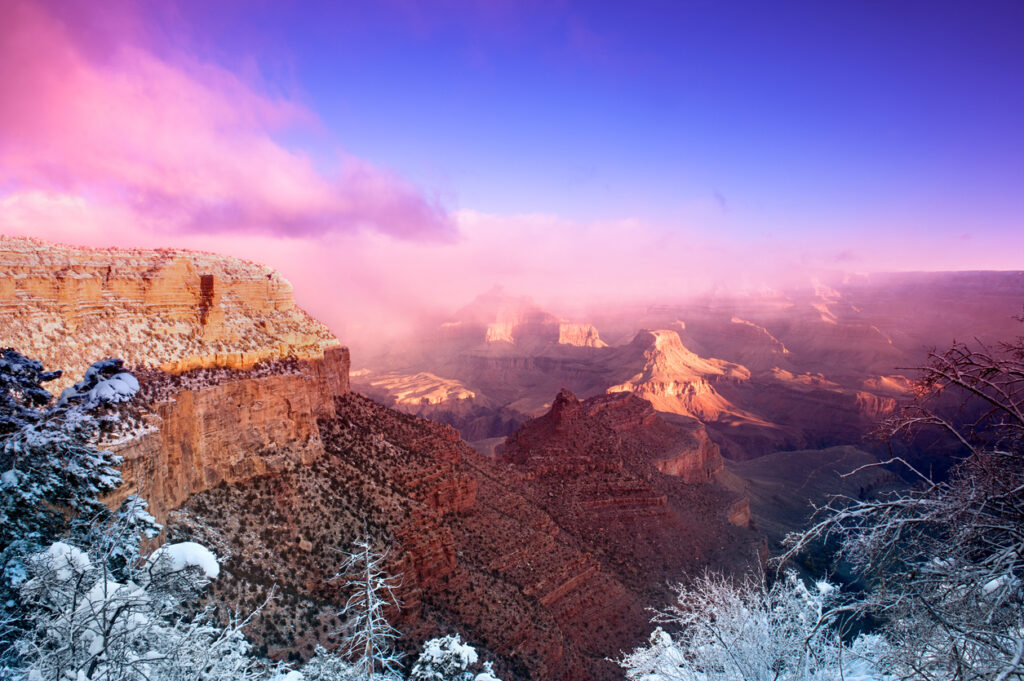
Yavapai Museum of Geology
If the Grand Canyon winter weather gets to be a little too much, you can take shelter from the cold and snow in the Yavapai Museum of Geology.
The museum is located between the Visitor Center and Grand Canyon Village, and it features large picture windows that look out over the canyon. You can also learn about the geology that formed the Grand Canyon and see a topographical relief map of the whole canyon.
Winter Camping in the Grand Canyon
If you’re not a planner and can handle the cold, winter camping in the Grand Canyon is an amazing experience. It doesn’t require the many months in advance reservations you need to get a campsite during peak season.
Some of the campgrounds in the Grand Canyon are closed in the winter. But you can camp at Mather Campground on the South Rim.
Or get a backcountry permit and backpack into Bright Angel Campground deep at the bottom of the canyon. You can also cross-country ski, snowshoe, or hike to the North Rim Campground for a full winter experience.
With all these activities – and without the extreme desert heat of the warmer months – the Grand Canyon is really one of the best national parks to visit in the winter .
Use Shuttles to Access Viewpoints in Inclement Weather (or Self-Drive Under Good Conditions)
Winter in the Grand Canyon sometimes means less than stellar weather. So, if conditions are not ideal for driving then you start with Mather Point since it’s just a short walk from the visitor center.
From here you can use a shuttle that will take you along either the Village Route (aka Blue Route) or the Kaibab Rim Route (aka Orange Route). It’s a great option if you don’t want to drive through the snow since the shuttles are free and depart every thirty minutes.
Then, once on the shuttle, you can use the Kaibab Rim Route to access the Yavapai Geology Museum, Yavapai Point, Pipe Creek Vista, Yaki Point, etc. You could then use the Village Route to head into Grand Canyon Village and explore that area.
Just know that you don;t have to use the shuttles here. As long as the roads are open you are more than welcome to drive them on your own.
Where to Eat Near the Grand Canyon in Winter
All of these amazing winter activities in the Grand Canyon do work up an appetite. So when the hiker hunger strikes, here are a few places to nosh.
Since the North Rim is closed in winter, most of your dining options will be near the South Rim of the Grand Canyon.
For a splurge-worthy meal, make a reservation at El Tovar and enjoy a fine dining experience featuring upscale American food (and specially-crafted Grand Canyon Mule cocktails).
If you’re starving after a long hike and just want to be your true dirtbag self, check out Fred Harvey Burger in the Bright Angel Lodge for lunch.
You can also visit the Maswik Food Court for sandwiches and salads. The Maswik Pizza Pub lets you scarf down several slices with a cold beer.
COVID Note: Fred Harvey Burger and the food court are open for to-go service, but the pizza pub is currently closed.
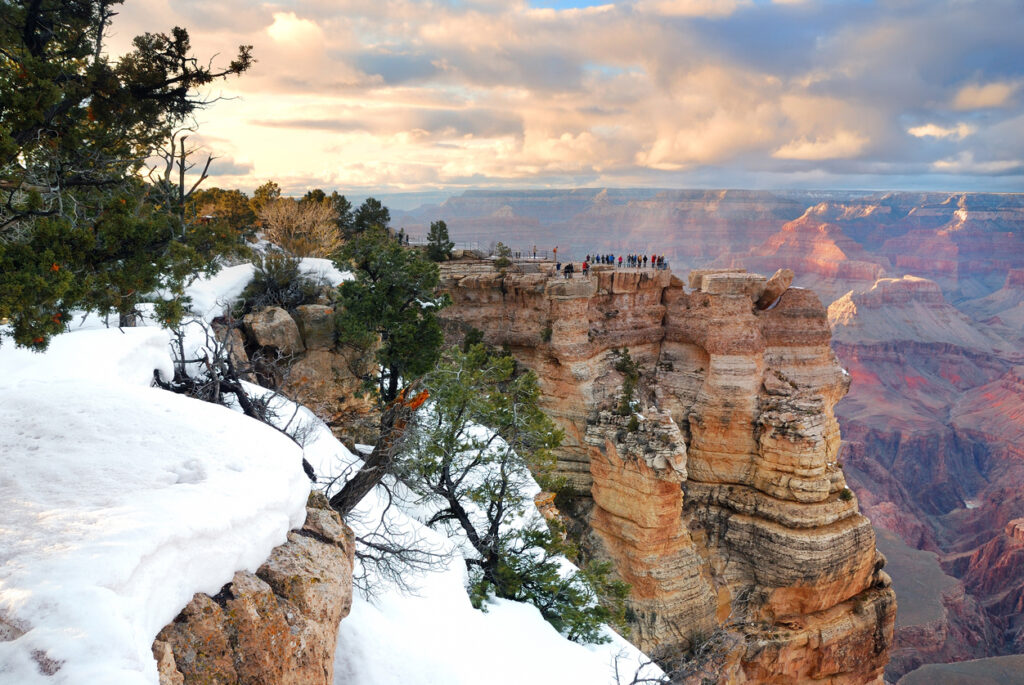
You’ll also find a few dining options at the West Rim. For food with a view, Sky View restaurant can’t be beaten with floor-to-ceiling windows overlooking the canyon.
Pro Tip: This casual American restaurant requires general admission tickets to Grand Canyon West – separate from the national park.
In the town of Peach Springs, AZ, Diamond Creek Restaurant in the Hualapai Lodge offers comfort food and local favorites, including delicious frybread and Hualapai tacos.
Inner Canyon
Phantom Ranch Canteen , deep in the bottom of the canyon, is a highly-coveted dining experience that requires a hike or mule ride to the bottom of the canyon (and then back out again).
Reservations are required and are still popular in the winter, though they might be slightly easier to get than during peak season.
COVID Note: There are no sit-down meals in “the near future” and “only to-go breakfasts, sack lunches, and to-go dinners will be available.”
Where to Stay Near the Grand Canyon in Winter
There are plenty of options for camping and lodging in and around Grand Canyon National Park. Camping reservations are recommended, even in winter.
In the Park
Even during the winter months, you can camp in the Grand Canyon National Park. While some campgrounds close in the winter, Mather Campground on the South Rim is open year-round.
Reservations are recommended most of the year and can be made through Recreation.gov , but it is much easier to snag a campsite December-February.
You can get a backcountry permi t to camp at Bright Angel Campground at the bottom of the canyon or to winter camp at the North Rim campground.
If you’re not up for winter camping, there are several lodges in Grand Canyon Village on the South Rim that is open year-round, including the Bright Angel Lodge and the El Tovar Hotel.
Even in the winter, it’s a good idea to make lodging reservations in advance if you can.
Outside the Park
The nearby town of Tusayan has many hotel options, ranging from the affordable Red Feather Lodge to the 5-star Grand Hotel at the Grand Canyon. The Best Western Premier Grand Canyon Squire Inn is a great value for the price.
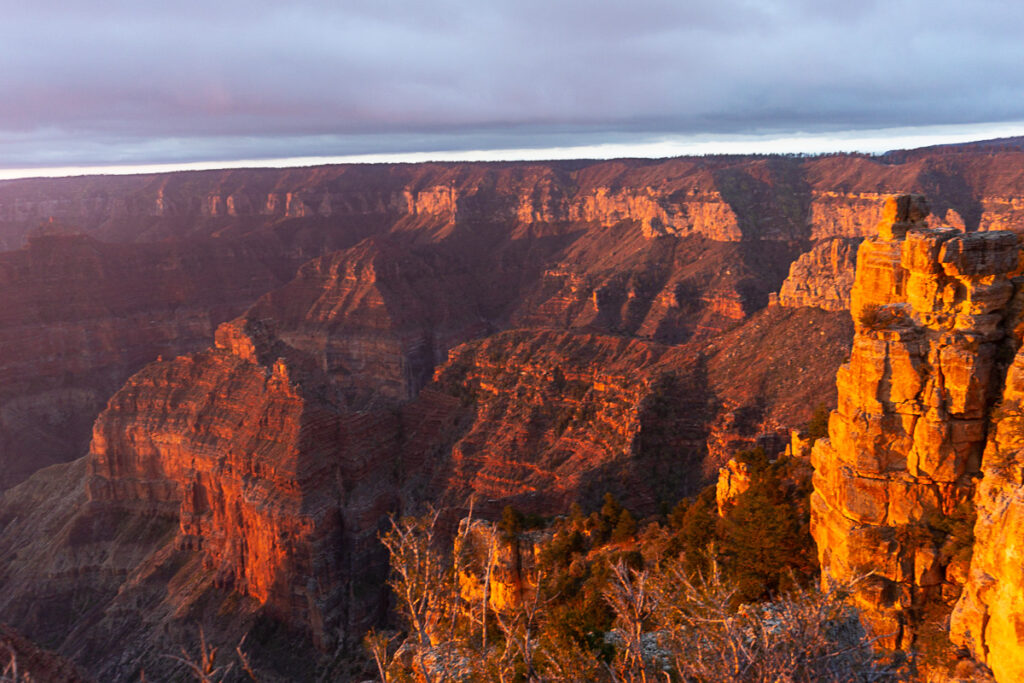
What to Wear for a Winter Trip to the Grand Canyon
The key to being comfortable during the winter in the Grand Canyon is to dress in layers. You’ll want to stay away from cotton, as it’s not a good insulator and when wet, you can get hypothermia.
Here are a few must-have layers for winters at the Grand Canyon.
- Fleece jacket
- Puffy jacket
- Wind breaker
- Sunglasses (don’t forget the sunscreen too!)
- Hiking boots or water proof hiking shoes
- Non-cotton pants
- Lightweight long underwear base layers (you can always shed these by changing in your car).
Additional items you may want to bring with you include:
- Water bottle – plan on drinking 2 – 3 liters per day, more for long, tough hikes
- Plenty of snacks. A pack lunch isn’t a bad idea either
- Thermos filled with your favorite hot beverage
- Small hiking bag
- Microspikes or other traction
- Spare pair of shoes and dry socks for driving around
- Camera with a USB charger
Additional National Parks to Visit in Winter
Wanna get the most of your national parks experience? Winter is an amazing time to check out these fantastic national treasures:
- Bryce Canyon in Winter: What You Need to Know
- The Complete Guide to Visiting Arches National Park in Winter
- An Expert’s Guide to Canyonlands National Park in Winter

Meg Atteberry
Meg is a long-time Colorado local and outdoor industry professional. She's spent the last 15 years hiking, climbing, mountaineering, and canyoneering all over Colorado, Utah, Arizona, and Nevada in search of the best views. She's written for Outside Magazine, REI, Backpacker Magazine, and appeared on the Weather Channel.
Let’s connect!

Meg aka Fox is a 30-something who's born to explore. Toddler mom, queer, and neuro-spicy her favorite things to do are climb in the alpine and camp in the desert. Her mission is to get you out on your greatest adventure.

What to Do in Grand Canyon in Winter
Updated May 16, 2023
// By Margherita
Would you like to visit Grand Canyon, but without the crowds? We have the perfect solution – just head to Grand Canyon in winter!
If you’re debating the idea of visiting the Grand Canyon in winter , listen to me – just do it!
Forget the summer crowds, queues and heat – visiting Grand Canyon in winter is a relaxing, utterly pleasant experience. Yes, it’s cold, and many hiking trails into the canyon are covered in snow well into spring, but besides this, the benefits of visiting in December, January and February far outweigh drawbacks.
When we planned our American Southwest road trip , knowing we could only go between January and February , I won’t deny we were a little worried. Would we be able to explore the vast desert landscapes? What about enjoying back country hikes and scenic drives without having to worry about winter storms?
Guess what – there was no need to worry. The weather throughout our trip was fantastic – sunny, dry and cool throughout, perfect to hike in Sedona and visit national parks like Zion and Joshua Tree . And when we did find snow, like in Bryce Canyo n for example, it just made the place even more magical.
Grand Canyon was no exception. We found winter a perfect time to visit – the weather was sunny and clear, hotel prices were way down compared to summer, and there weren’t many people around.
We spent two wonderful days visiting Grand Canyon in mid-February , and we urge you to plan a winter visit if possible – just keep reading the post to find out everything you need to know!
No time to read? Check out this tour of Grand Canyon and other nearby national parks!
- 3 Days Winter Tour of Grand Canyon, Antelope, Monument Valley, and Zion National Park

Things to Know About Grand Canyon in Winter
Grand canyon winter closures.
Grand Canyon National Park is divided in two sections, the North and the South Rim. The South Rim is open year round , whereas the North closes every year between October and May – meaning it’s closed all winter.
This Grand Canyon in winter guide will focus on the South Rim – the most visited of the two, where you’ll find most accommodation options and facilities
Grand Canyon Winter Weather
I’ll repeat it probably a million times throughout this post – winter is a great time to visit Grand Canyon.
It does get cold, but not as much as you may think. In December and January , average daytime temperatures reach 45°F (7°C), and drop to 18°F (-8°C) at night. February is slightly warmer, with an average of 48°F (8°C) during the day, and 20°F (-6°C) at night.
Don’t forget that Grand Canyon is at approximately 7000 ft (2100 meters) above sea level. Finding snow is a possibility – there are a few snowstorms each year, usually followed by sunny days, so the snow may have melted by the time you visit.
We visited in mid-February and found no snow. To be honest, we were a little disappointed – Grand Canyon in winter, covered in snow, would have been magical!
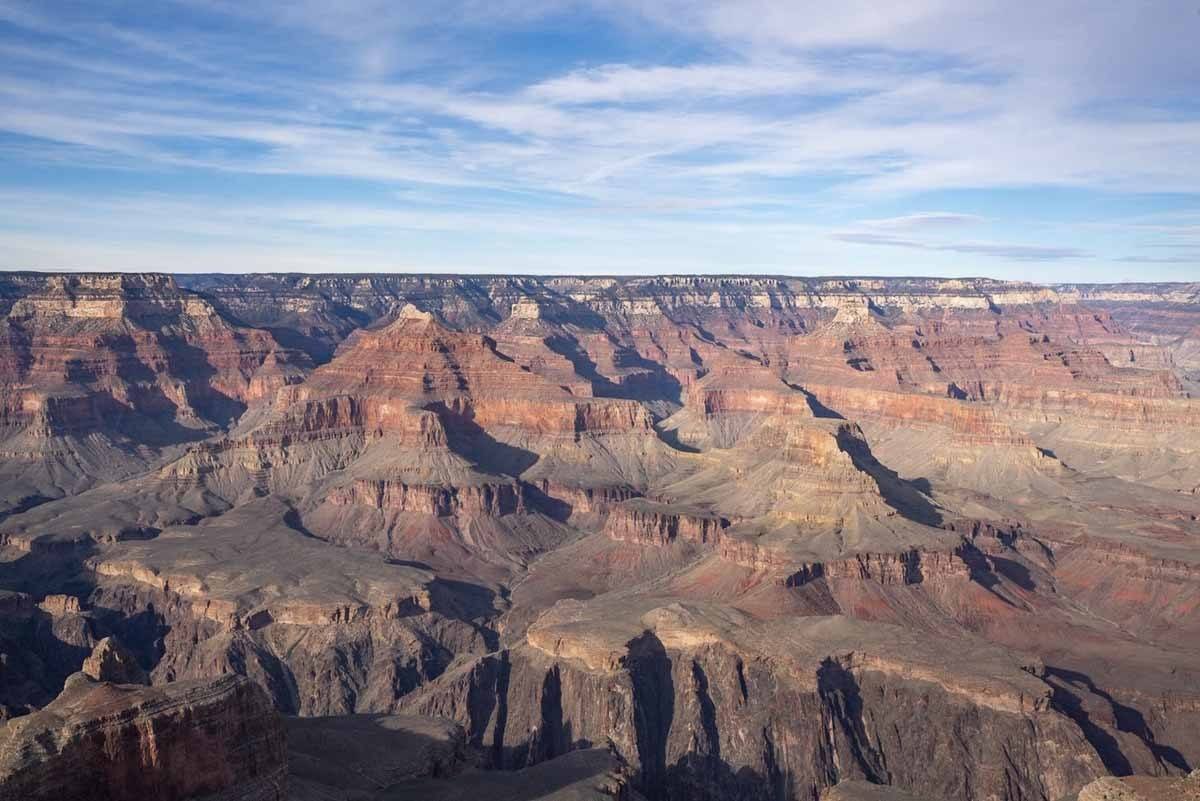
Driving in Winter at Grand Canyon
As we said above, snowstorms do occur from time to time. Roads are cleared regularly after heavy snowfall , but they may be closed for a time while snow is cleared.
Try to avoid driving if a snowstorm is forecast. In case you get caught by one, please be very, very careful, proceeding with caution if visibility is impaired.
Otherwise, stop somewhere until conditions improve. Not many people visit Grand Canyon in winter anyway , so you can keep your travel plans flexible!
Getting Around Grand Canyon in Winter
There are four shuttle bus routes around the Grand Canyon South Rim , two of which run year-round – the Kaibab/Rim Route (orange) , connecting the visitor centre to the South Kaibab trailhead, and the Village Route (blue) , from the visitor centre to locations around Grand Canyon Village.
The other two routes, to Tusayan Village (purple) and the Hermits Rest Route (red) , don’t operate in winter.
The Hermits Rest Route is accessible by shuttle bus only between March 1st and November 30th – but if you’re at Grand Canyon in December, January or February , you’ll have to drive yourself to access viewpoints along that route. This was actually a huge advantage in our opinion, allowing us to explore at our own pace!
Crowds at Grand Canyon in Winter
Small crowds are probably the main benefit to visiting Grand Canyon during the winter months! Less than 10% of yearly visitors to Grand Canyon head to the site during the winter months, so crowds are usually not an issue.
Having said that, if you visit during the Christmas/New Year holidays , or during public holidays like Martin Luther King’s Day (third Monday in January) or President’s Day (third Monday in February), expect to find significantly more visitors.
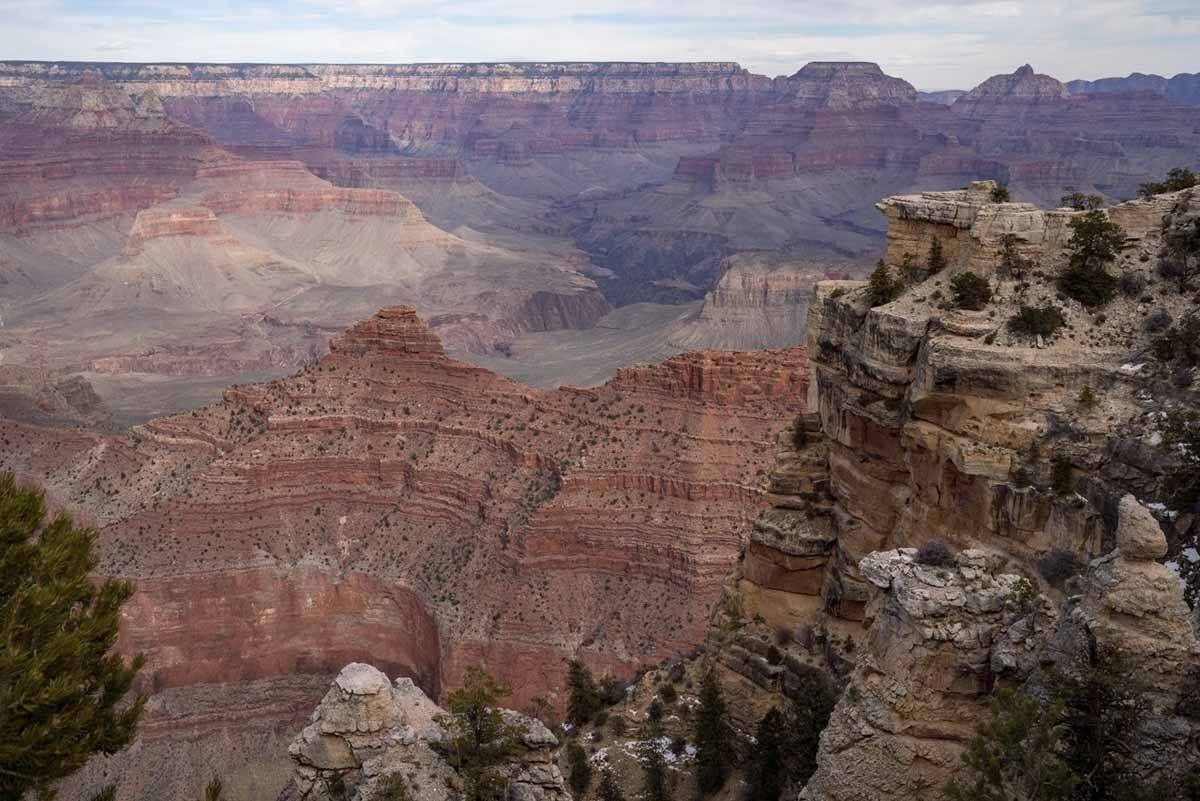
Grand Canyon Winter Hiking
Winter is a great time to hike into Grand Canyon. You don’t have to worry about the extreme heat found in the region during most of the year, take gallons of water with you and wake up at the crack of dawn to hit the trail.
However, there’s another dangerous enemy to contend with – hypothermia. Make sure you check for weather and trail conditions before setting off, and bring suitable footwear and clothing for cold weather.
Please be aware that hiking into Grand Canyon is a serious endeavour , only to be undertaken by experienced hikers. Remember you’ll be hiking down first, and then up – Grand Canyon is basically an inverted mile-high mountain, so the hardest part of the hike will be the return trip.
Please check this page on the NPS website for more info about safe hiking in Grand Canyon.
If you’re planning to hike into the canyon and stay overnight , don’t forget you need to apply for a Backcountry Permit . Find all info about it here!
Alternatively, this winter tour includes hiking in safe parts of Grand Canyon and Zion National Parks.
Distance 13 miles / Elevation 200 ft / Time 5/6 hours

If you’re visiting the Grand Canyon in winter and planning to do a little hiking, this is definitely the easiest option! The Rim Trail runs all along the edge of the Grand Canyon, from South Kaibab Trailhead all the way to Hermits Rest on the western side.
The entire length of the trail is 13 miles, but you can hike just part of it and catch the shuttle bus back. Just don’t forget that in winter, shuttle buses don’t run west of Grand Canyon Village. If you are planning to go further, you’ll have to arrange for someone to pick you up.
The Rim Trail is flat and a good part of it is paved, making it accessible to wheelchairs. The most visited section is the one between the visitor centre and Yavapai Point, approximately 1.5 miles, where you’ll also find interpretive signs along the way. This section feels more like a walk to a tourist attraction than a hike, but it’s also the easiest and most accessible option.
The first part of the trail , from South Kaibab Trailhead to the visitor centre, and the last part past the Village to Hermits Rest , are far less busy and a good option if you want to feel surrounded by nature and the vastness of Grand Canyon. We found the section between Hopi Point and the Abyss to be particularly scenic!
Check out this tour of the South Rim from Las Vegas , including a short hike and scenic locations!
Bright Angel Trail
Distance 12 miles / Elevation 2900 ft / Time all day
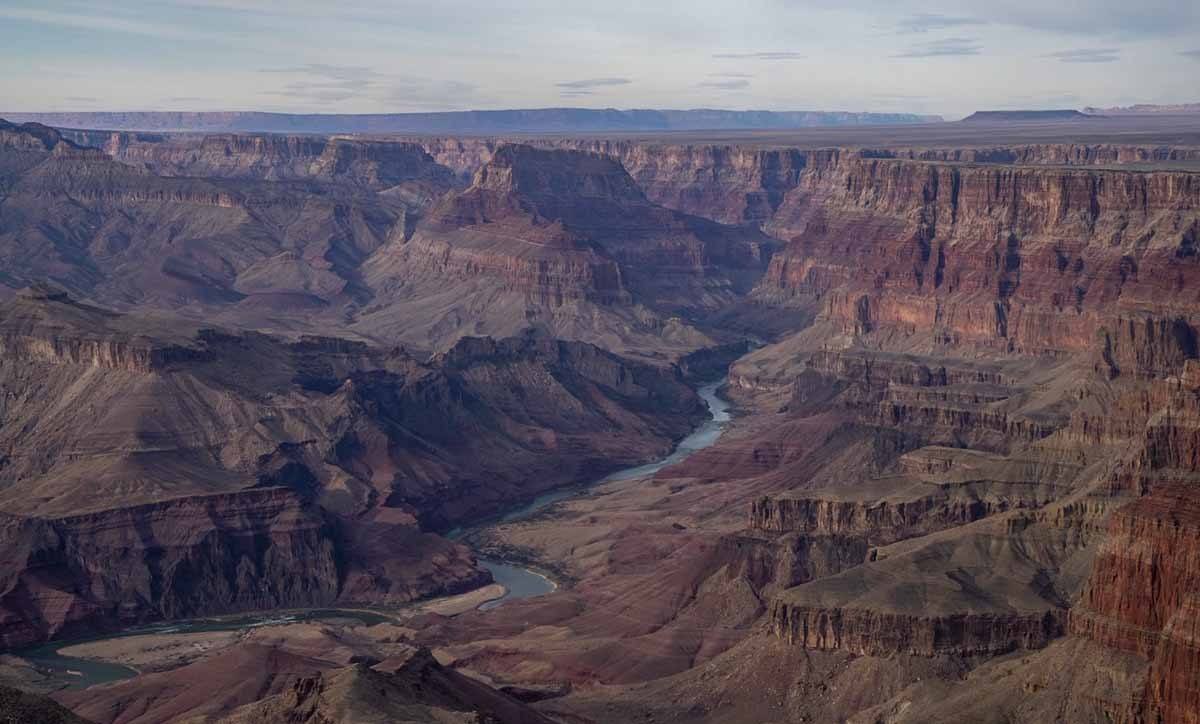
The Bright Angel Trail is one of the two most popular hiking trails into Grand Canyon, and in winter it’s a possible option for a very strenuous day trip.
NPS recommend NOT hiking from the Rim to the Colorado River and back in one day , so the day trip version of the Bright Angel Trail stops in a location called Plateau Point , where you can get a view of the river.
Hiking to Plateau Point and back covers a distance of 12 miles , but due to the elevation it will take you the whole day. In case that’s too long, you can turn around at the 1.5 Mile or at the 3 Mile Resthouse , depending on your how long you want your hike to be.
The Bright Angel Trail is well maintained and popular for a reason – it offers great views of the canyon throughout. The main challenge about hiking it in winter is the steep and north-facing initial part , often icy and slippery until early spring. Hiking poles and traction devices are highly recommended!
This 2-day tour from Las Vegas includes views from Bright Angel Point at the start of the trail, as well as a guided tour of
South Kaibab Trail
Distance 6 miles / Elevation 1500 ft / Time 4/5 hours

Along with Bright Angel, South Kaibab Trail is the second most popular trail into the canyon. To hike it all the way to the river and back, you’ll need a minimum of two days – make sure you apply for a Backcountry Permit following the link posted above if that’s the case.
Otherwise, if camping in winter is not your idea of fun, you can also hike part of the South Kaibab Trail as a day trip . In that case, the NPS recommend NOT going past Skeleton Point , a distance of 6 miles return, from where you get a view of the Colorado River.
The benefit of hiking the South Kaibab Trail compared to Bright Angel is that it’s considerably sunnier , so ice is less of a problem. The only part that stays icy all winter is the first 1/4 mile, known as the Chimney.
A shorter option along the South Kaibab Trail is hiking 1.8 miles return to the scenic spot known as Ooh Aah Point – I guess the name gives it away!
Would you like to know more about hiking in the US? Here’s our 9 best offbeat hikes in the US post!
Other Things to Do at the Grand Canyon in Winter
Drive to scenic spots.
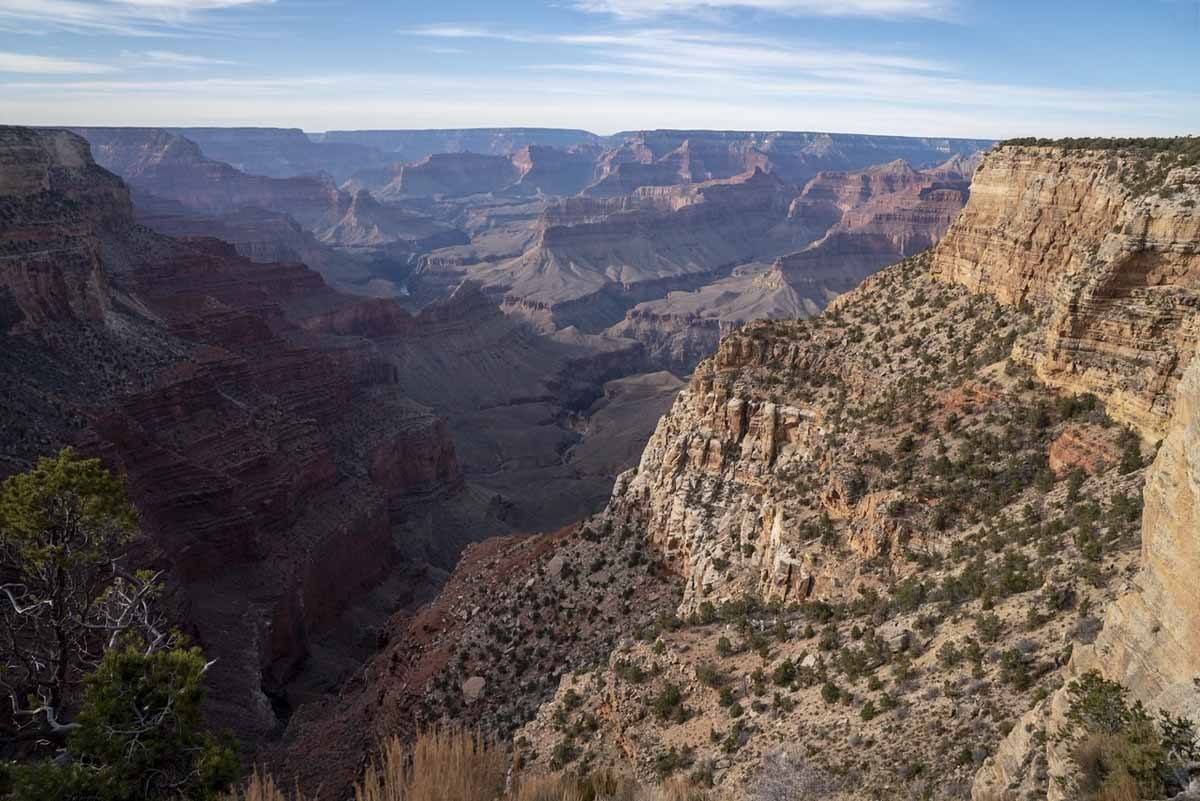
If you’re not planning to hike, you’ll probably spend most of your time at Grand Canyon driving to all the various viewpoints located along the rim.
Remember, Grand Canyon is grand indeed – there’s a whopping 32 miles between Desert View, the easternmost viewpoint, to Hermits Rest , all the way to the west. In between, there are more than a dozen scenic spots where you can stop and take pictures, so make sure you allow at least half a day to exploring , more if you want to hike along sections of the Rim Trail.
Viewpoints on the eastern part of the canyon, along Desert View Drive, tend to be less busy – but the most spectacular ones are the ones in the west , between the visitor centre and Hermits Rest.
Our favourite Grand Canyon scenic spots were Grandview Point in the east and Mohave Point in the west – but really, they are all worth checking out!
Watch the Sunrise and Sunset

Another benefit of visiting Grand Canyon in winter is that you don’t need to wake up super early for sunrise, and wait around until late evening for sunset!
During our Grand Canyon visit in February, sunrise was at 7 AM (yes, that’s still early, but better than 4 AM!) and sunset was around 6 PM. Both are really, really worth sticking around for – but make sure you go to the right viewpoints!
We watched the sunset from Powell and Hopi Points , which are actually right next to one another – but to be honest, we liked Hopi Point the best. Mather and Yavapai Point are also good sunset options.
For sunrise , we headed to Mather Point , as it was the closest to where we were staying. It’s also the nearest viewpoint to the visitor centre, so expect it to be consistently busier than other locations.
You can also watch sunset from a secret location on this overnight tour of the Grand Canyon , also including a visit to the Hoover Dam!
Climb Desert View Watchtower

Desert View Watchtower is located right next to the East Entrance Station , so if you are getting into Grand Canyon National Park from that side, it will be your first view of the canyon!
Besides checking out the canyon, we also recommend climbing to the top of Desert View Watchtower , a 70 ft-high stone tower built in the 1930s in the style of Puebloans from the Four Corners region.
You can climb the tower to the top, and enjoy the view of Grand Canyon from various levels, but don’t forget to have a look inside the tower as well. You’ll find murals by a Hopi artist, and cultural demonstrations are also held.
Join a Ranger Program
Similarly to most other US national parks, Grand Canyon also offers a series of free ranger-led programs.
There is a daily geology talk in the morning, and a wildlife talk in the afternoon, plus a calendar of special programs and exhibitions – check this page to know more!

How Many Days to Spend at Grand Canyon in Winter?
If you are not planning to go hiking into the canyon, two days are enough to explore Grand Canyon in winter , driving to all scenic spots along Desert View Drive and on the way to Hermits Rest, walking the interpretive trail around Mather Point and hiking some short sections of the Rim Trail.
If you want to hike either Angel’s Landing or the South Kaibab Trail as a day trip , you’ll need a full extra day for that – bringing the total to three days to visit Grand Canyon in winter.
Where to Stay In Grand Canyon
-in the national park.
Another advantage of visiting Grand Canyon in winter is that you can easily get a room at one of the lodges located inside the National Park.
It may well cost a pretty penny, but this will give you the advantage of being right next to the majestic canyon – perfect if you want to watch the sunrise without having to wake up too early.
We stayed at Yavapai Lodge, and for $160 we got a spacious double room with ensuite, in a quiet spot surrounded by the forest about 15 minutes walk from the main visitor centre at Mather Point. The only downside is that there was no Wi-Fi – phone signal is very spotty all through Grand Canyon.
Here are some of the best accommodation options inside the park , all in the vicinity of Grand Canyon Village.
- El Tovar Hotel – the best upmarket option in the park
- Bright Angel Lodge and Cabins – accommodation in rustic lodges from the 1930s with views of the South Rim
- Kachina Lodge – a more contemporary option in the heart of the village, with great views
- Thunderbird Lodge – similar to Kachina Lodge, also in the village
- Maswik Lodge – a 280-room lodge surrounded by forest, a quarter-mile walk from the Rim
-Outside the Park
If you don’t want to stay inside the park, the closest town is Tusayan , 8 miles south of the visitor centre. There are several accommodation options there, usually a bit cheaper than park lodges.
In winter, you are more than likely to find good offers if you book in advance. Here are some great Tusayan hotel options!
- Holiday Inn Express Grand Canyon – this hotel has great winter specials!
- The Grand Hotel at the Grand Canyon – a stylish luxury option with spacious rooms
- Grand Canyon Plaza Hotel – another reliable option with a spa and swimming pool!
- Best Western Premier Grand Canyon Squire Inn – with four restaurants and even a bowling alley!
- Canyon Plaza Studio & Apartments – perfect if you’re looking for an apartment!

Grand Canyon In Winter: 10 Things You Need To Know
by Mark and Kristen Morgan
Published: January 15, 2022
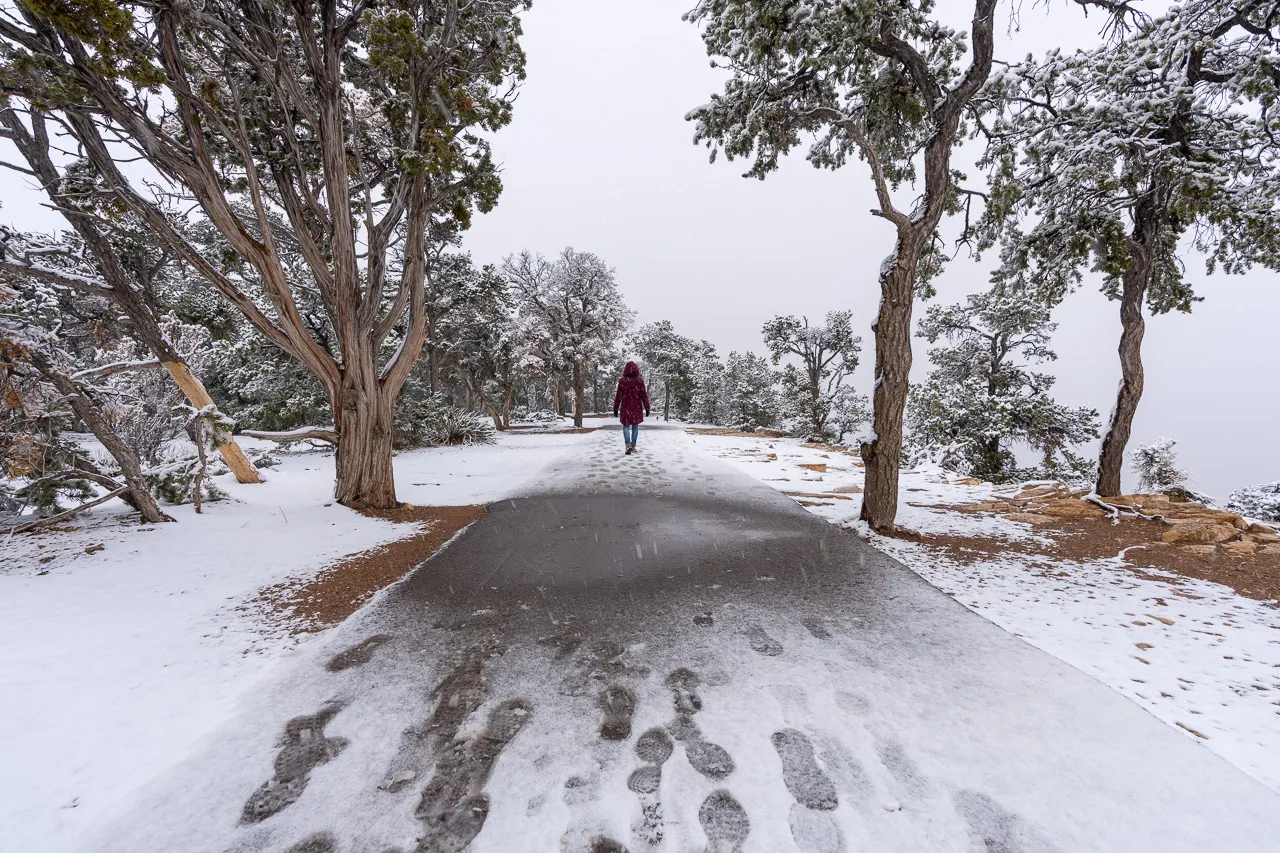
Are you thinking about visiting the Grand Canyon in winter ? We are going to answer 10 important questions you might have about your trip to the Grand Canyon in December, January or February, including key things to know about weather, costs and crowds.
Is it worth visiting Grand Canyon in winter?
Yes! We have personally photographed and hiked the best of Grand Canyon in December and we even got a snow day. In truth, we think December is one of the very best times of year to visit Grand Canyon South Rim and we would likely go again at the exact same time of year.
In this guide we will cover:
- 10 key things to know about visiting Grand Canyon in the winter
- In depth information about temperatures, prices and tourism
- What you need to know about hiking and photography
Let’s get right into the 10 most important things you should know about planning a Grand Canyon winter trip!
Our Grand Canyon Experience In Winter
We have been traveling the world non stop since 2018 and we can safely say there have only been a handful of landscapes that truly made our eyes widen and stoped us in our tracks. Seeing the immense vastness of the Grand Canyon for the first time was one of those moments.
During our most recent visit to Grand Canyon South Rim in December 2021, we were fortunate enough to have both a beautifully sunny and warm winter day, followed in stark contrast by a blizzard-like snow day.
It was a completely different experience to the first time we visited the Grand Canyon in October 2019. In the fall we enjoyed comfortable weather throughout and it was considerably busier around the park.
At the Grand Canyon in December we day hiked in shorts and t-shirts down to the Colorado River and back up to South Rim on our first day. The next day we built a mini-snowman at Yavapai Point!
But changeable weather is just one aspect of a visit to the Grand Canyon in winter. If you are not yet sure which season to plan your trip, read our month by month breakdown to the best time to visit Grand Canyon next.
Why Visit The Grand Canyon In Winter?
The winter months of December, January and February are all excellent times to visit Grand Canyon South Rim because you will benefit from fewer crowds, cheaper hotel rooms with more availability, quieter trails and safer conditions for hiking into the canyon.
In spring and fall months you will still find reasonably good value at hotels and the weather will be warmer but the Grand Canyon is busier with tourists.
Summer is busy, hot and expensive at the Grand Canyon. We would recommend avoiding June, July and August trips to Grand Canyon National Park, especially if you plan to hike because it can be dangerously hot.
The major downside to visiting Grand Canyon South Rim in winter is extremely cold mornings and evenings, as well as the chance that snow could prevent you from hiking.
Let’s get into those 10 pressing questions!
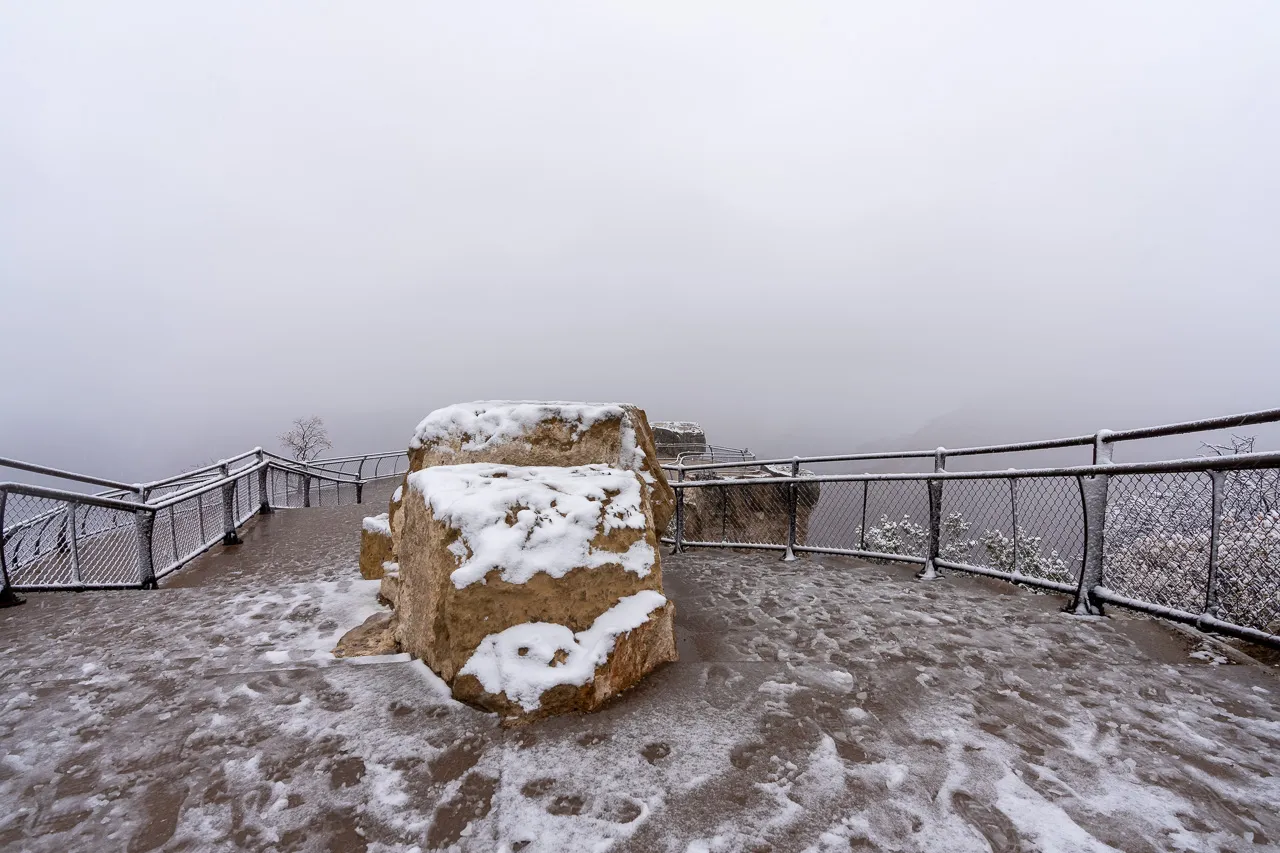
1. Is The Grand Canyon Crowded In Winter?
The Grand Canyon is one of the very best national parks in the USA and even the world. It is one of the major hotspots for millions each year who plan American southwest itineraries and it is one of those true bucket list destinations for international travelers.
But we can tell you from experience that the winter season is typically far less crowded at Grand Canyon South Rim when compared to spring, summer or fall.
We enjoyed the freedom of the park for sunrises, sunsets, hikes and picking hotel rooms when we spent 2 days at the Grand Canyon in December.
Overall, it was such a welcome relief for us because we have spent so many days in national parks when they are crammed full of people, which really isn’t fun!
How Many People Visit Grand Canyon Annually?
According to NPS statistics , the Grand Canyon received the following amount of visitors between 2018 – 2022:
- 2018 – 6,380,495
- 2019 – 5,974,411
- 2020 – 2,911,887
- 2021 – 4,550,921
- 2022 – 4,732,101
As you can see, tourist numbers at Grand Canyon National Park were extremely high in the years before the coronavirus pandemic began.
The data is skewed for 2020 because of lockdowns, but the numbers are growing again into 2022 and will be expected to grow further in the coming years.
The good news is most tourists choose to visit the Grand Canyon between April and October. As a result, the Grand Canyon is relatively quiet and crowd free during the harsher winter months of December, January and February.
How Will Fewer Visitors Benefit You?
- You won’t have to deal with unbearably busy overlooks on South Rim.
- The road will not backup along Desert View Road.
- Fewer visitors means Hermit Road can be opened to cars in winter.
- You won’t have to wait long to hop on a shuttle bus in Grand Canyon village.
- Hiking will be far more pleasant with fewer people on the trails.
- Photography will be much easier with spaces available at popular sunrise and sunset locations.
- Hotels will be more affordable and readily available at the last minute.
We will go into greater detail about these aspects later in this guide. But just these reasons alone are justification for choosing winter as the perfect time to visit Grand Canyon.
2. What Is The Weather Like At Grand Canyon In Winter?
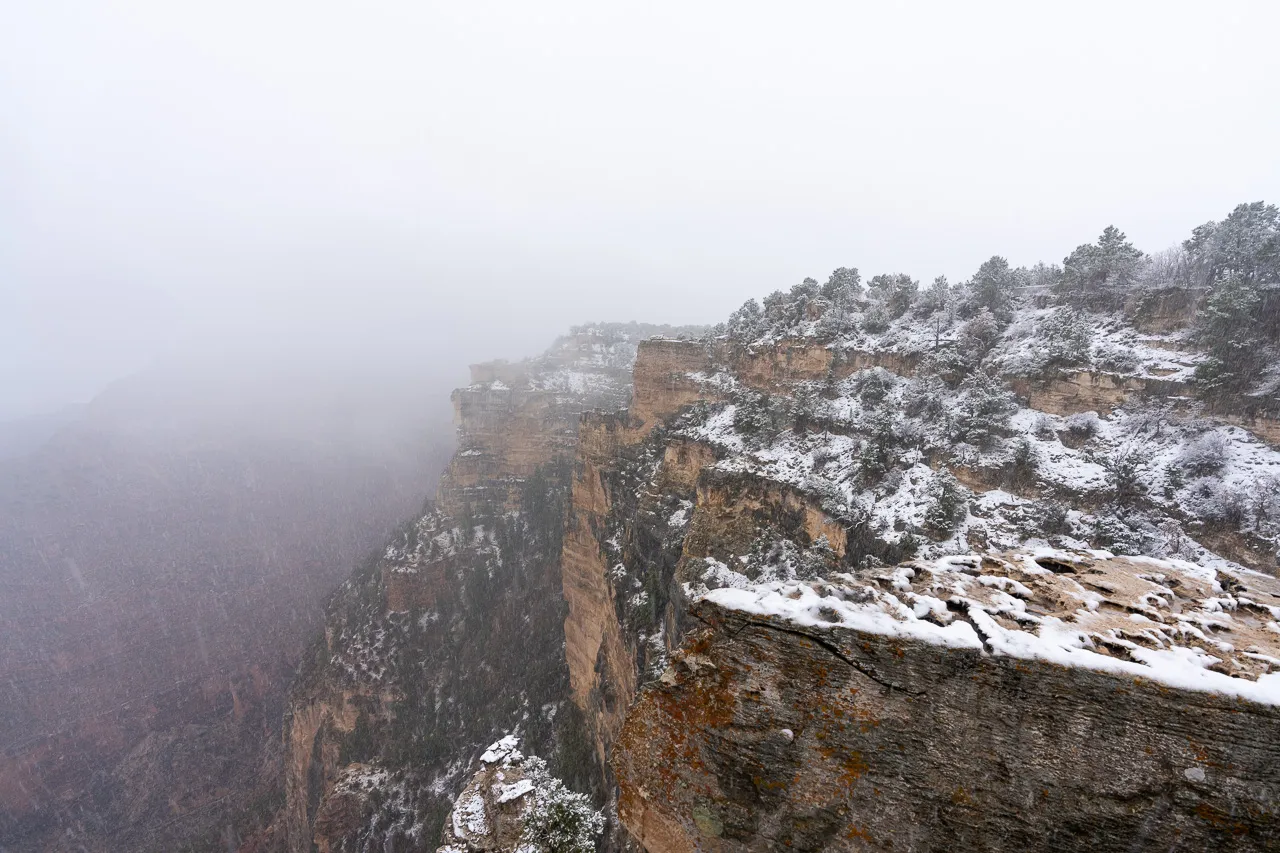
Grand Canyon winter weather is unpredictable and extremely changeable. But you should consider the uncertain weather as both a pro and con to visiting at this time of year.
- Pro – You have an opportunity to experience snowfall in one of the most magical landscapes in America. If it doesn’t snow, you benefit from no crowds at viewpoints and on hikes.
- Con – You could potentially lose a day or two from your itinerary due to snow, fog or extreme cold. This is what happened on our second day at the Grand Canyon in December.
You might have glorious weather or the national park could be completely shrouded in fog throughout your visit to the Grand Canyon in winter. That is the risk you are taking with planning a trip at this time of year.
As far as we are concerned, it is a risk worth taking.
The Grand Canyon is among the best places to visit in Arizona but it suffers from overcrowding unless you visit in winter. It is the unpredictable weather that allows you to see this unique landscape in relative solitude.
Does The Grand Canyon Get Snow In The Winter?
Yes, both Grand Canyon South Rim and especially Grand Canyon North Rim receive significant snowfall each winter. It snowed heavily the second day we were at Grand Canyon in December.
Here are the average snowfall volumes:
- South Rim – 58 inches
- North Rim – 145 inches
- Phantom Ranch – 1 inch
Grand Canyon South Rim receives around 90% of all tourists to the national park. Part of that reason is because Grand Canyon North Rim is closed for the winter season because it gets hit with so much more snow in December, January and February.
Meanwhile, Phantom Ranch at the bottom the Grand Canyon records just 1 inch of snow in winter because the snow melts before hitting the Colorado River 4,500ft below South Rim.
Remember to use extreme caution around the Grand Canyon if it snows or goes below freezing following rainfall. Hiking into the canyon and walking around overlooks with significant drop offs can be treacherous.
Grand Canyon Winter Temperatures
Average Grand Canyon South Rim temperatures remain extremely consistent throughout the winter months of December, January and February.
From experience, we can tell you the temperatures at Grand Canyon in winter are extremely cold on mornings, evenings and nights but it can sometimes warm up enough for comfortable conditions during the day.
Let’s take a closer look:
Grand Canyon December Weather
- Average High – 43F (6C).
- Average Low – 17F (-8C).
The beginning of December is a little warmer compared to the end of December at the Grand Canyon. So if you are planning to visit Grand Canyon at Christmas or New Year, you will be in the depths of the coldest weather conditions.
Grand Canyon January Weather
January is the coldest month of the year at Grand Canyon. You will have less chance of striking it lucky with a milder day but the park will be at its quietest of the entire year and the chance of snow is highest.
Grand Canyon February Weather
- Average High – 47F (8C).
- Average Low – 20F (-7C).
Average temperatures at Grand Canyon begin to increase through February. There is also more daylight and chance of sunshine. You stand a good chance of enjoying milder daytime conditions for hiking.
Source : Weather Spark for Grand Canyon Village.
- Phantom Ranch
It is important to remember that the sheer expanse and dramatic change in elevation in the canyon can influence weather conditions.
For example, it might be warm and dry at Phantom Ranch at the bottom of the canyon, but it could be several degrees colder and even raining or snowing at Grand Canyon South Rim.
Important Grand Canyon winter weather resources:
- Weather and climate
- NPS live webcams
3. Are Grand Canyon Roads Open In Winter?
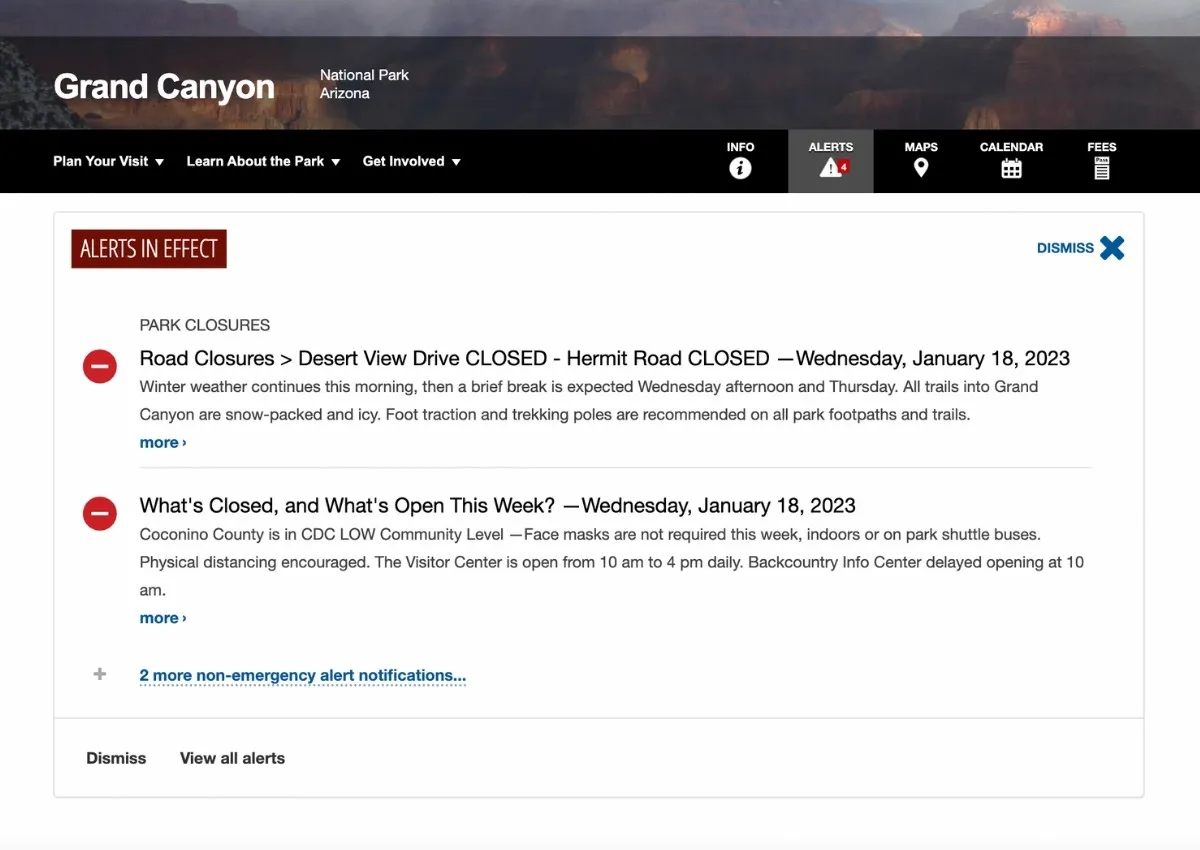
Some of the most popular US national parks close entirely during the winter season. Grand Canyon South Rim remains open year round, but roads are subject to occasional and temporary closures during significantly disruptive weather conditions.
With that said, you would be unfortunate to arrive on a day when the roads were closed. Therefore, you can plan your bucket list USA road trips including Grand Canyon South Rim any time of year.
Here are the two entrances to Grand Canyon South Rim:
- Main entrance – AZ-64 from Williams, Flagstaff or Phoenix to the South.
- East entrance – Desert View Drive from Page ( Antelope Canyon and Horseshoe Bend ) or Moab ( Arches and Canyonlands ).
Our advice is to keep a very close eye on live road conditions inside Grand Canyon if you visit in winter. Any major road closures will appear at the top of the page as you can see in the photo above.
All of the best airports near Grand Canyon will remain open throughout winter outside of exceptional circumstances. It is unlikely you will have any problems with flights or rental cars.
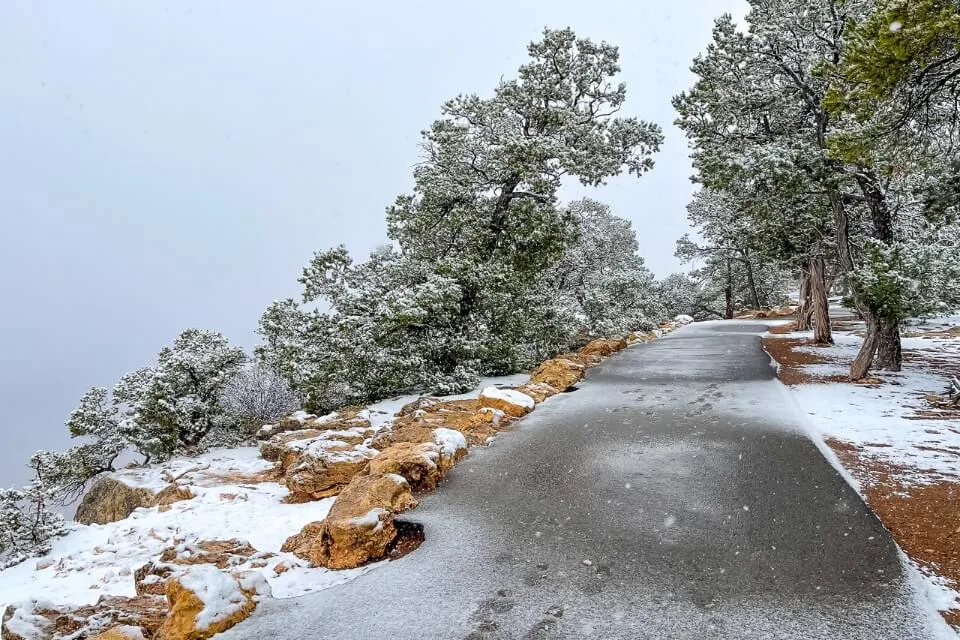
Hermit Road
In order to access the western portion of Grand Canyon South Rim you will need to travel along Hermit Road.
Some of Grand Canyon’s best sunset locations are located along Hermit Road, including the most popular spot at Hopi Point.
Even if you are not interested in sunsets, Hermit Road is where you will find many of the most stunning Grand Canyon views , which means it is a must visit area in the park.
Hermit Road is accessed in the following ways:
- March to November – Access to Hermit Road is strictly via shuttle bus
- December to February – You can drive your own private vehicle along Hermit Road.
This is one of the biggest perks to visiting the Grand Canyon in winter.
Despite the shuttle bus service being frequent and well organized, there’s nothing like being able to drive your own car diectly to and from a sunset.
Desert View Drive
There are several more extremely popular overlooks located on Desert View Drive heading east as far as Desert View Watchtower. But you can drive to these viewpoints in your own vehicle year round.
During the winter season, you can expect parking areas at each overlook to be relatively crowd free and photography opportunities easier to come by.
Need help organizing your visit to Grand Canyon South Rim? Our popular 30+ page Grand Canyon South Rim Guidebook can help you with planning every aspect of your trip.
4. Are Grand Canyon Hotels Expensive In Winter?
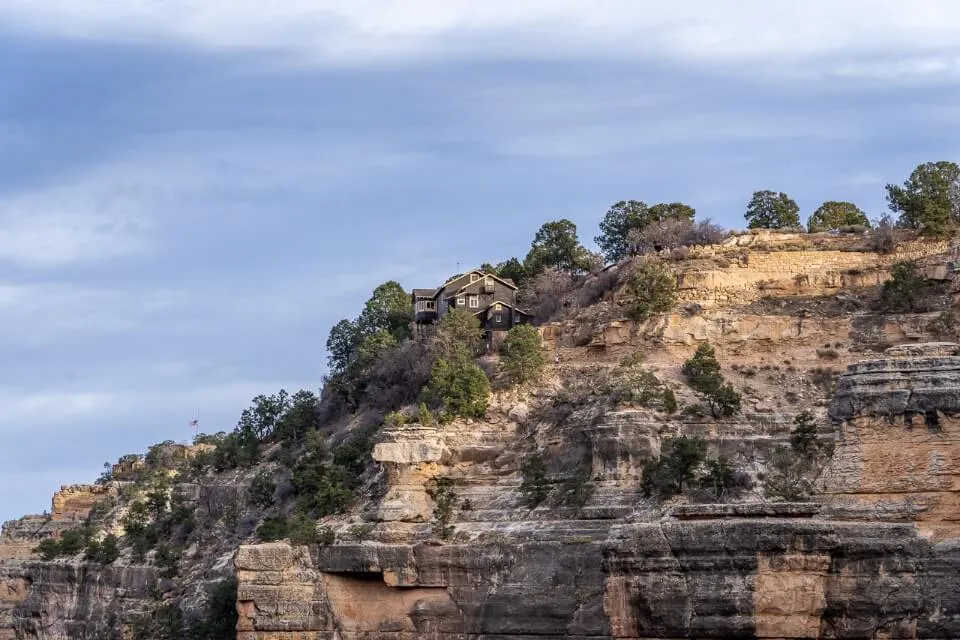
Have you visited any of the most popular US national parks in peak season?
Booking hotels for those bucket list parks like Yellowstone , Yosemite and Zion in peak seasons can be a real problem due to far higher demand than supply, seasonally inflated prices and small to medium sized travel businesses block booking certain lodging options.
Well, it is the same at Grand Canyon if you visit in peak season. Hotels on South Rim fill up months in advance and nightly prices can be eye watering.
So what does everyone do? They rush to book hotels in Tusayan, Valle, Williams and even Flagstaff.
However, if you visit Grand Canyon in winter, you are giving yourself the very best chance at picking up rooms right on South Rim or in nearby Tusayan with excellent value for money.
Booking a last minute getaway to the Grand Canyon will be also be more feasible in December, January or February because demand is considerably lower than in peak season.
We struggled to find any value with a last minute booking when we visited South Rim in October. But we had the pick of the crop when we visited Grand Canyon in December and we stayed in a great hotel at a very reasonable rate.
Lodging Options On South Rim
There are 7 official Grand Canyon lodging options on the South Rim:
- Bright Angel Lodge & Cabins
- Kachina Lodge
- Thunderbird Lodge
- Maswik Lodge
- Yavapai Lodge
You can book rooms at any of the Rim hotel options through Grand Canyon Lodges .
However, we suggest trying to beat the prices with hotels.com by typing the name of each lodge in the going to search box with your dates.
Where To Stay Near Grand Canyon South Rim
Many visitors (including us) prefer to book hotels in towns near Grand Canyon South Rim for more varied amenities and more affordable prices.
You might want to read our comprehensive guide to the best places to stay in and near Grand Canyon South Rim to help with finding the perfect room for your visit.
Tusayan is the closest place with hotels to South Rim.
We stayed at the Best Western in Tusayan and the hotel was great. The only problem with Tusayan is that eating out can be a challenge with limited quality restaurant options.
- Grand Hotel Tusayan
- Best Western Grand Canyon
- Holiday Inn Tusayan
Williams offers the perfect blend of hotel and restaurant selection with proximity to Grand Canyon South Rim.
We stayed at Best Western Plus in Williams the night after our snow day at the Grand Canyon in December and it was a fantastic stay. You can day trip into South Rim from Williams.
- Comfort Inn
- Best Western Plus
- Trapper’s Rendezvous
Want to stay in Williams? Take a closer look at the 10 best Williams AZ hotels on our sister site Best Hotels Anywhere to see if a hotel here better fits your itinerary.
Flagstaff is the largest city near Grand Canyon South Rim and it has a far greater selection of hotels.
It provides the perfect base if you are exploring both Grand Canyon and Sedona in the same trip but it is a longer drive for day tripping into South Rim.
- Fairfield Inn
- Residence Inn
5. Is Winter A Good Time For Hiking In Grand Canyon?
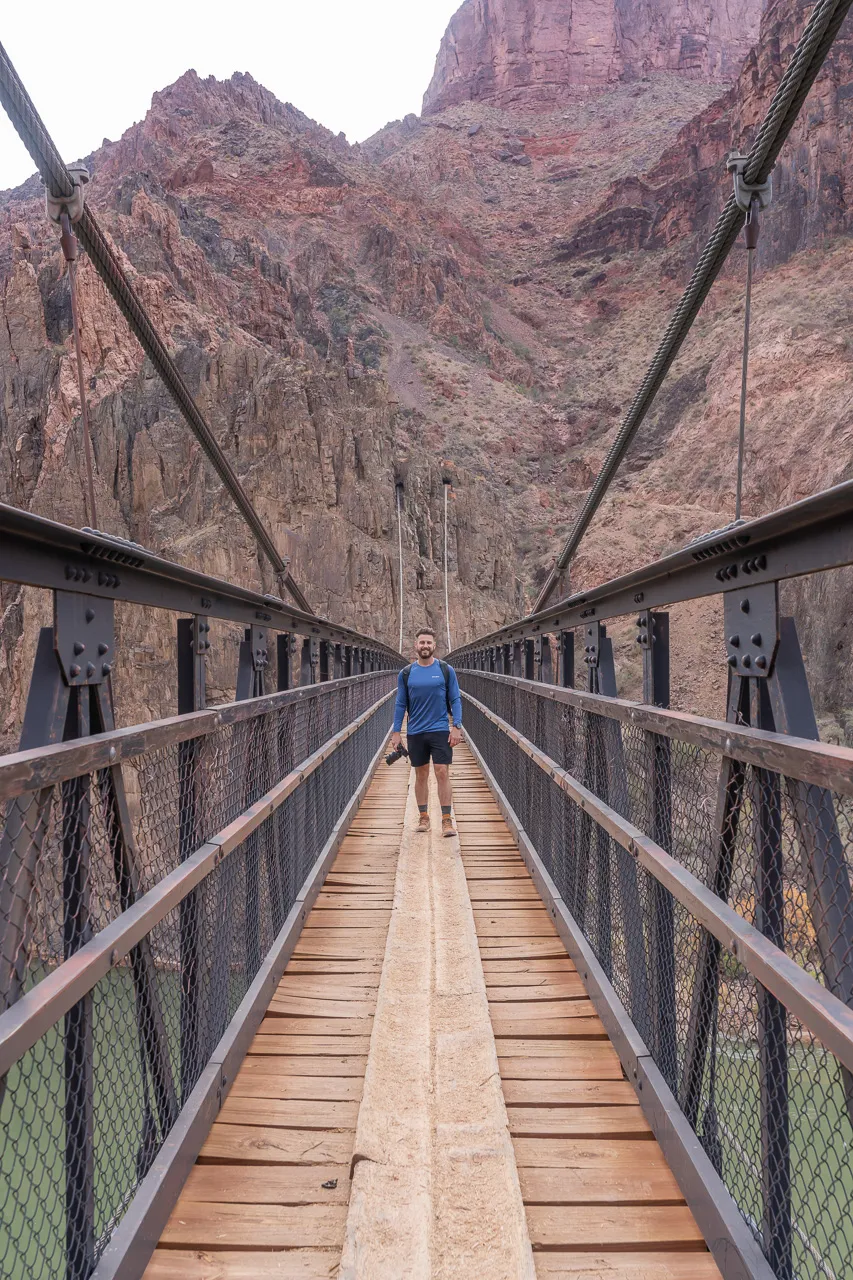
The winter months of December, January and February are perfect for hiking the best Grand Canyon South Rim trails . You will benefit from cool temperatures during the day and far fewer crowds on the trails.
Hiking even a portion of any trail leading down into the Grand Canyon in summer is extremely dangerous. There are several fatalities every year in the hotter months when hikers don’t take heat exhaustion seriously enough.
You will have to deal with very cold mornings if you want to get an early start for Grand Canyon winter hiking, but it is worth it to know that you won’t have any issues with heat when you get further down the canyon.
Our Hike In December
The primary reason for us planning a trip to Grand Canyon in December was to hike South Kaibab Trail to Bright Angel Trail via Phantom Ranch and the Colorado River in one long but amazing day.
After a bitterly cold start and a spectacular sunrise, the sun came out and warmed us up as the temperature naturally increased the further we descended.
There was no ice on either trail and we ended up taking all of our mid and outer layers off during the hike. However, the hiking roulette you play during a Grand Canyon winter visit is that conditions could be the complete opposite.
South Kaibab to Bright Angel turned out to be one of our all time favorite hikes and it easily made our list of the best hikes in the US . However, it is a very challenging trail and should only be attempted by experienced hikers in the colder months.
Tips For Safe Hiking
- If you are only planning to hike a short distance down South Kaibab Trail or Bright Angel Trail , leave it until late morning when the temperature has more chance being above freezing.
- You will need a very early start if you plan to day trip down to the river and back.
- Watch for ice at all times, especially in the shadows.
- Don’t hike at all if the weather is too dangerous on South Rim.
- Take plenty of water and food no matter how far you plan to hike.
- You will need layers for the hike because temperature changes can be frequent and considerable.
6. Is The Winter A Good Time For Photography At Grand Canyon?
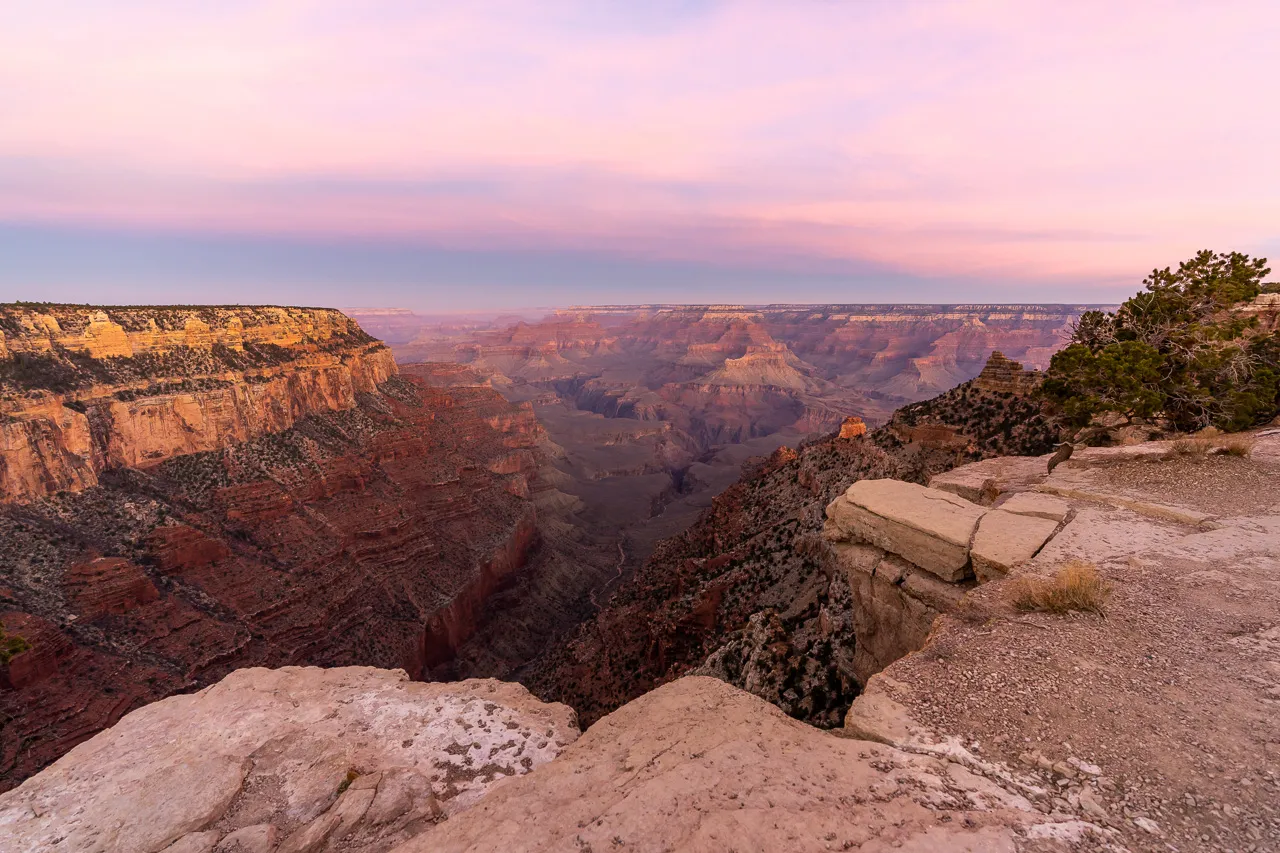
Grand Canyon National Park is one of the most photogenic landscapes in the world and in winter you have the chance to take home some truly unique images.
The first and most obvious is photographing the canyon covered in a blanket of thick white snow. But you don’t want snow like we had, which was basically snow clouds completely filling our view of the canyon. You want snow on the ground without the clouds.
Remember, you will be at Grand Canyon during the shortest days of the year. That means you don’t have to wake up too early to catch a sunrise or stay out too late to watch a sunset.
Our popular guide to the best sunrise and sunset photo spots at Grand Canyon is the perfect resource for knowing which place to be at the right time for photography.
Visibility, haziness, air quality, clouds, and natural colors of the clouds at sunrise and sunset all combine to create a landscape photographers adventure playground.
Grand Canyon Winter Photography Tips
- If you do head out early for a sunrise, make sure you have plenty of heavy layers including fingerless gloves or mittens.
- The rim alongside Mather Point is quieter and provides small shootouts you can access for clear foregrounds.
- Hopi Point gets busy at sunset so arrive early to grab your favorite spot, even in winter.
- Temperatures change very quickly once the sun comes up or goes away so prepare accordingly.
- Don’t get too close to the rim edges if there is a chance of ice.
Grand Canyon is one of the best places to visit in the USA for scenery. If you get one day with snow and another day without snow you have hit the photography jackpot.
7. What Do You Need To Pack For Grand Canyon In Winter?
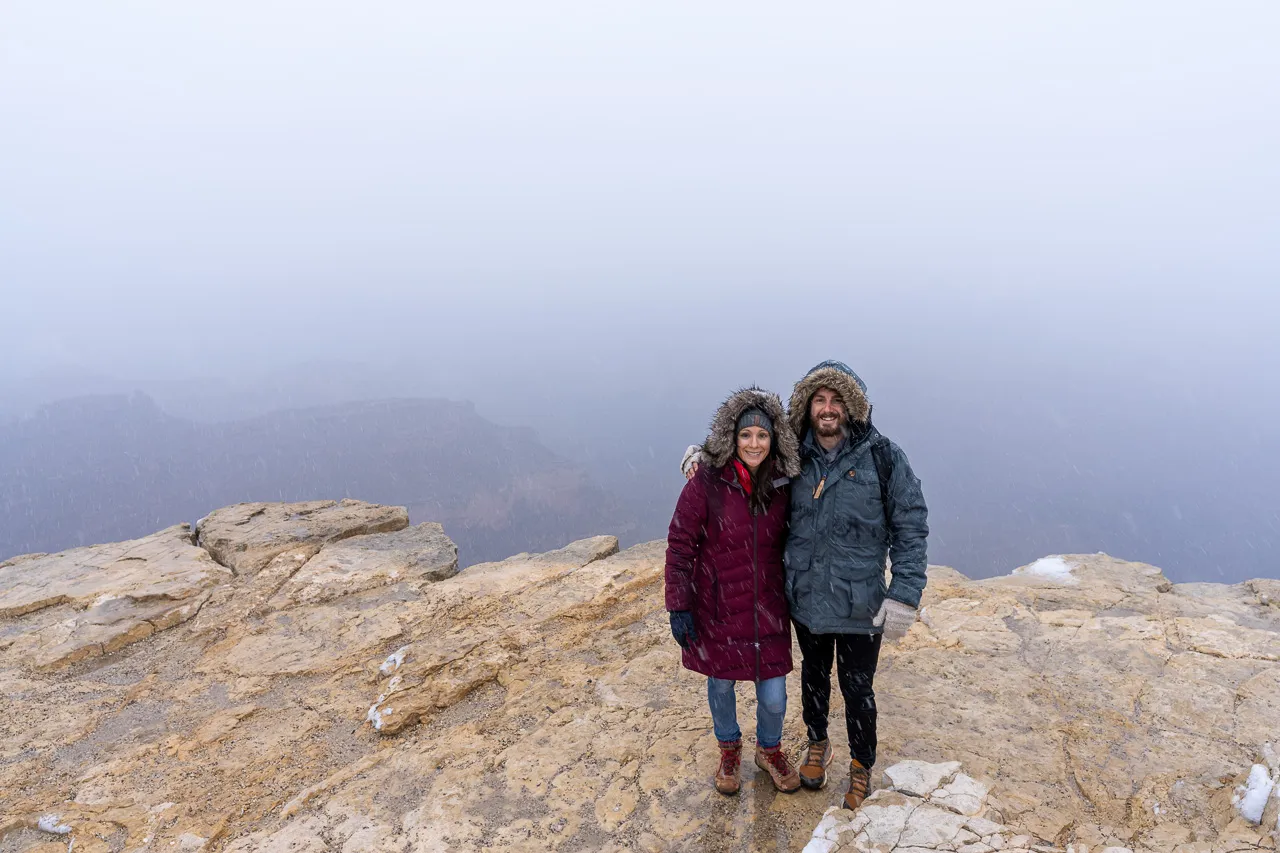
Packing for the Grand Canyon in winter can be challenging. You could pack all of your warm winter gear and it ends up being mild or you could take a risk by packing light and it ends up snowing the entire time you are at South Rim.
As you can see in the photo of us above, we have heavy coats, gloves and hiking boots on at the Grand Canyon in December because it is snowing and cold.
Yet, the day before we were hiking all day in shorts and light upper layers!
Our advice is to pack lots of layers including insulating under layers, light middle layers, thicker outer layers, rain and windproof coats, thick heavy coats and gloves.
You are going to need the warmer gear if you plan to watch sunrise or sunset.
If you want to hike you should take completely different outfits to account for mild weather or cold weather, including trail runners and hiking boots so you have options.
In essence, you should pack a lot of clothing options for every eventuality. We would rather be safe than sorry at the Grand Canyon in December, January or February.
8. Are Restaurants Open As Usual?
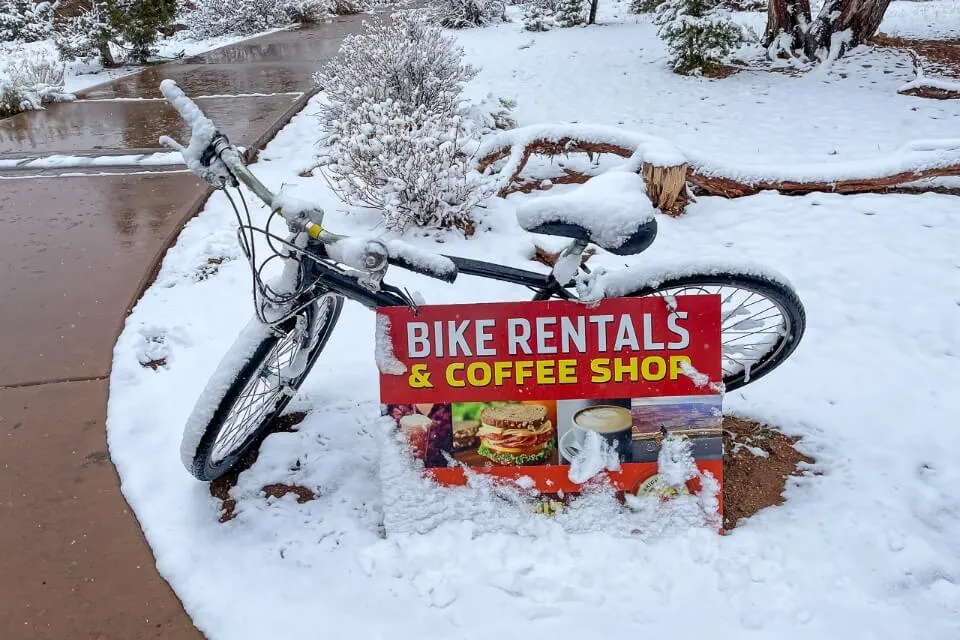
Eating out around Grand Canyon South Rim in winter is exactly the same as any other time of year. Everything is open and food is available at the lodges, restaurants and cafes.
This is just our opinion, but we have to say during both our visits to South Rim we have been disappointed by the selection of food options on offer.
Yes, it is a national park and they are usually expensive, but there aren’t really any standout restaurants or eateries anywhere around the village or even in Tusayan.
Here are the best places to eat around South Rim:
- Yavapai Lodge – Tavern with a bar for a quick pizza and a beer.
- Market and Deli – Good if you have a kitchen or campsite but it is expensive.
- Desert View Tower – Canteen style cafe for a light lunch.
- Tusayan – A dozen options including typical fast food but none are rated very highly.
- Williams or Flagstaff – Excellent food selections but are an hour away from South Rim.
With that said, the important thing is that all available food options will remain open for your Grand Canyon winter itinerary.
9. Is Grand Canyon North Rim Open In Winter?
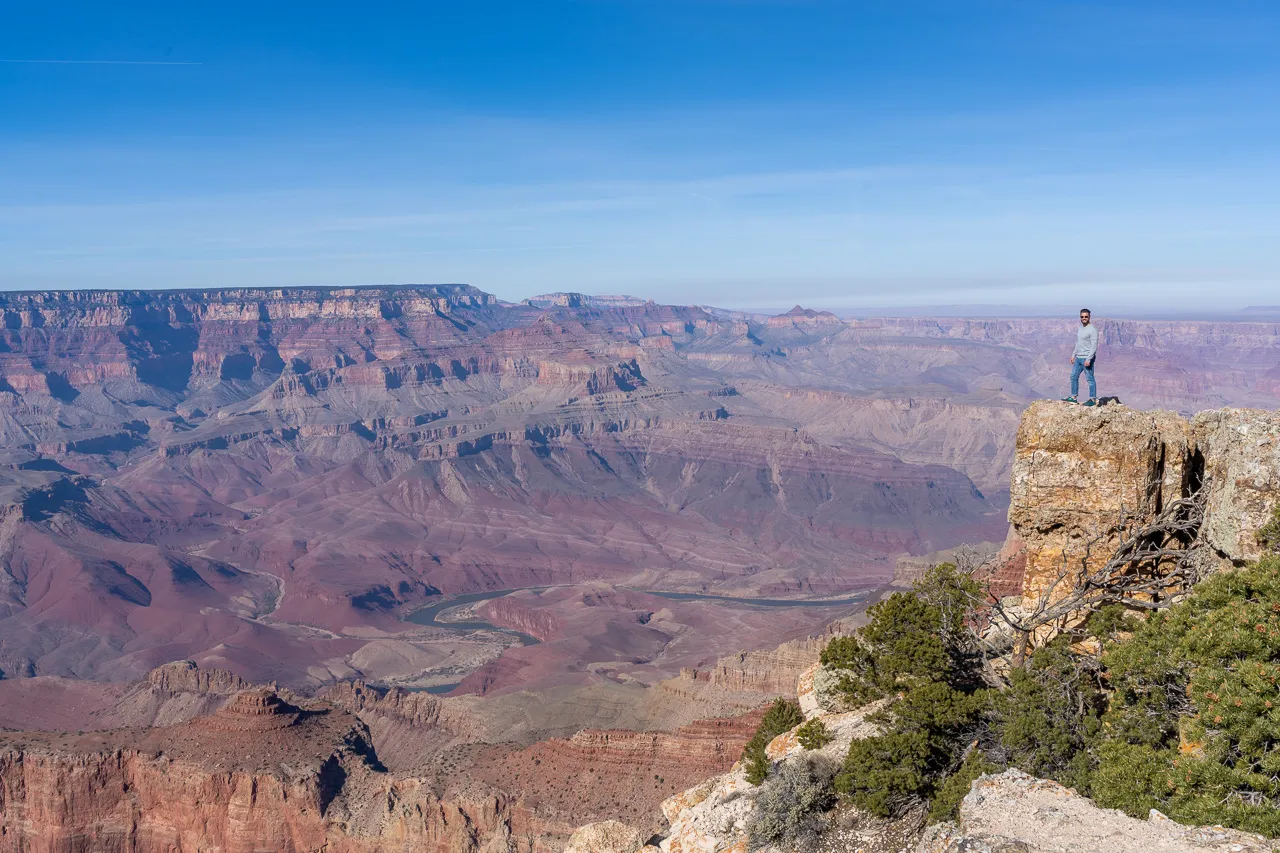
You cannot visit Grand Canyon North Rim in winter because it is closed. In fact, North Rim is only open for 4.5 months of the year in 2023 from the beginning of June until the middle of October.
Did you know that roughly only 10% of all visitors to Grand Canyon National Park step foot on North Rim?
Let’s say that 5 million people visit Grand Canyon in 2023. That means only 500,000 will make it to North Rim in the 4 and a half months it is open.
So far we haven’t been able to make it to North Rim because it has been closed both times we have been in the area. However, we think it would be an incredible experience so we fully intend to visit the 8,000ft high North Rim at some point soon.
If you typically prioritize keeping clear of the crowds, you should head over to North Rim. Just don’t do it in winter!
10. Are There Any Grand Canyon Christmas Activities For Kids?
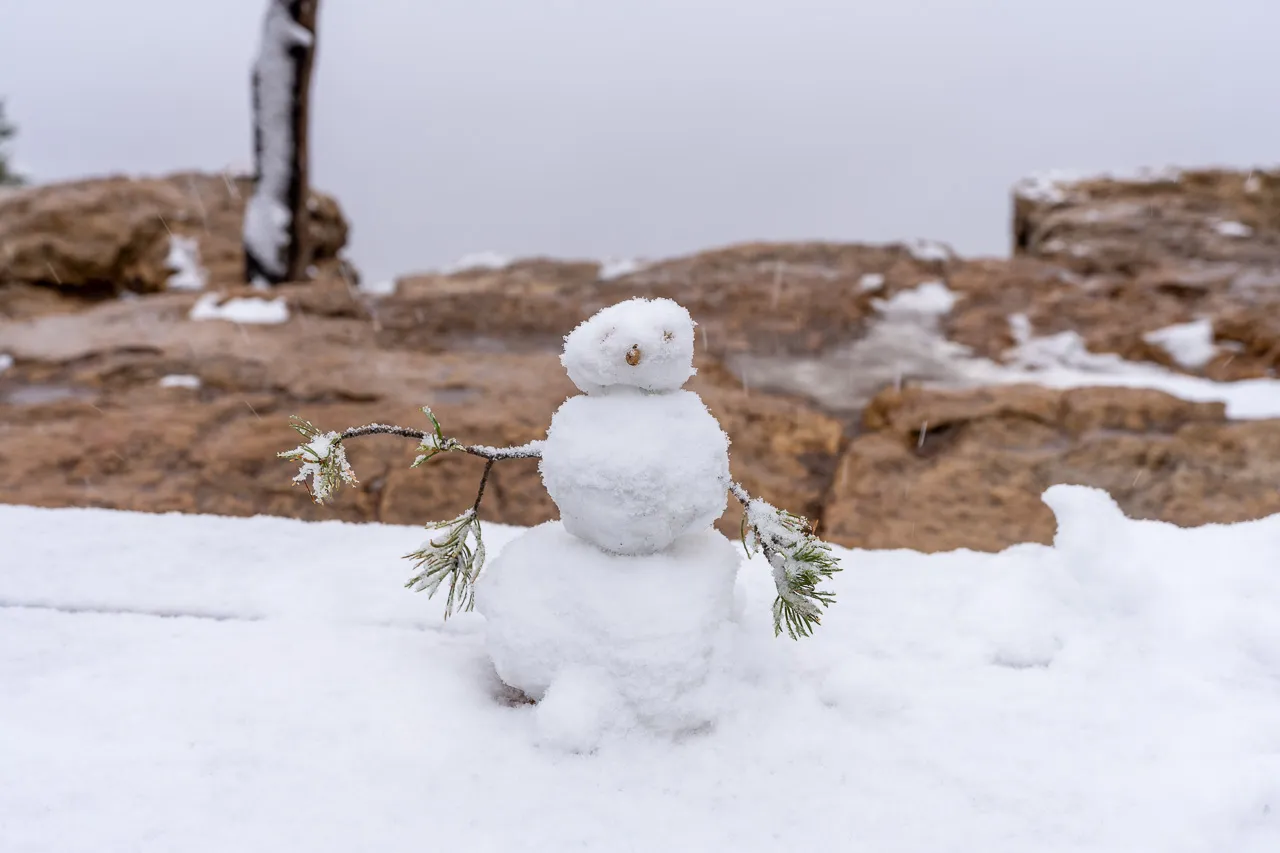
Are you visiting the Grand Canyon at Christmas with your family?
Do not miss the chance to ride the night time Polar Express from Williams to the North Pole (or Grand Canyon South Rim depot)!
The popular child friendly train ride leaves at 5.30pm and 7.30pm from Williams with a total trip time of approximately 90 minutes.
Tickets are fairly pricey beginning at $57 per adult and $38 per child (and that’s if you book early) but it is family fun at its festive finest around the magical Grand Canyon South Rim.
Read more about the Polar Express train ride .
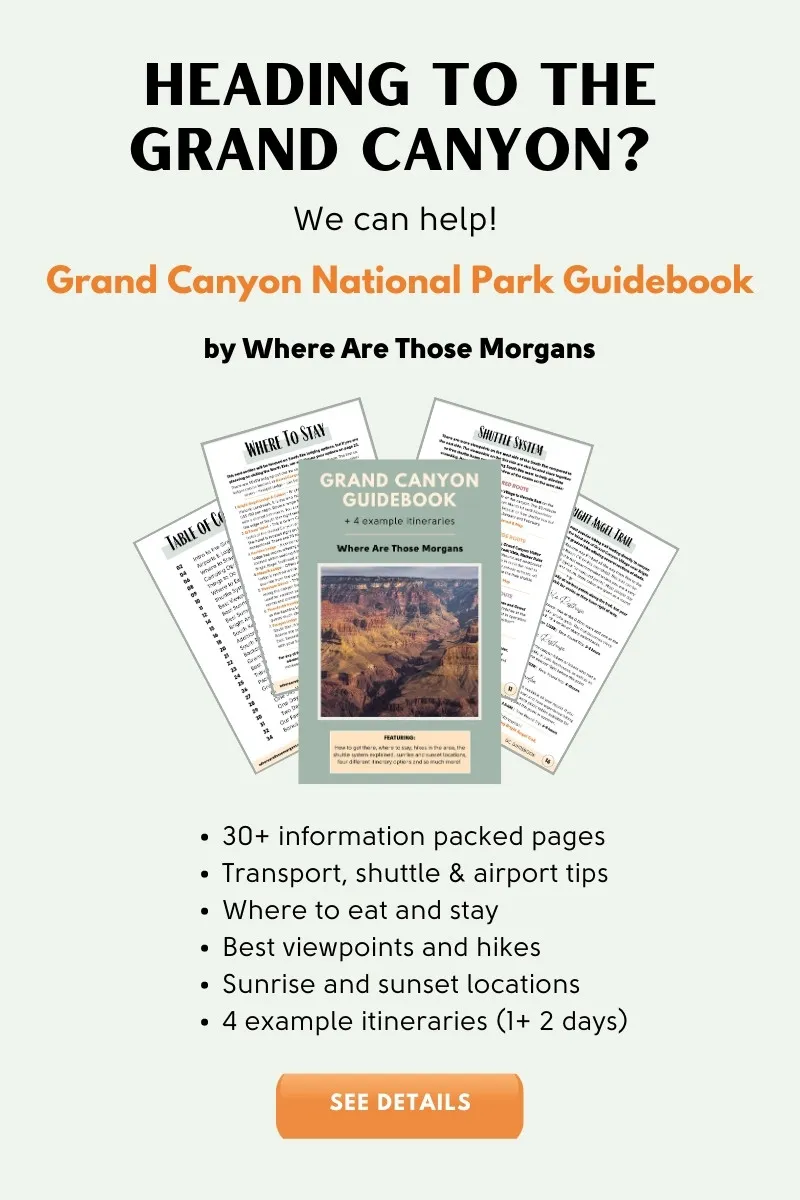
Our Popular Grand Canyon Guides
- Best Hikes – 17 best day hikes at Grand Canyon South Rim
- Day Hike – South Kaibab to Bright Angel Trail
- Hotels – Where to stay at Grand Canyon South Rim
- Itinerary – Grand Canyon National Park one day itinerary
- Photography – Best Grand Canyon sunrise and sunset photo spots
- Season – Best time of year to visit the Grand Canyon
- Transport – Best airports near Grand Canyon National Park
- Viewpoints – Best Grand Canyon South Rim viewpoints
More Winter Destinations
- Death Valley – What you need to know about Death Valley in December
- NYC – Ultimate guide to visiting New York City in winter
- Sedona – What you need to know about visiting Sedona in December
- Zion – 10 things to know about visiting Zion in winter
Want more Arizona content? Head over to our Arizona Travel Guides to explore the best of Grand Canyon, Sedona and beyond.
We hope this guide helps with planning your visit to Grand Canyon National Park in winter!
Please let us know if you have any questions or need help planning your winter trip to Grand Canyon National Park!
Happy Travels ,
Mark and Kristen
Find This Guide Helpful? Pin It For Your Visit!
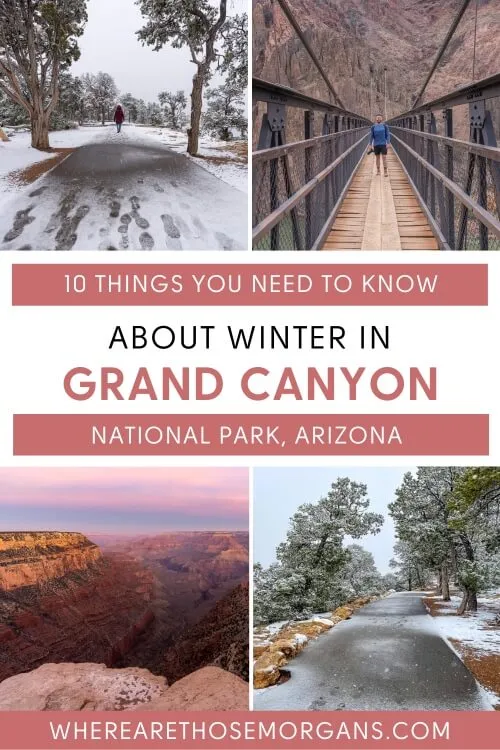
Note : This article contains affiliate links. When you make a purchase using one of these affiliate links, we may earn a small commission at no extra cost to you.
All Rights Reserved © Where Are Those Morgans, LLC. Republishing this article and/or any of its contents (text, photography, maps, graphics, etc.) in whole or in part is strictly prohibited.
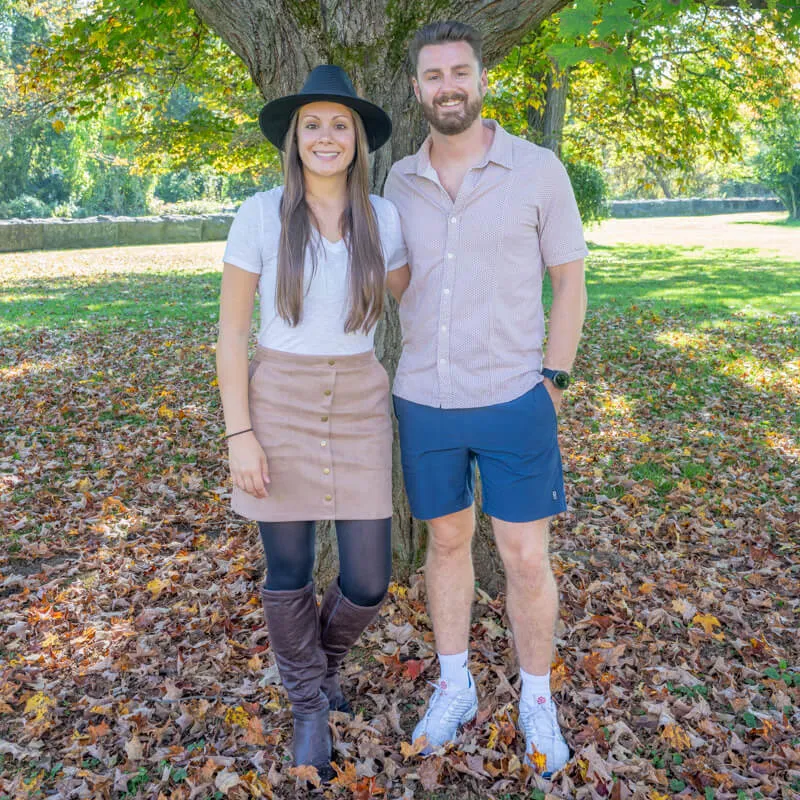
Mark and Kristen Morgan are travel, hiking and photography experts. Over the last 6 years traveling full time, they have explored more than 40 countries and 30 US states.
Where Are Those Morgans has been featured in USA Today, Gestalten, Get Your Guide, CityPASS and Condé Nast Traveler along with various other publications. Read more about us .
Leave a Comment Cancel reply
Subscribe to our newsletter
Get the latest in travel straight to your inbox
Click here to subscribe
- Skip to global NPS navigation
- Skip to this park navigation
- Skip to the main content
- Skip to this park information section
- Skip to the footer section

Exiting nps.gov
Alerts in effect, things to do.
Last updated: April 21, 2024
Park footer
Contact info, mailing address:.
PO Box 129 Grand Canyon, AZ 86023
928-638-7888
Stay Connected
3-day flood experiment begins at Grand Canyon to improve Colorado River conditions
The goal is to move accumulated sediment downstream and begin to rebuild beaches on the river that have eroded in recent years..

PHOENIX – Federal officials on Monday began three days of high water flows from Lake Powell to help improve environmental conditions on the Colorado River through the Grand Canyon.
The goal is to move accumulated sediment downstream and begin to rebuild beaches on the river that have eroded in recent years. It's the first such high-flow experiment at the dam since 2018 and the first during spring runoff season.
The engineered flood, which began when the Bureau of Reclamation opened bypass tubes at Glen Canyon Dam early Monday, mimics some of the river's pre-dam flows, when snowmelt runoff from the mountains far upstream would raise water levels and redistribute sediment. Since Glen Canyon Dam's completion in 1963, the water flowing into the Grand Canyon has carried less sediment, much of the river's sand and other materials trapped behind the dam.
Releasing more water from Lake Powell won't change the total amount of water that flows through the system this year, bureau officials said. The water will arrive at Lake Mead earlier than it would have otherwise and remain there until it's needed downstream.
America's 10 most endangered rivers 2023: See which waterways are most at-risk
Grand Canyon's North Rim will open later than usual this year: Here's when and why
How the flood was started
Dam operators began raising water flows early Monday, first through the power plant turbines and then through bypass tubes on the side of the dam. By mid-morning, water gushed from the tubes into the river at the dam's base, the start of a journey downstream through the Grand Canyon toward Lake Mead.
The amount of water released will fluctuate over the three days, but the bureau said the high flows will peak at about 39,500 cubic feet per second, or as much as quadruple the average output from the dam. The water releases will return to normal operations by Thursday.
Grand Canyon rafters, hikers urged caution
The National Park Service is alerting river rafters, hikers and others who might be in the Canyon this week that Colorado River flows will ramp up sharply during the experiment.
"At higher flows, some normally difficult rapids might decrease in their technical difficulty, and other rapids might become more technically challenging," the park service said in a statement. "River runners are advised to scout rapids to check for new features, and ensure rapids are clear of boats or swimmers."
Encouraging 2023 outlook for Colorado River, Lakes Mead and Powell
The high flows began just days after the bureau released new figures that projected improving conditions for water storage on the Colorado River, which is currently operating under shortage guidelines . Forecasters now say runoff into Lake Powell from April through July could total as much as 177% of the long-term average.
Earlier this year, Lake Powell and Lake Mead, the two largest reservoirs on the river, sat at barely one-quarter full, drained by more than two decades of drought and continued high use by more than 40 million people in seven states.
The new projections estimate Oct. 1 water levels at Lake Powell will be almost 50 feet higher than Oct. 1 of last year. This October, Lake Mead levels are projected to start about 22 feet higher than last fall, though that's still about 160 feet below what's considered capacity.
“This winter’s snowpack is promising and provides us the opportunity to help replenish Lakes Mead and Powell in the near-term – but the reality is that drought conditions in the Colorado River Basin have been more than two decades in the making,” said Reclamation Commissioner Camille Calimlim Touton.
“Despite this year’s welcomed snow, the Colorado River system remains at risk from the ongoing impacts of the climate crisis. We will continue to pursue a collaborative, consensus-based approach to conserve water, increase the efficiency of water use, and protect the system’s reservoirs from falling to critically low elevations that would threaten water deliveries and power production.”
More beach access in Grand Canyon
The high-flow experiment, if successful, should help rebuild beaches along the river and create natural backwaters for fish. Eroded beaches have left hikers and river rafters with fewer options to camp.
An active monsoon last year moved tons of sand and sediment toward the river through tributaries like the Paria River, but runoff from the storms also gouged deeper cuts into the beaches downstream. The higher flows this week are intended to move some of the sediment downstream and deposit it along the way.
“It’s a happy day,” said Lynn Hamilton, executive director of Grand Canyon River Guides, a river recreation advocacy group. “I’m sure the river-running community will be happy to have beaches to camp on this season.”
Will flood experiment affect animals?
The effects on fish and other wildlife are less certain since past experiments have occurred later in the year. Jim Strogen, president of Trout Unlimited’s Gila Trout Chapter, said the high flows could help reduce populations of the invasive brown trout around Lees Ferry. Brown trout spawn in fall and winter, and forcing the eggs or young out from spawning areas could help limit their numbers.
But environmental advocates say the flood could draw more smallmouth bass from Lake Powell into the Colorado River, threatening imperiled native species like the humpback chub.
Taylor McKinnon, southwest director for the Center for Biological Diversity, said releasing water too early in the season – and before nets or other barriers are put in place near the dam – could create conditions favoring the invasive bass.
Researchers discovered bass near Lees Ferry last year , downstream from Glen Canyon Dam near the top of the Grand Canyon. Scientists say low water levels in Powell enabled the bass to slip past the turbines and warmer water temperatures allowed the invaders to survive in the river.
Environmental coverage on azcentral.com and in The Arizona Republic is supported by a grant from the Nina Mason Pulliam Charitable Trust. The Arizona Republic is part of the USA TODAY Network.

IMAGES
COMMENTS
The Grand Canyon is a large park and due to the nature of the canyon landscape, the weather varies greatly between the rims of the canyon and inside the gorge itself. The average high at the South Rim in January is 44 degrees Fahrenheit, and the average low is 18 degrees Fahrenheit (high of 6.6 degrees Celsius, low -7.7 degrees Celsius.)
Colder temperatures, shorter days, and snow bring a slower pace to one of the nation's most visited national parks. After the December holidays, during January and February, winter visitors find paths less traveled throughout the park. Those prepared for ice and snow will find the inner canyon trails a bit quieter and scenic drives less congested.
You can also use the Grand Canyon self guided tour to learn more about the Grand Canyon when you visit. Weather in the Grand Canyon in January. In January, the daytime maximum temperature is 58 degrees Fahrenheit (14 degrees Celsius), while the overnight minimum is 34 degrees Fahrenheit (1 degree Celsius). The Grand Canyon covers a huge area ...
South Rim Visitor Center. April 7 - April 20: Open 5 days/week, 10 am to 4 pm [Closed Tuesday/Wednesday] April 21 - May 4: Closed for staff Training. May 5 - May 23: 8 am to 3 pm daily. The North Rim is CLOSED for the winter. The North Rim is scheduled to open for the 2024 season on May 15, 2024.
The average lows in December, January, and February are 18 F (-8°C) and average highs are 45 F (8°C). At the same time, it can be around 60 F (15 °C) on the canyon floor. The weather can change quickly in winter, and so does visibility, so be sure to check the weather forecast when planning your visit.
Grand Canyon Celebration of Art (September-January) December-February This is by far the most peaceful season at the Grand Canyon, so if you're looking for a calm, quiet visit, this is the time to go.
Grand Canyon weather in winter can be freezing and windy, so be prepared. In December and January, average daytime temperatures reach 7°C and drop to -8°C at night. February is slightly warmer, with a slight temperature uptick, but it will still be in the single digits.
Grand Canyon National Park, in Northern Arizona, encompasses 278 miles (447 km) of the Colorado River and adjacent uplands. Located on ancestral homeland of 11 Associated Tribes, Grand Canyon is one of the most spectacular examples of erosion anywhere in the world—unmatched in the incomparable vistas it offers visitors from the rims. The South Rim is open. The North Rim is CLOSED for the winter.
January is considered part of the winter season at the Grand Canyon, and with that comes the possibility of precipitation. On average, the Grand Canyon receives around 1.55 inches (3.9 cm) of snowfall during January. However, it's essential to check the forecast before your trip, as snowfall can vary from year to year.
Icy Trails. With limited daylight, cold nighttime temperatures, and limited sunlight in the deep canyon during the winter, icy trails are definitely the largest hazard in winter in the Grand Canyon. Many of the most popular trails remain open year-round. It's not uncommon to have clear, dry trails because of the sun exposure.
Outside our lunch spot. 5. Do a short hike*. If you want to stretch your legs at the Grand Canyon, you absolutely can, even in the winter. The easiest hike is to do a section of the Rim Trail, which stretches more than 12 miles from Hermit's Rest all the way to the South Kaibab Trailhead.
Best Time to Visit. Most people visit Grand Canyon National Park between late May and early September. June, July, and August tend to be the busiest months. The quieter "shoulder seasons" run ...
Yes, it does get cold in the Grand Canyon in January. January and February are the coldest months. During the day it is in the 40s and 50s but at night it can get well below freezing. There will be snow and at some point in the month there will be around 10 inches of snow in the village.
The South Rim is the most widely recognized area of the Grand Canyon, with the greatest number of viewpoints, visitor services, and hotels. More than 1,000 feet higher, the North Rim gets a good ...
With the kids out of school, summertime is undoubtedly the busiest time of year, making peak season at Grand Canyon between June-August. If you're staying during this time, be sure to book your lodging early, as reservations start filling up nine months to a year in advance. For cooler weather, lighter crowds and better lodging availability ...
Winter Hiking. Every year, scores of unprepared hikers, lured by initially easy downhill hiking, experience severe illness, injury, or death from hiking in the canyon. Travel in Grand Canyon National Park's backcountry has inherent risks and involves unavoidable hazards. Your safety depends upon your judgment, your experience, and a realistic ...
Weather in the Grand Canyon in January is definitely the deep of winter, but the average high temperature still hovers in the mid-40s at the South Rim. Be prepared for snow, since January sees the highest snowfall averages in the Grand Canyon. ... Just be sure to check the weather regularly if you plan to visit the Grand Canyon in winter since ...
Bright Angel Trail. Distance 12 miles / Elevation 2900 ft / Time all day. You can get much closer to the Colorado River on a day hike along Bright Angel Trail! The Bright Angel Trail is one of the two most popular hiking trails into Grand Canyon, and in winter it's a possible option for a very strenuous day trip.
South Rim - 58 inches. North Rim - 145 inches. Phantom Ranch - 1 inch. Grand Canyon South Rim receives around 90% of all tourists to the national park. Part of that reason is because Grand Canyon North Rim is closed for the winter season because it gets hit with so much more snow in December, January and February.
Grand Canyon Rock Layers (Layer Cake) Grand Canyon proudly displays layers of many colors including red, yellow and chocolate. She is a layer cake for the eyes. If you visit Grand Canyon in the winter, stick with this theme. Pack plenty of layers. The temperatures can vary with large swings from sunrise to sunset.
The best time to visit Grand Canyon National Park is October. Sure April and May are great months to visit the Grand Canyon, but October is when it all really comes together. Yes, October is where the magic happens at the Grand Canyon. This goldilocks month brings together the perfect mix of pleasant weather, fewer visitors, and beautiful scenery.
Desert View Drive. Visitors traveling to Grand Canyon National Park can enter and exit the park through the East Entrance at Desert View. (State Route 64 - also known as the East Rim Drive) This 23 mile (37 km) road, leaves Grand Canyon Village, then travels east to Desert View. and the East Entrance Station. This is the only scenic road on the South Rim that is open to private vehicles all year.
3-day flood experiment begins at Grand Canyon to improve Colorado River conditions The goal is to move accumulated sediment downstream and begin to rebuild beaches on the river that have eroded in ...